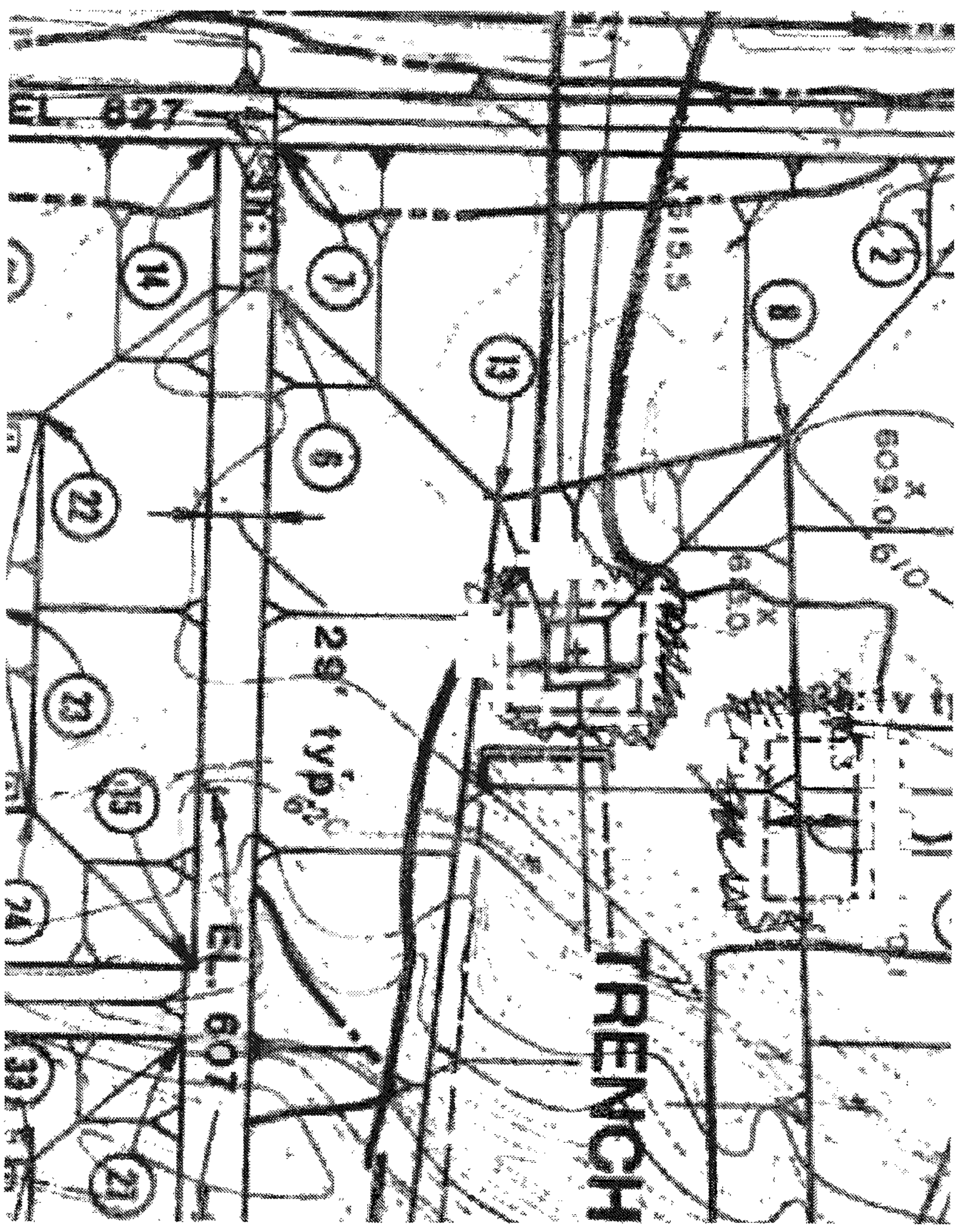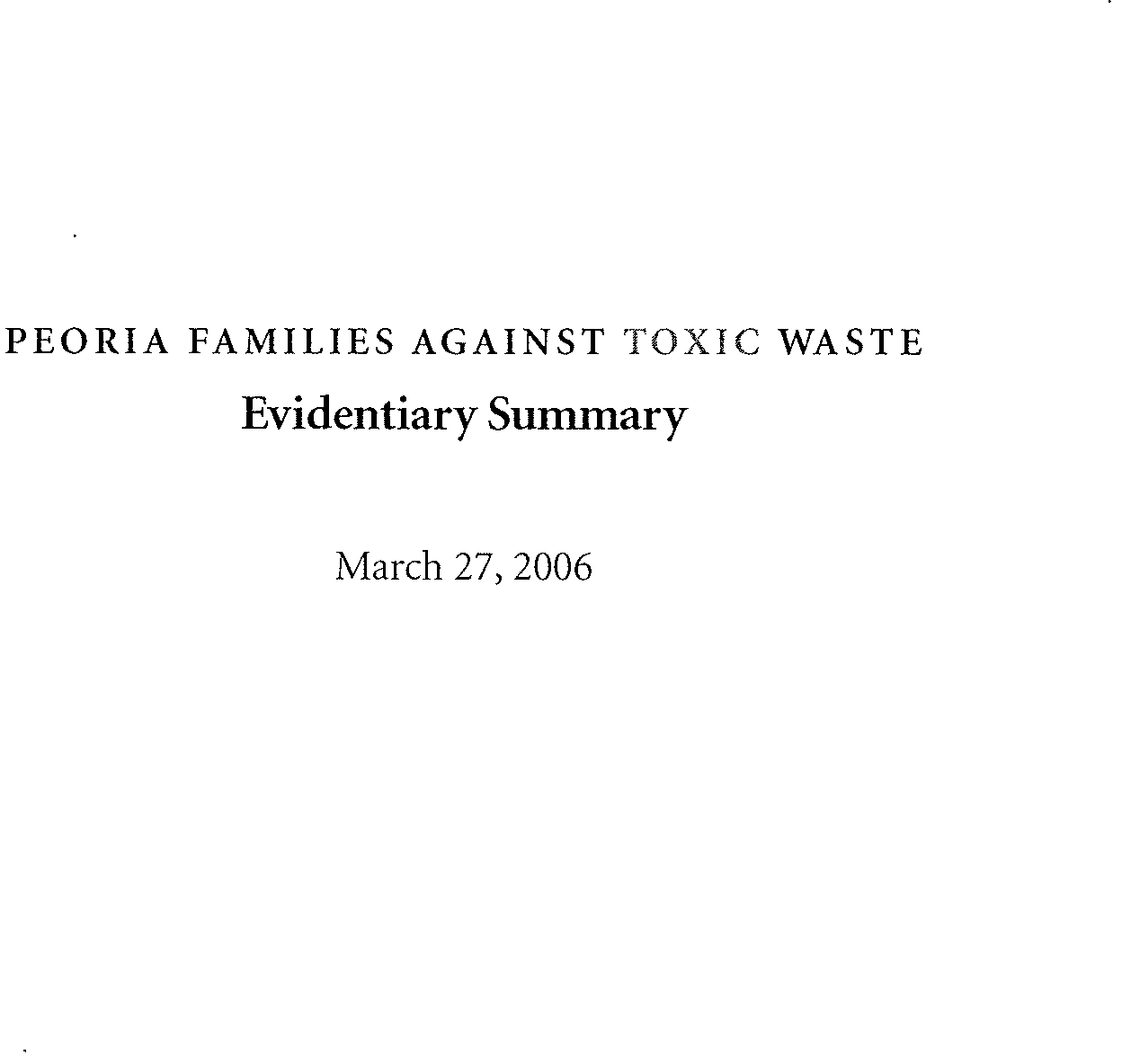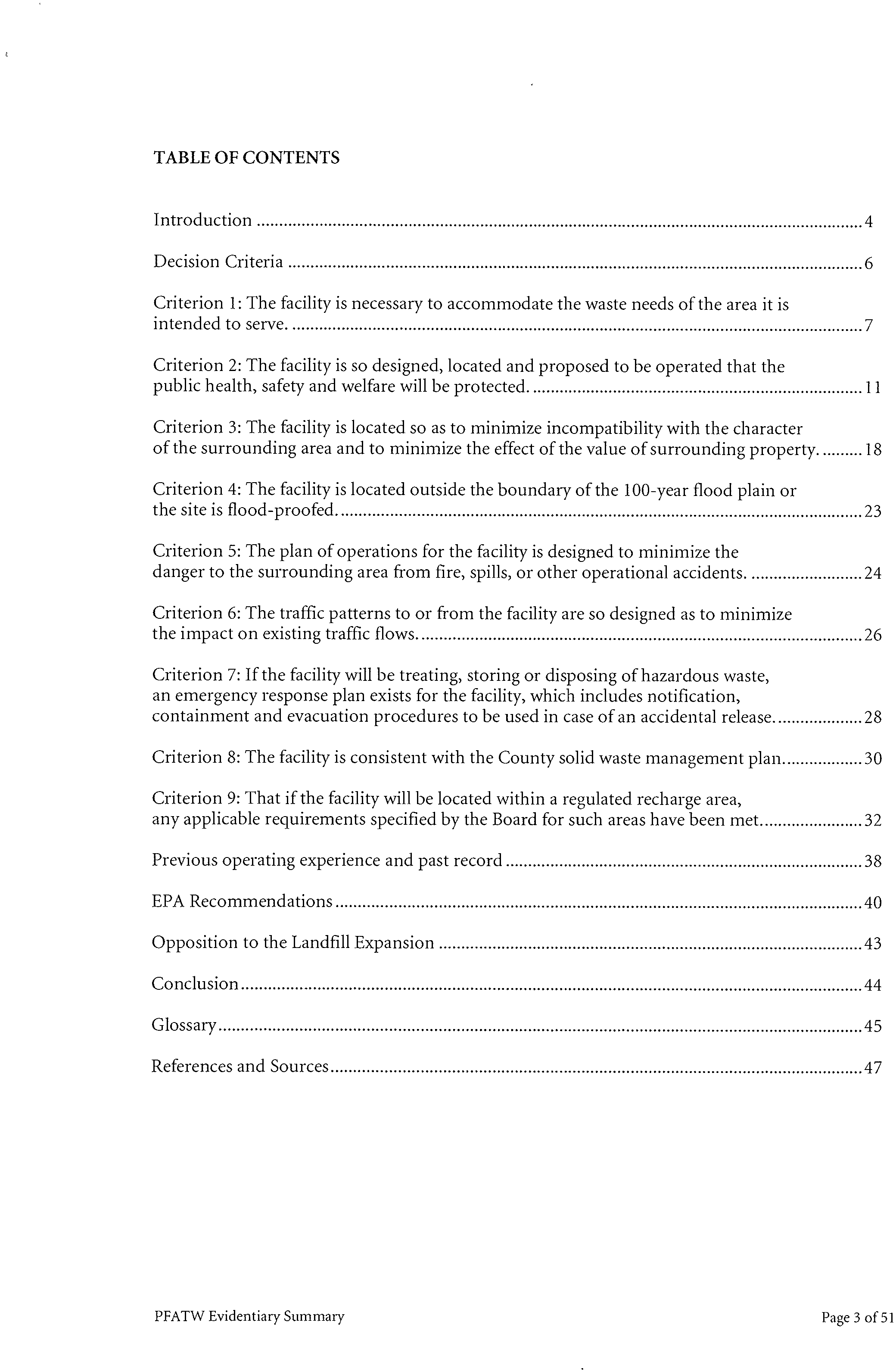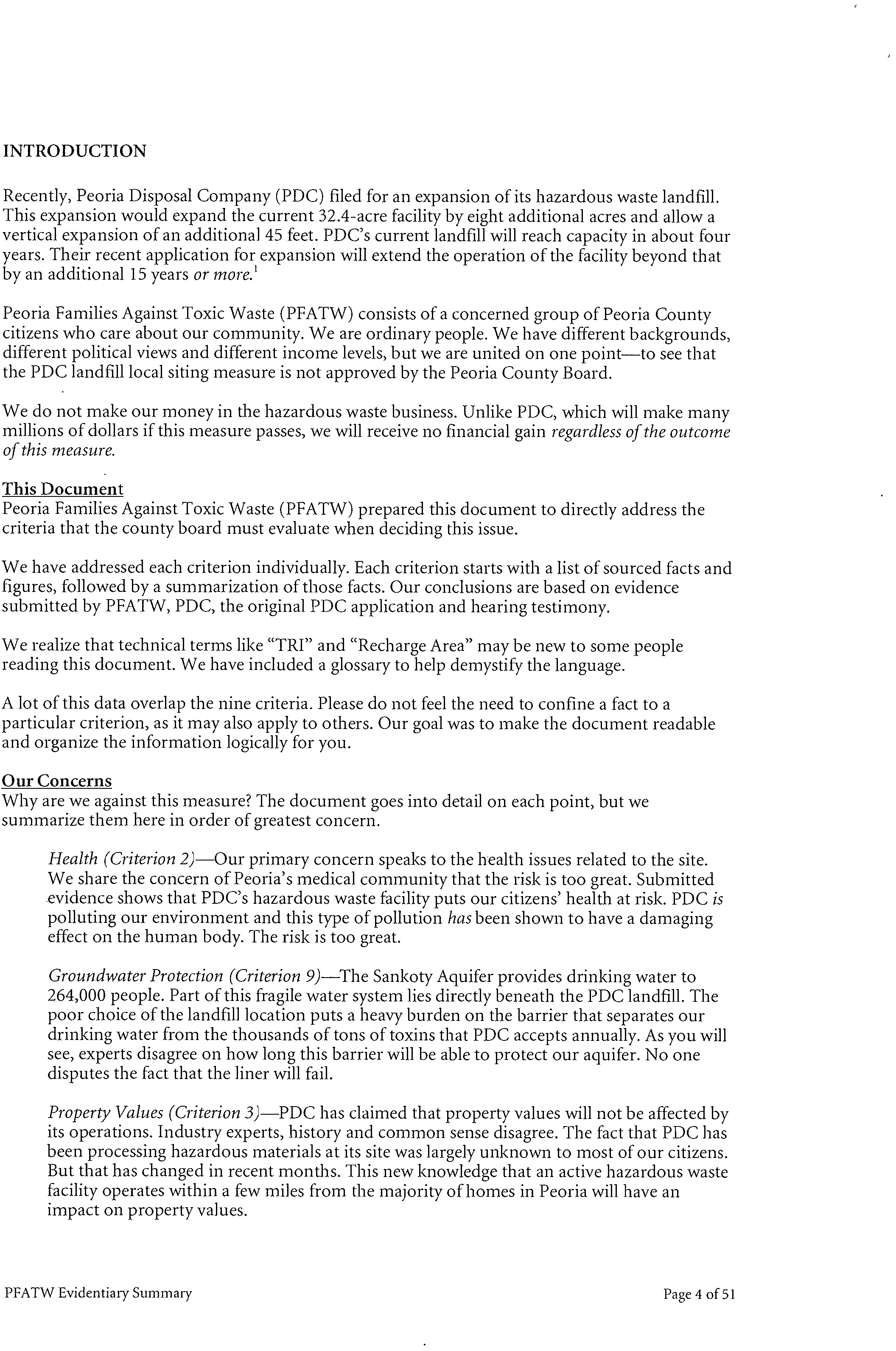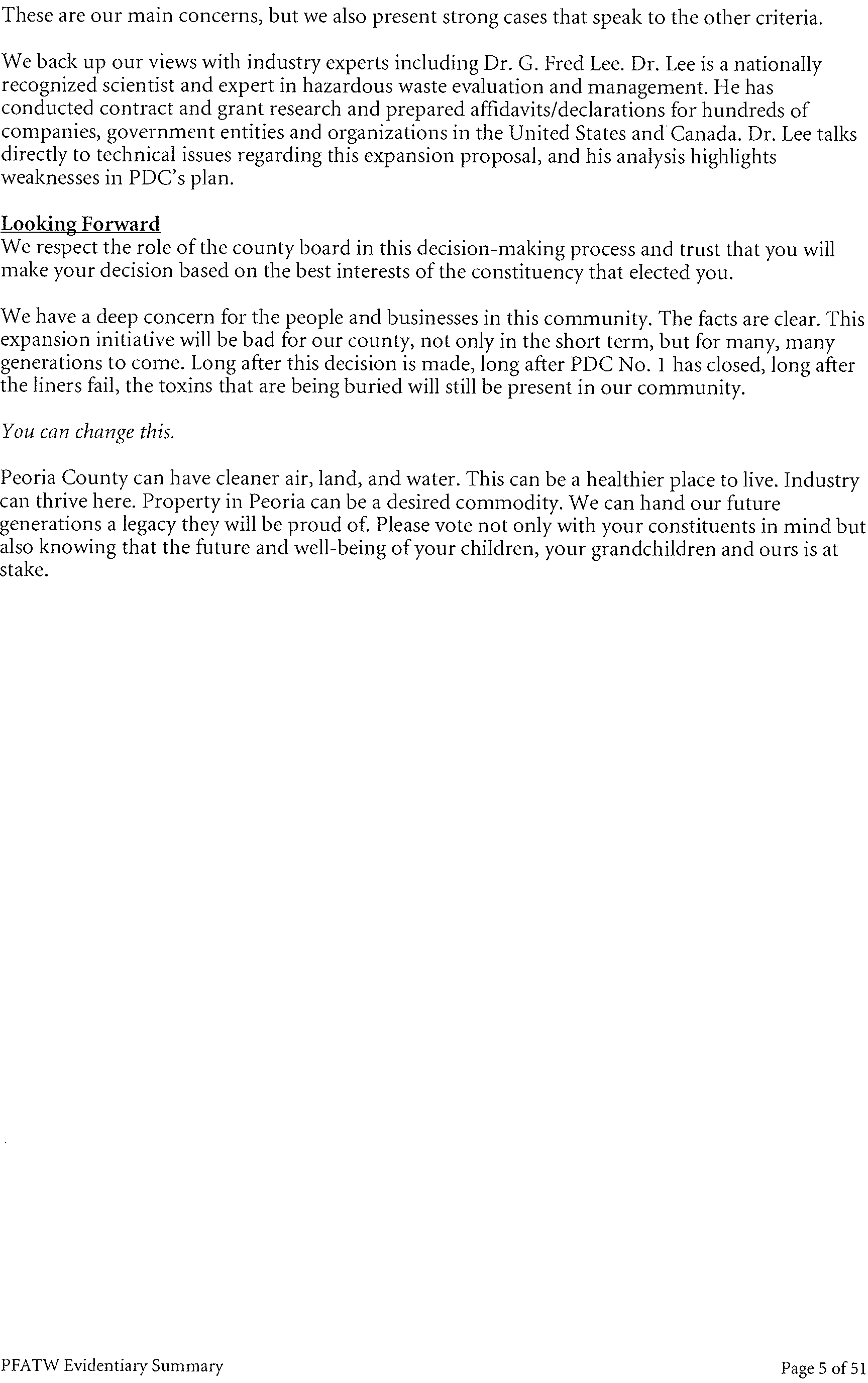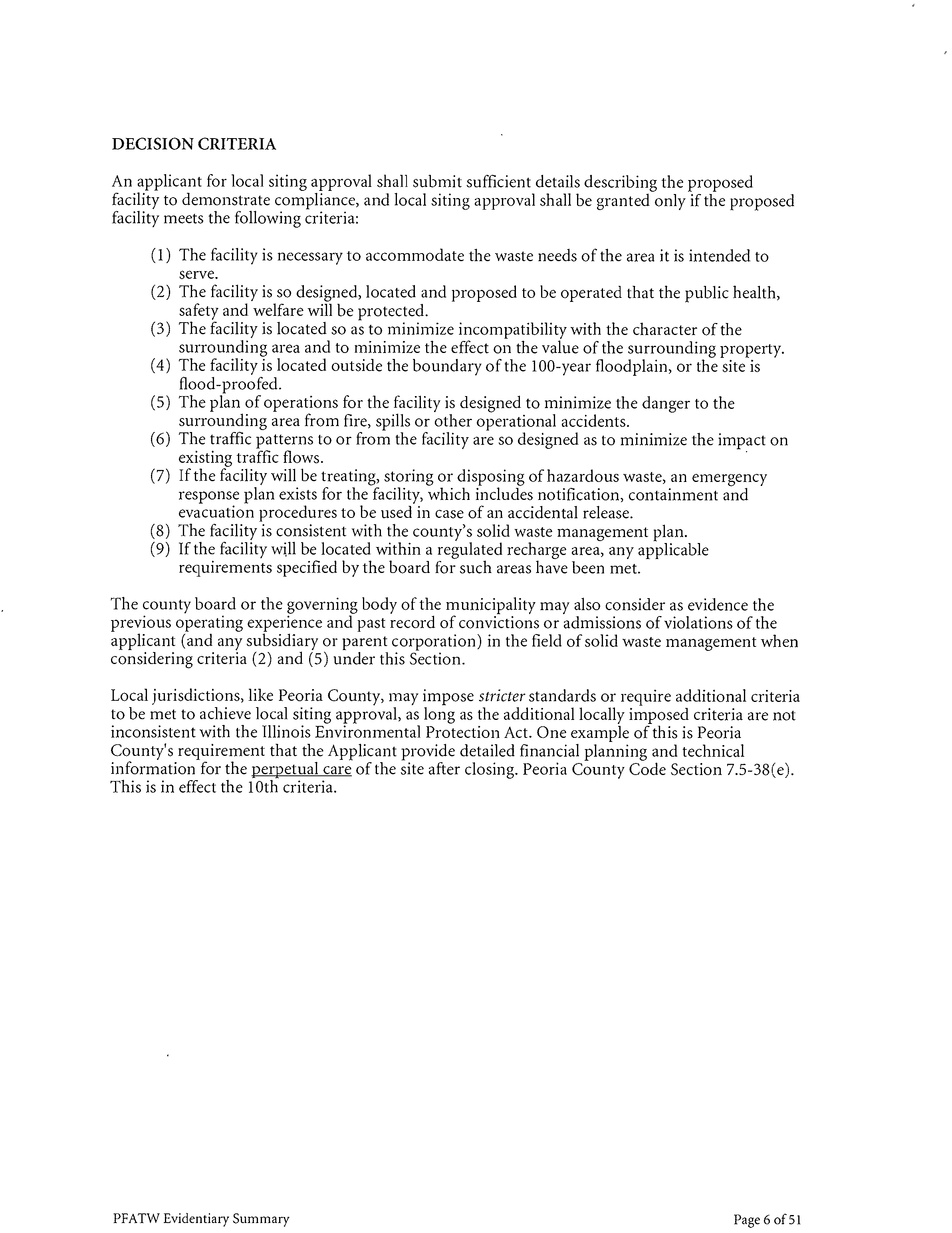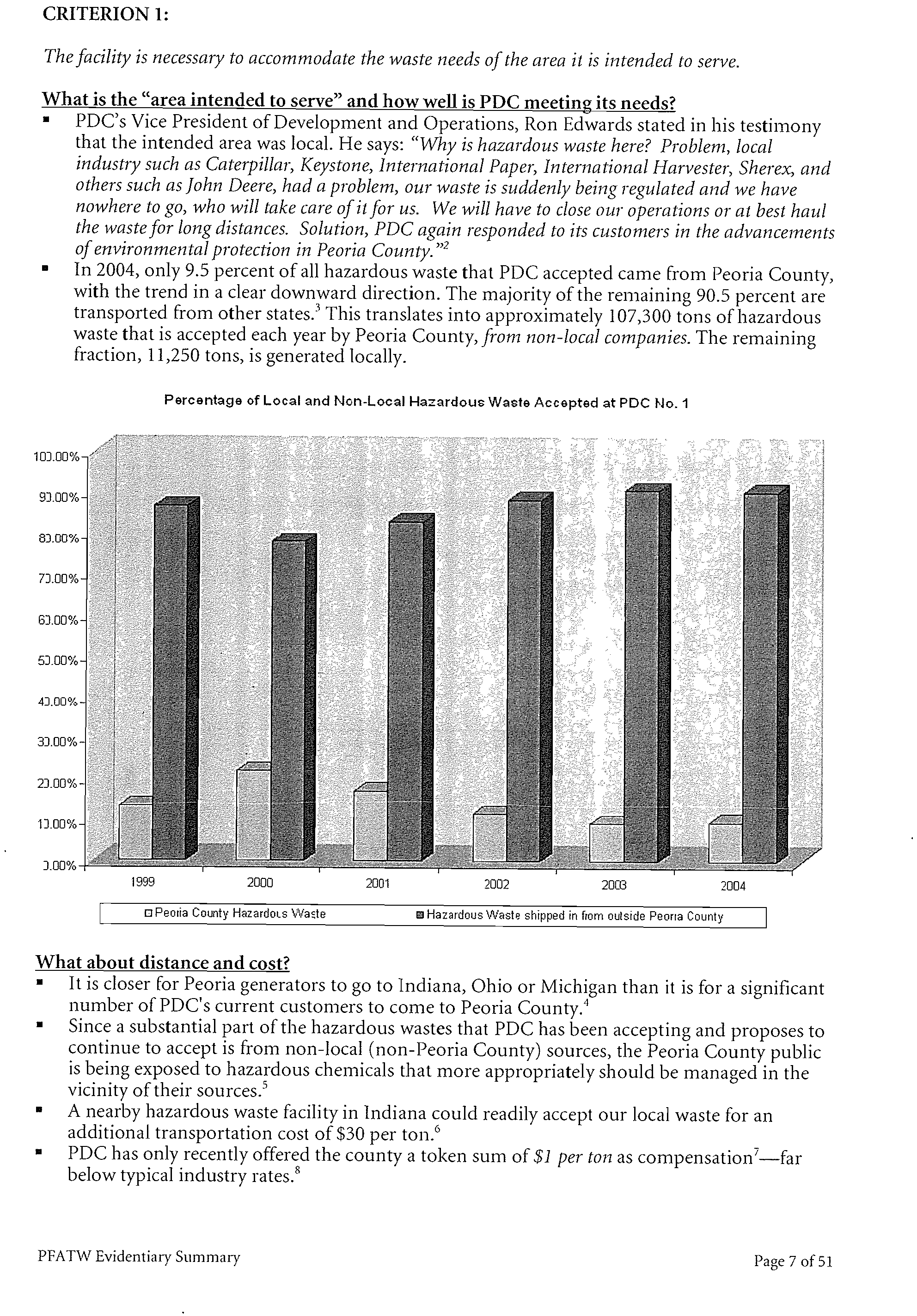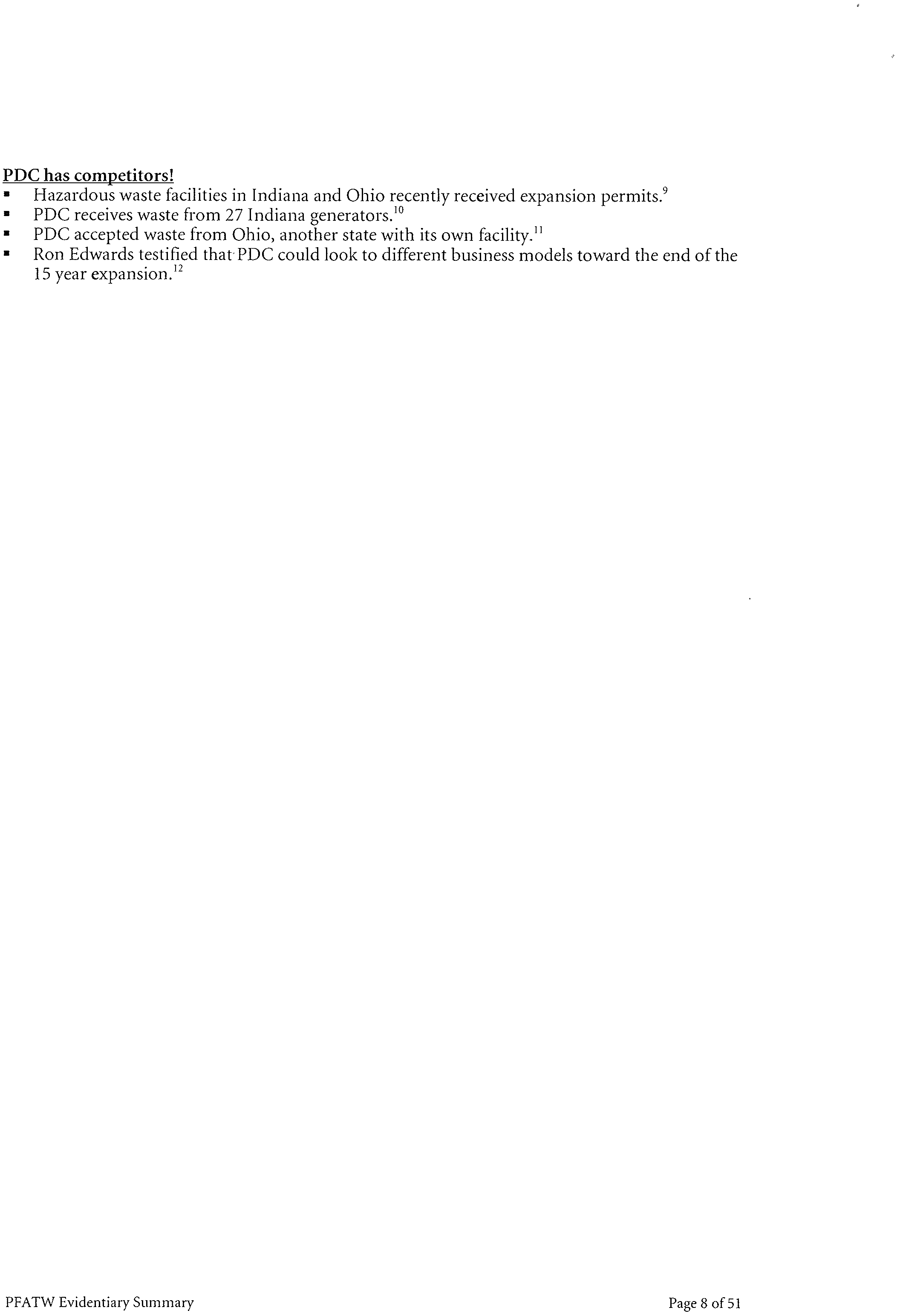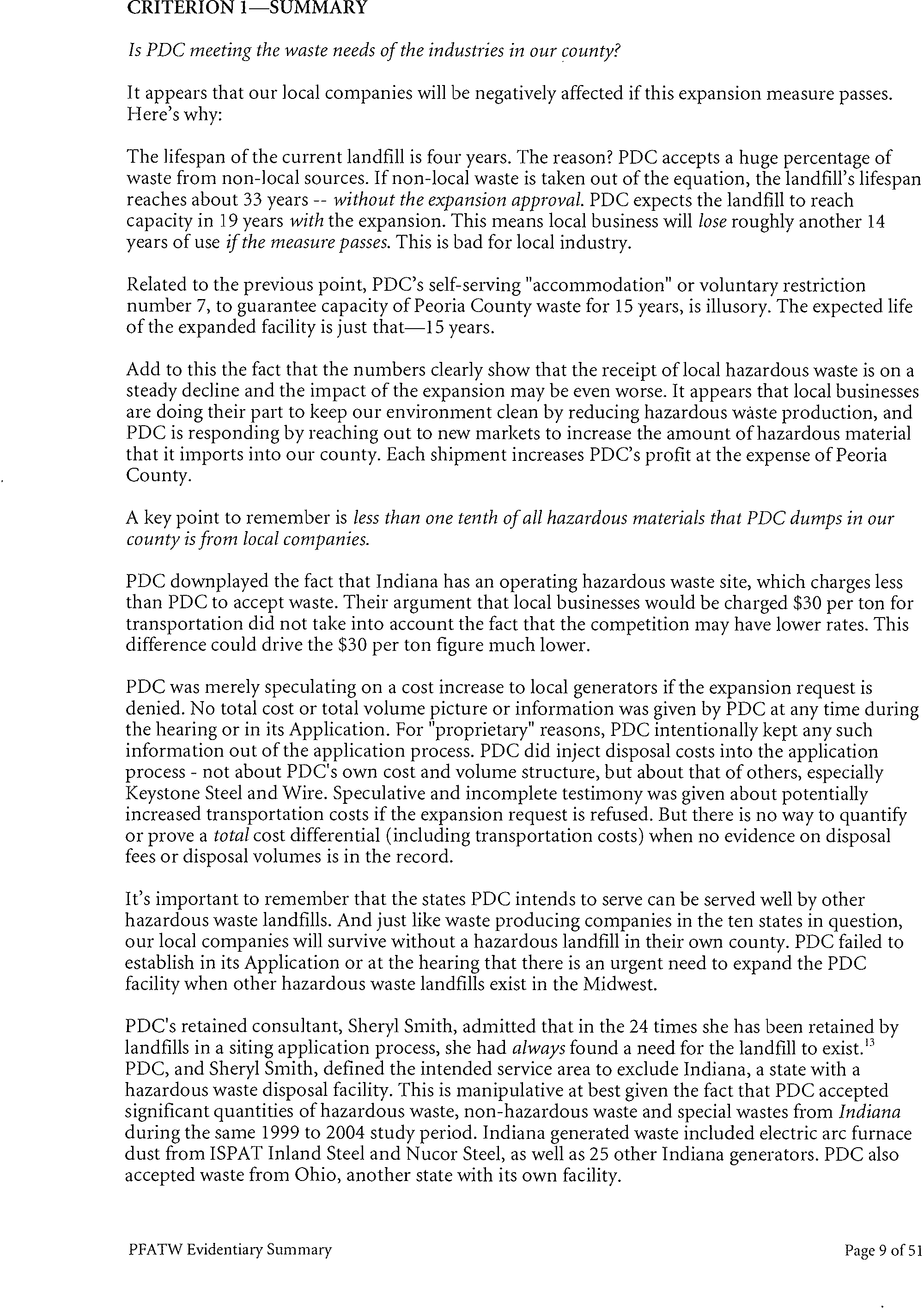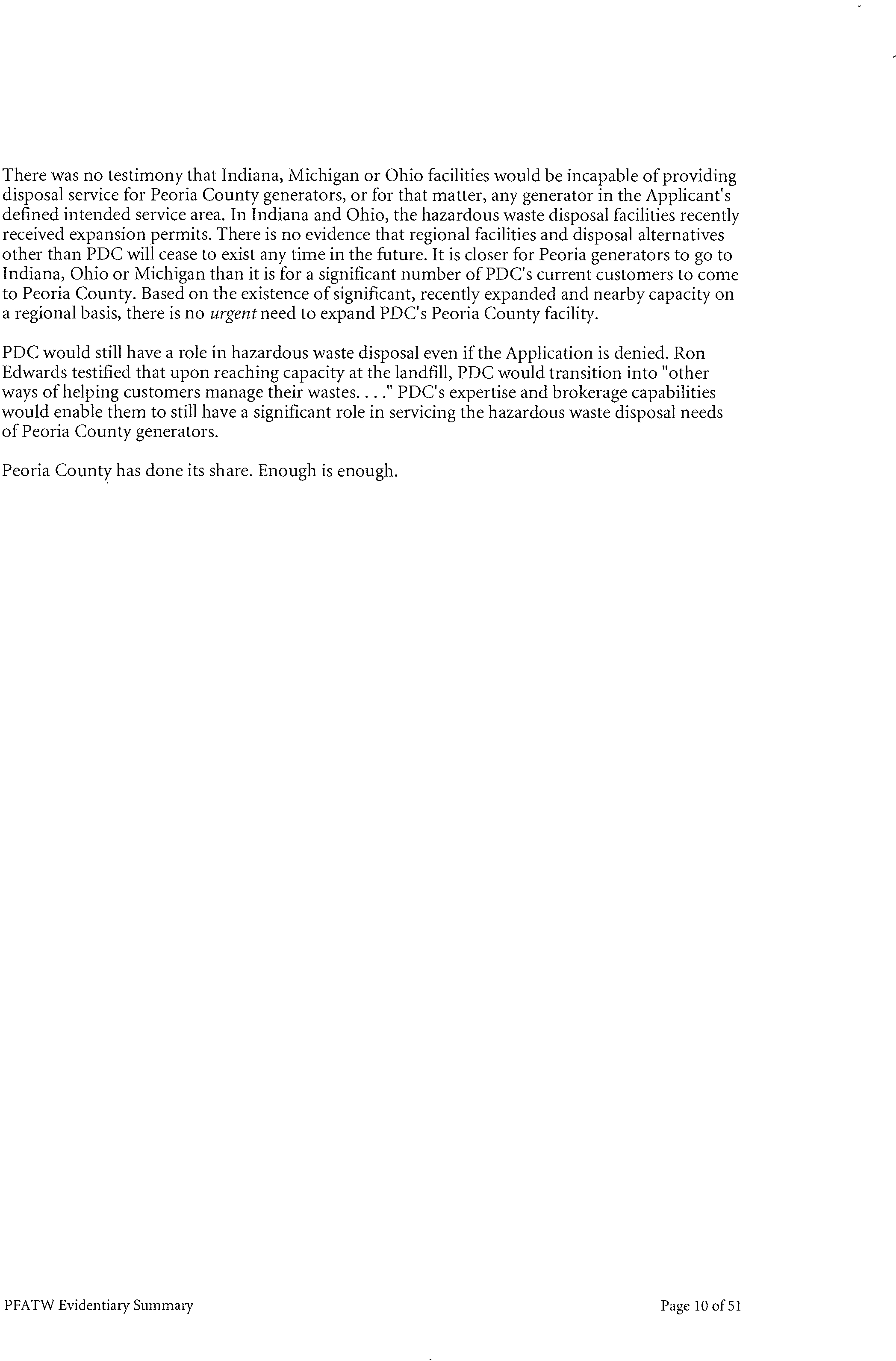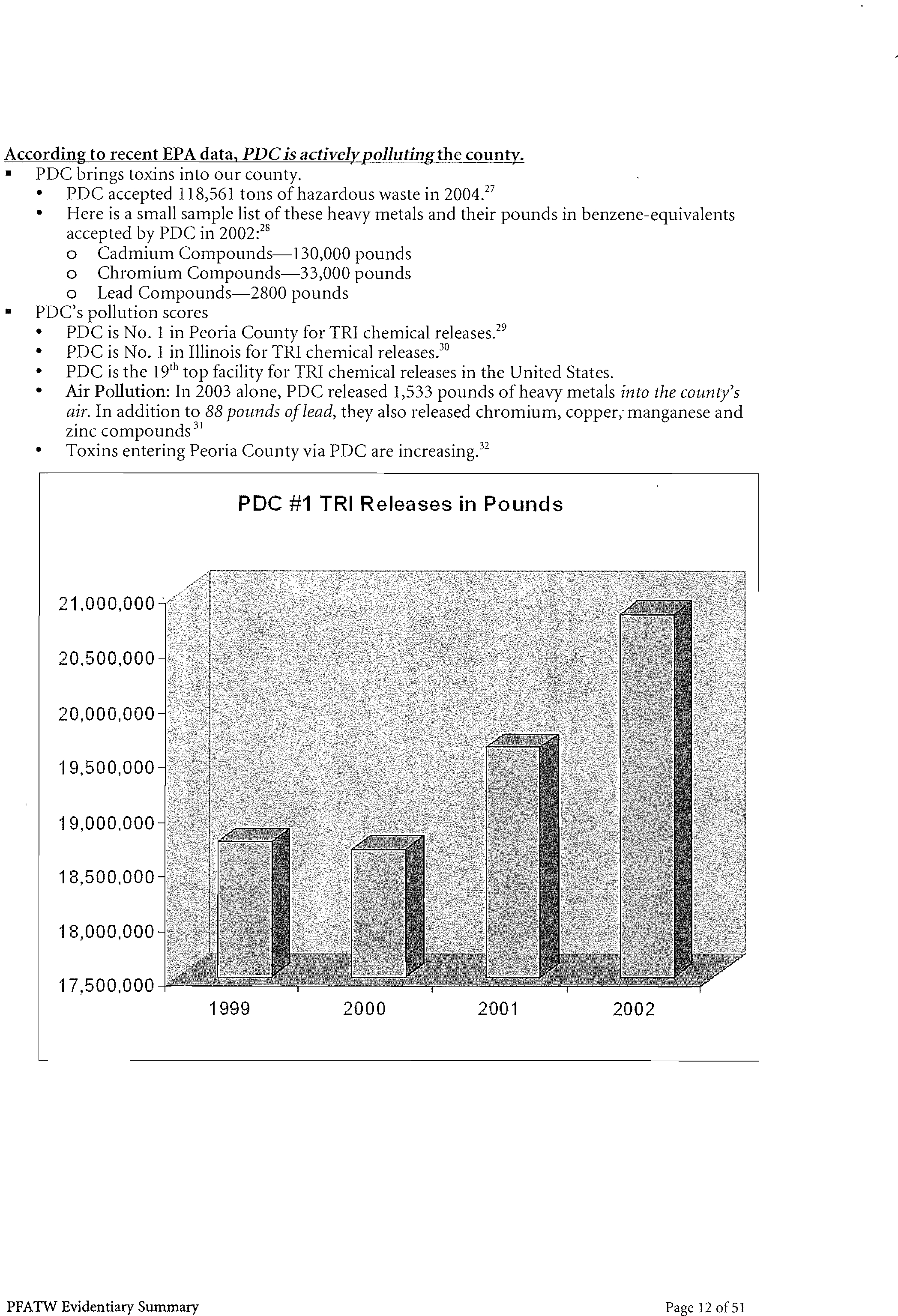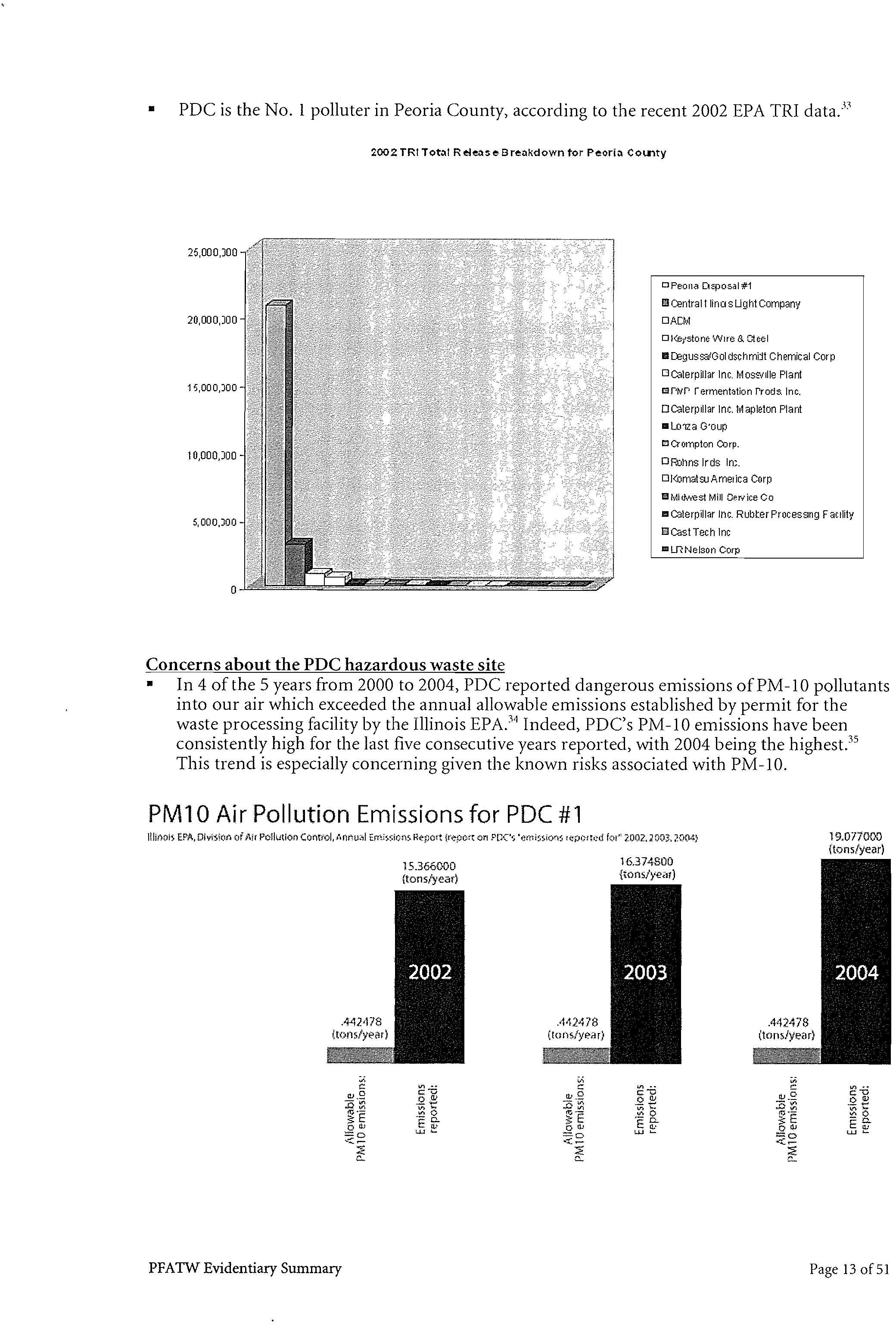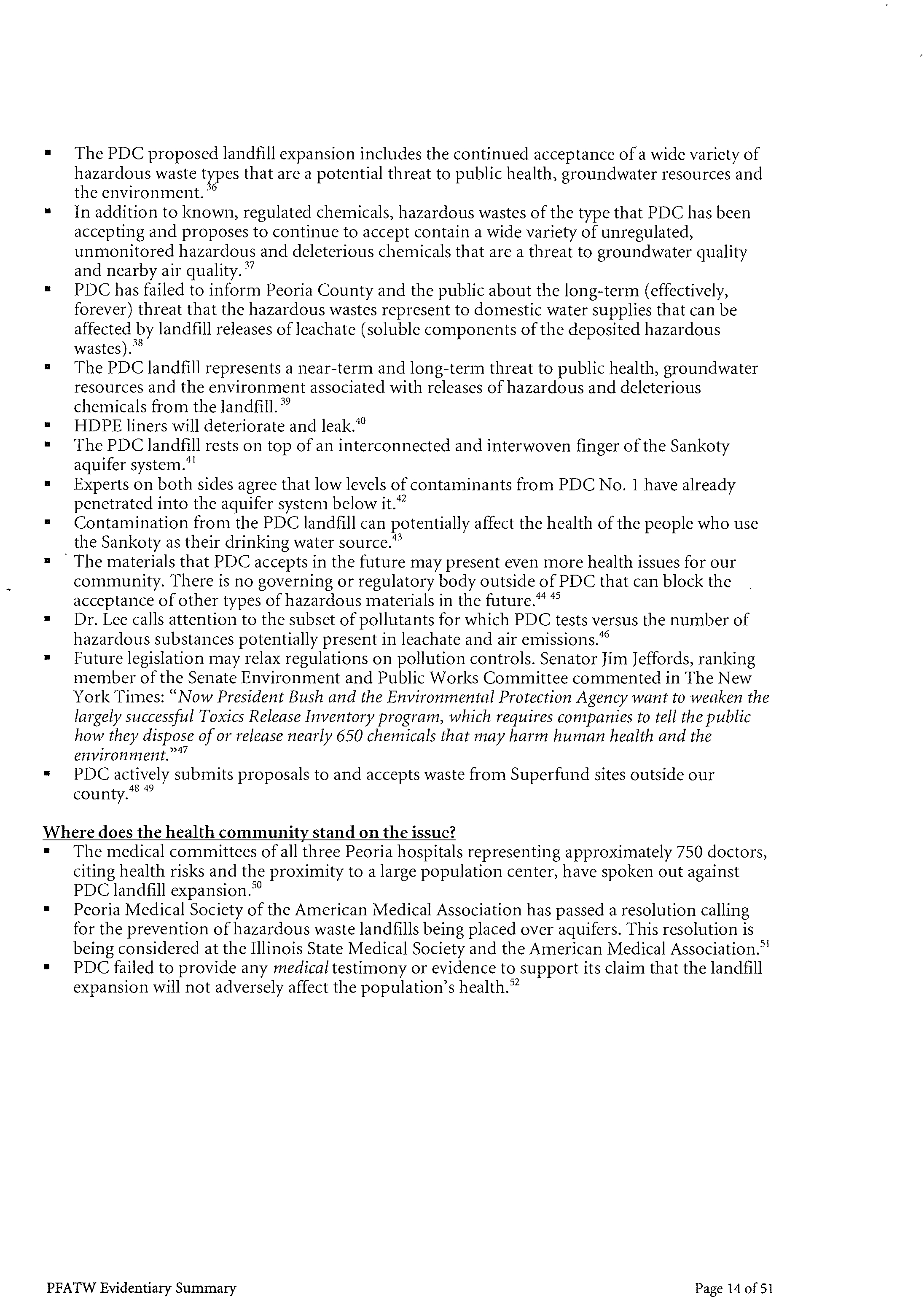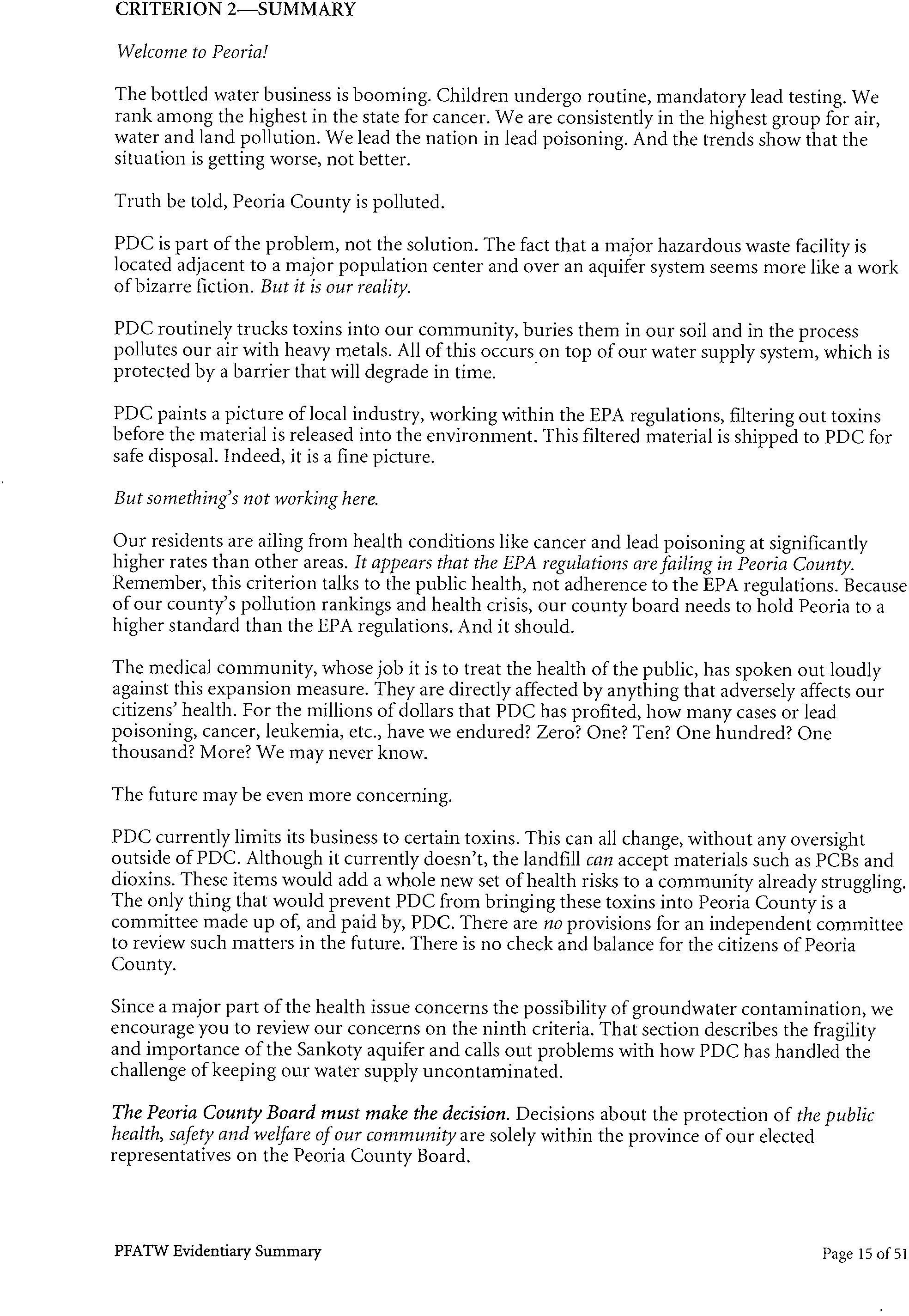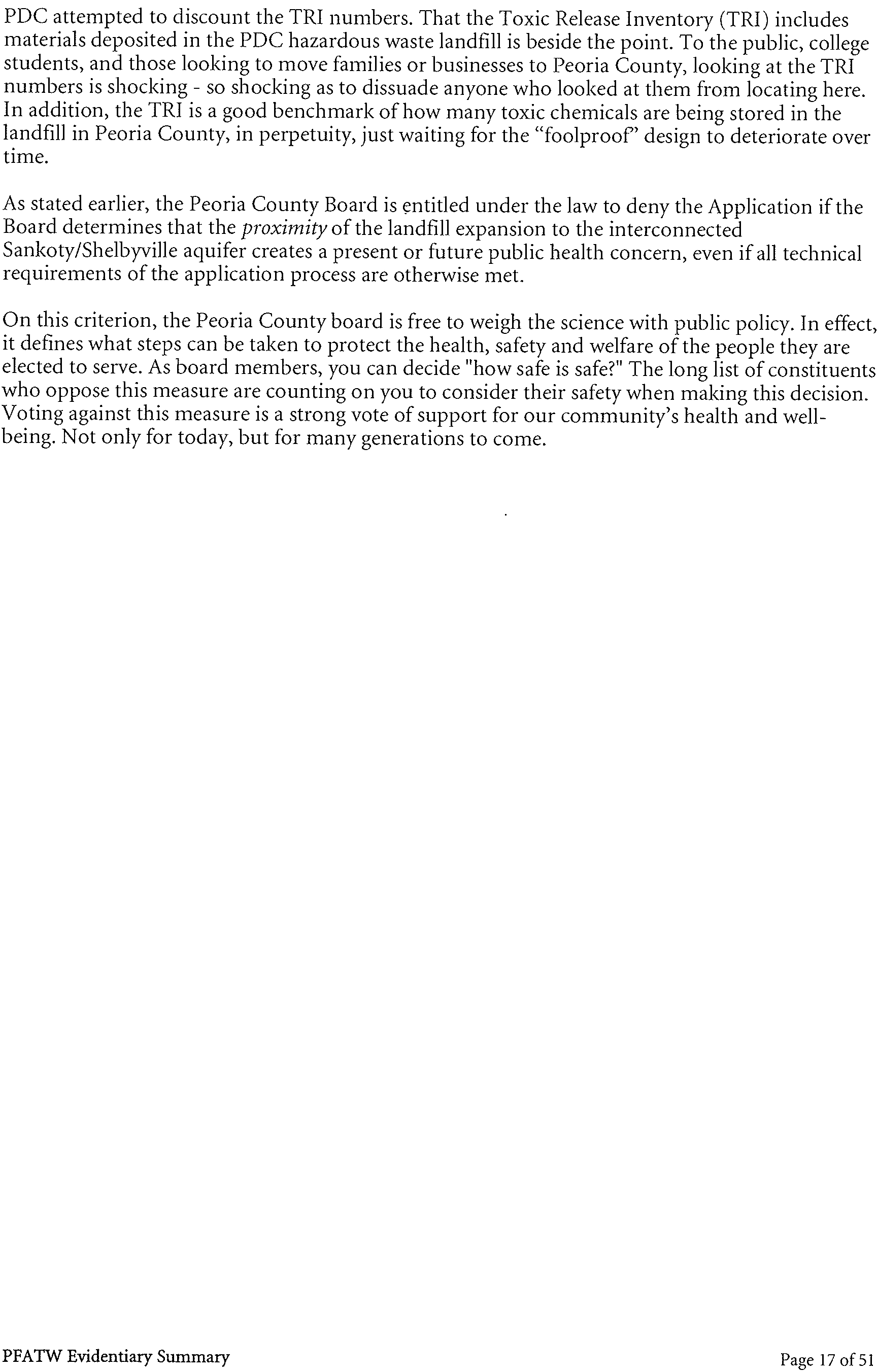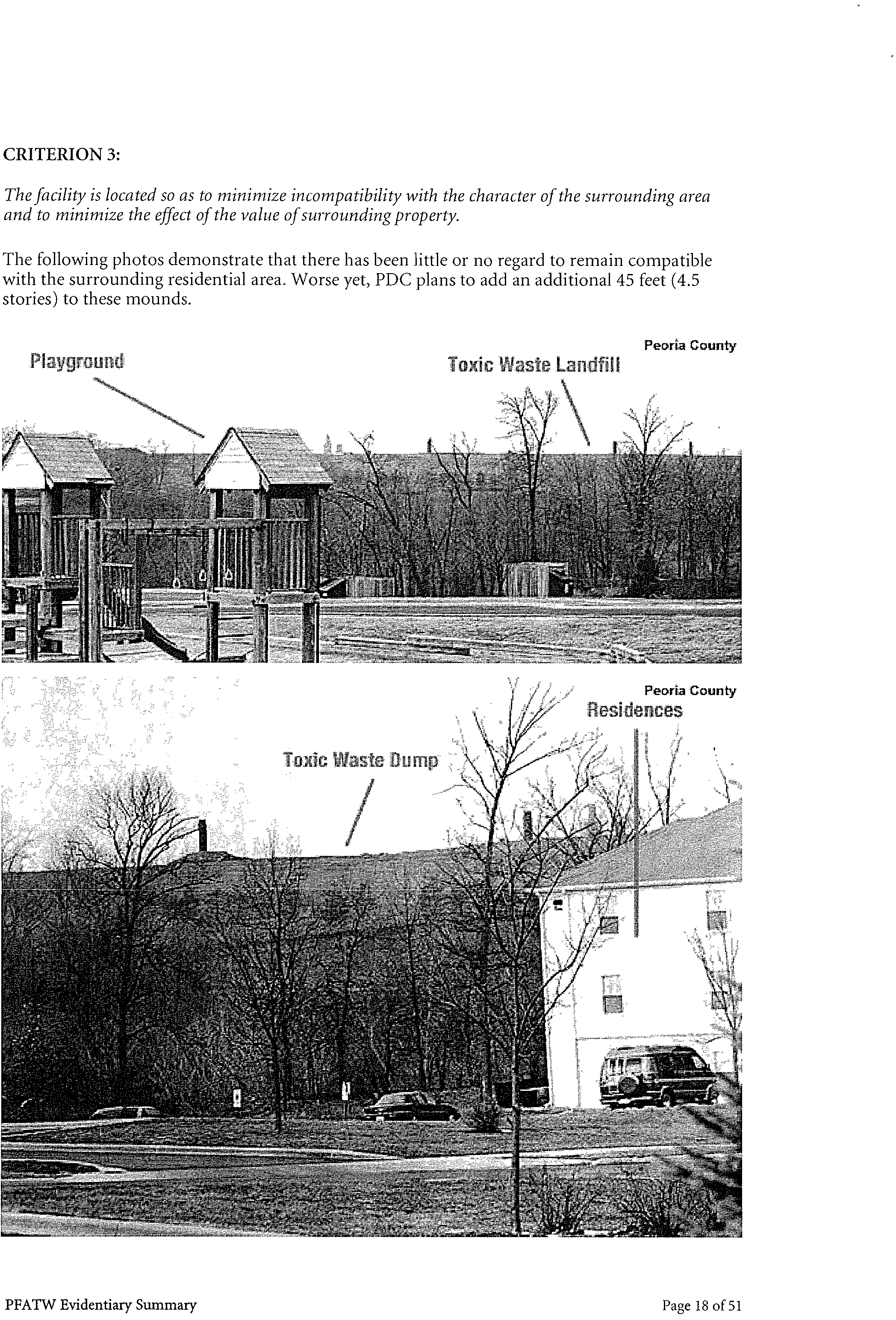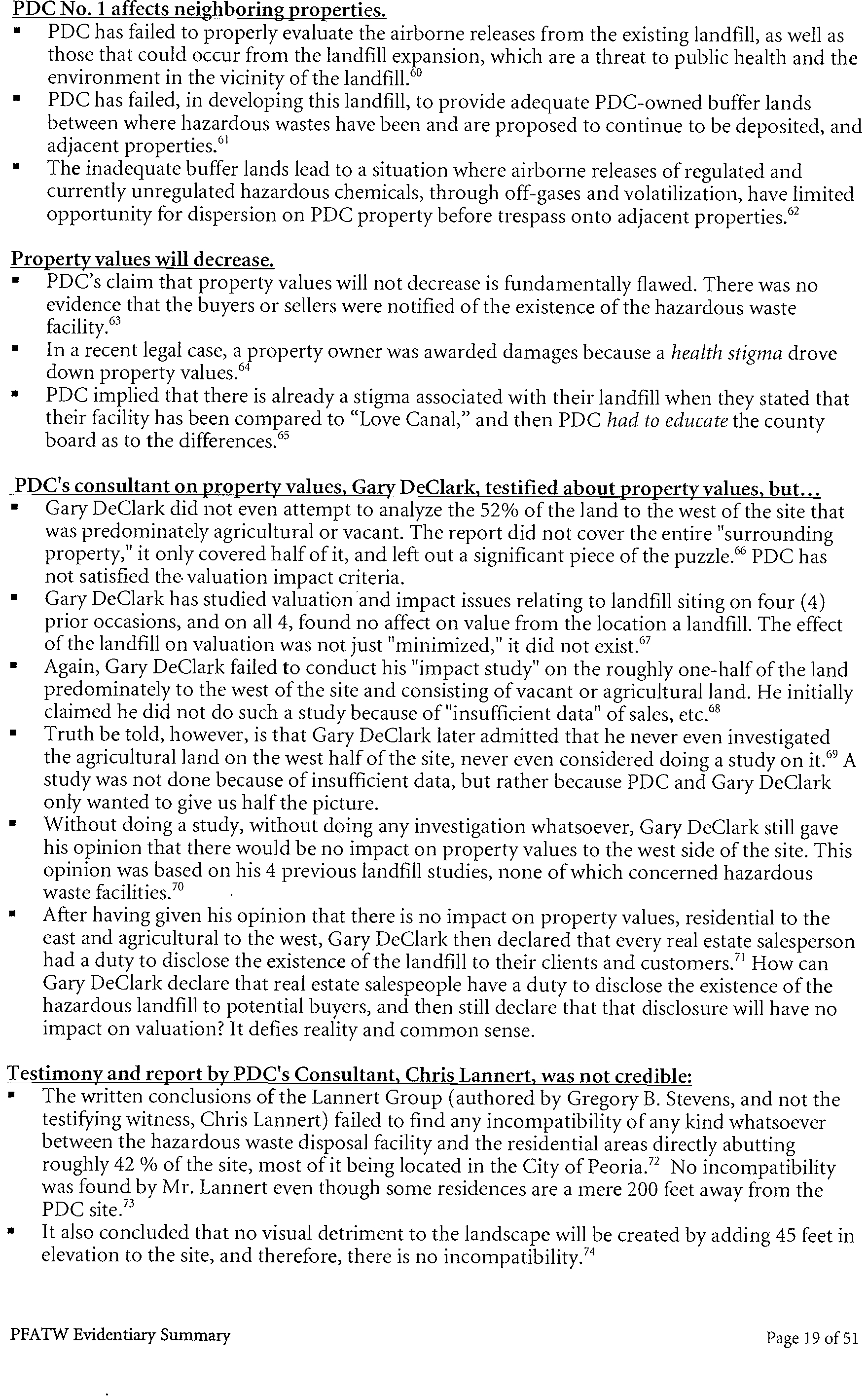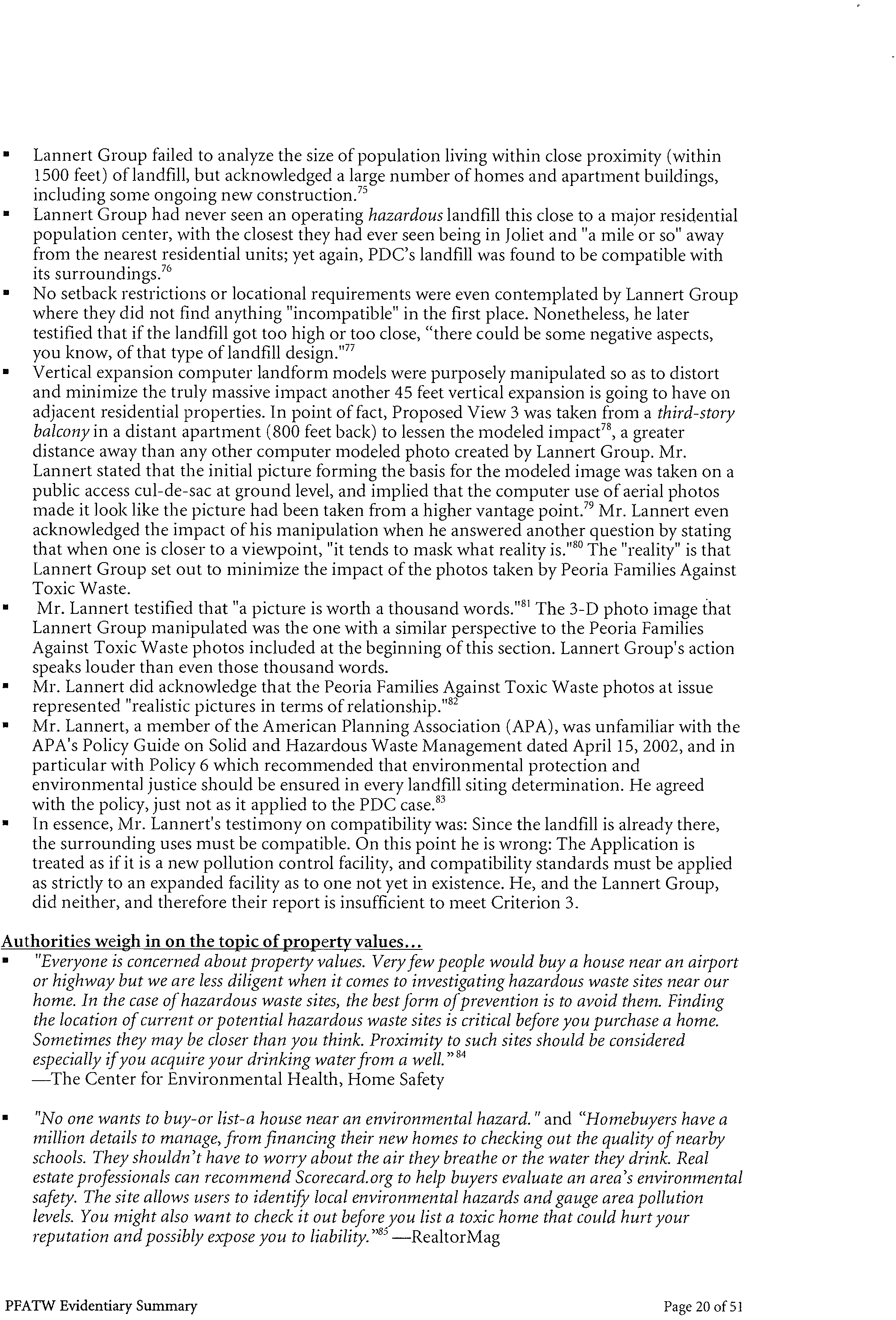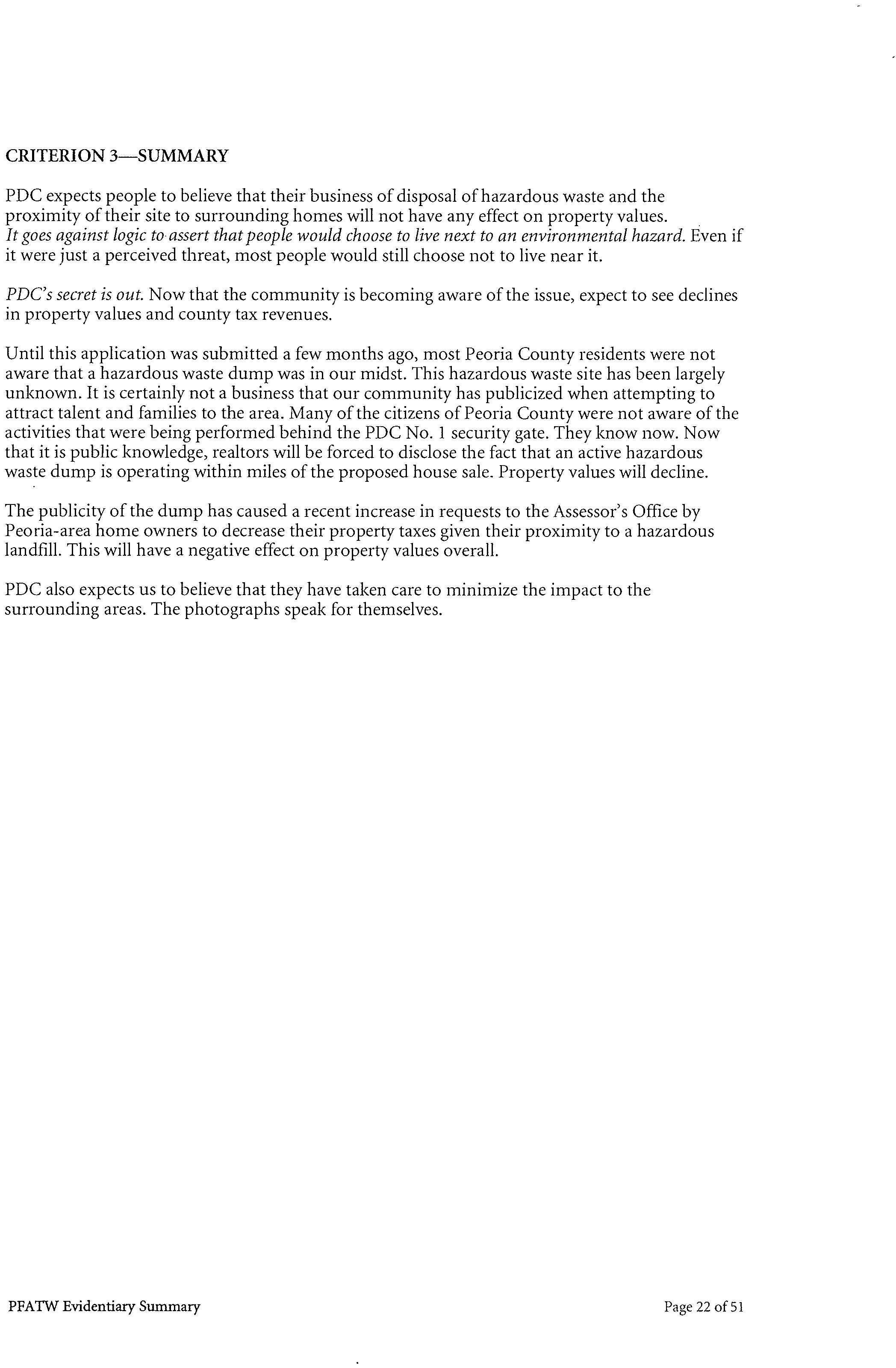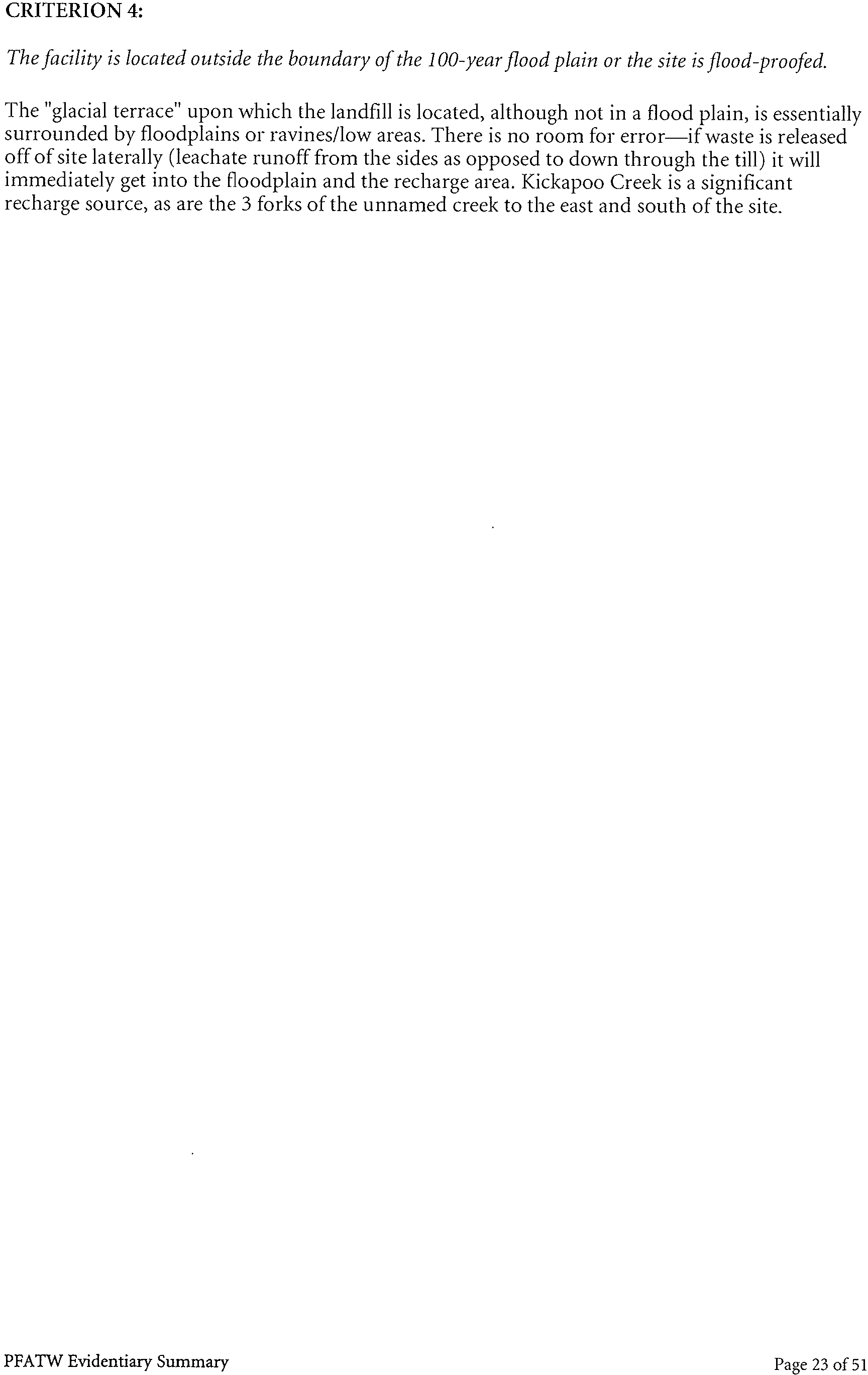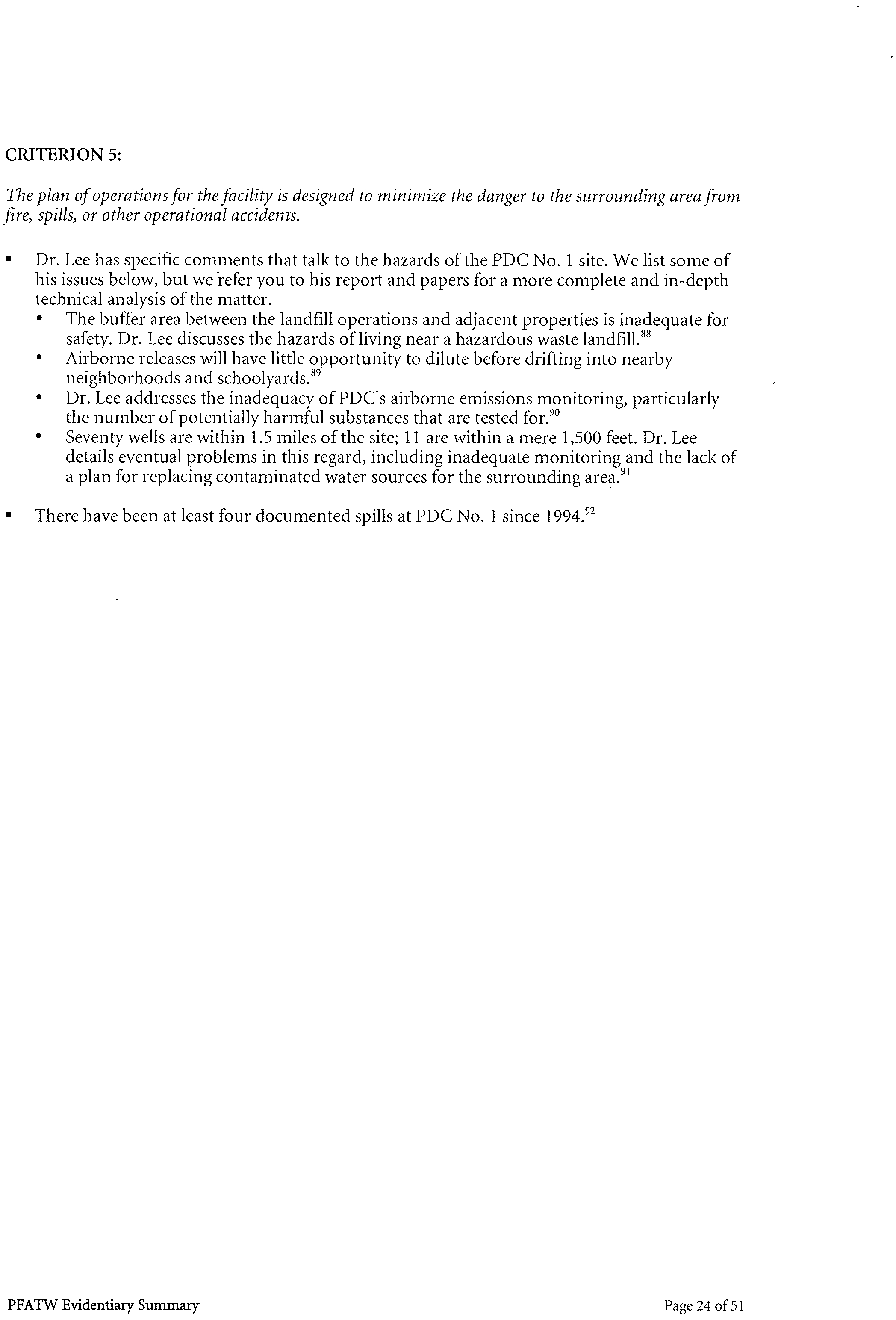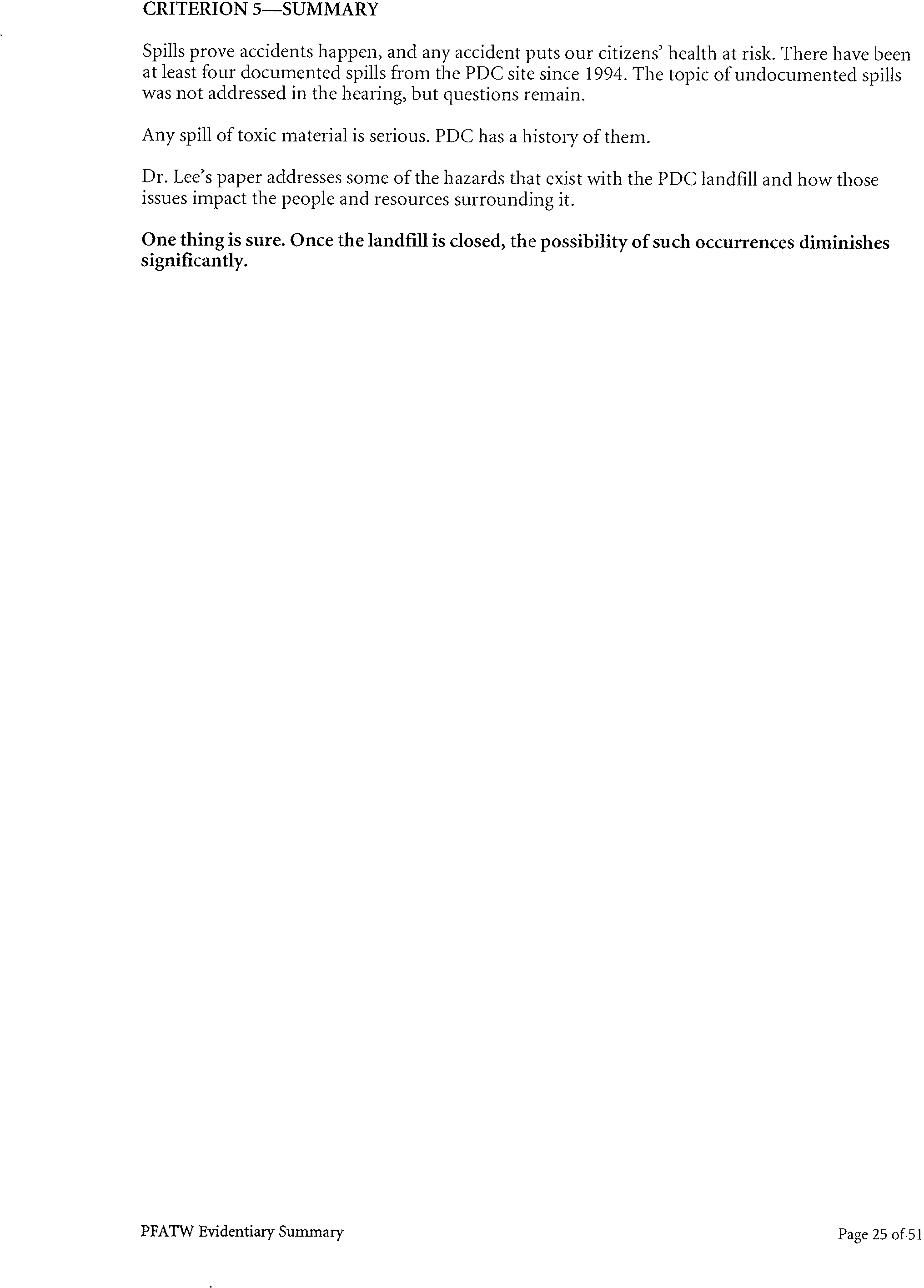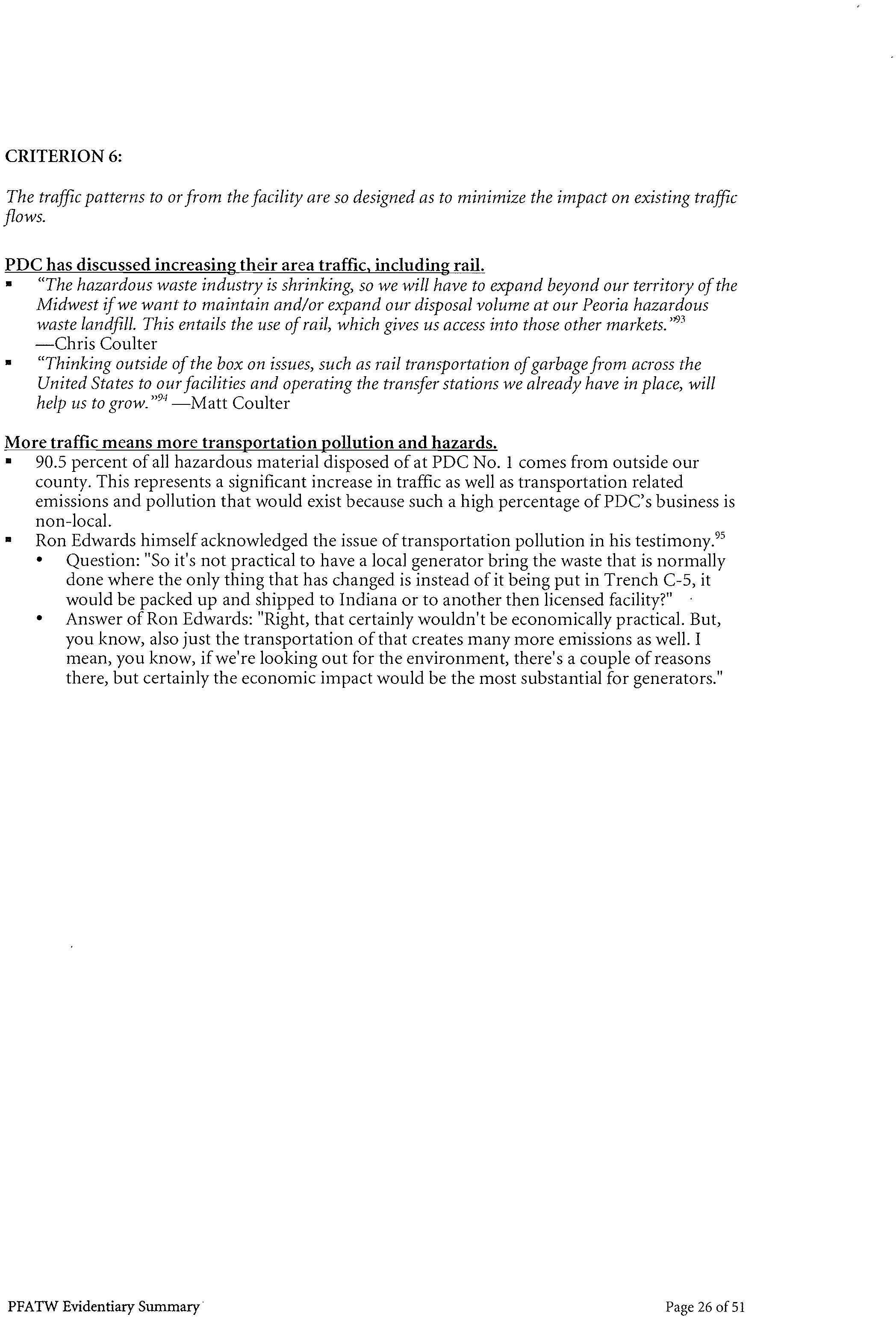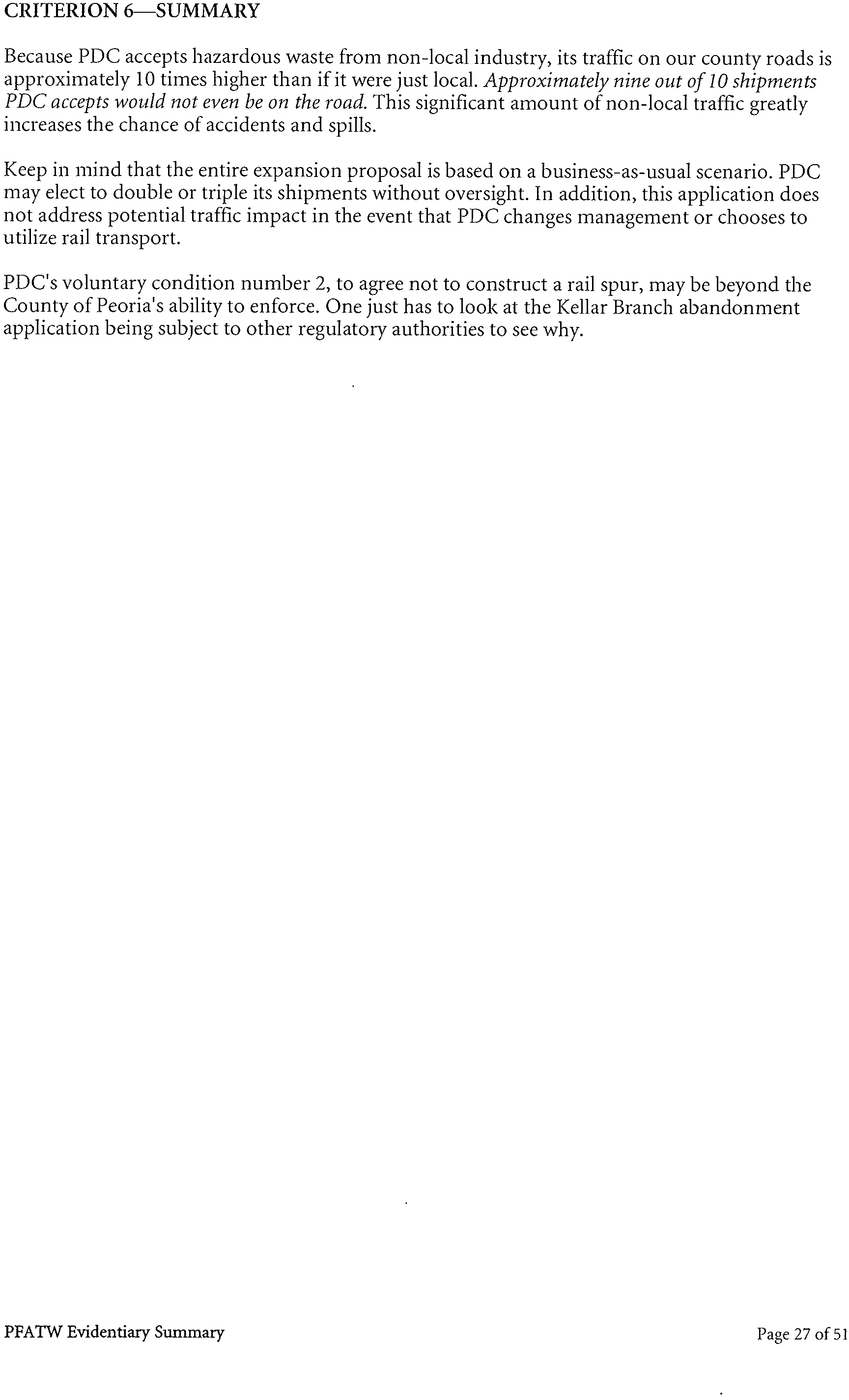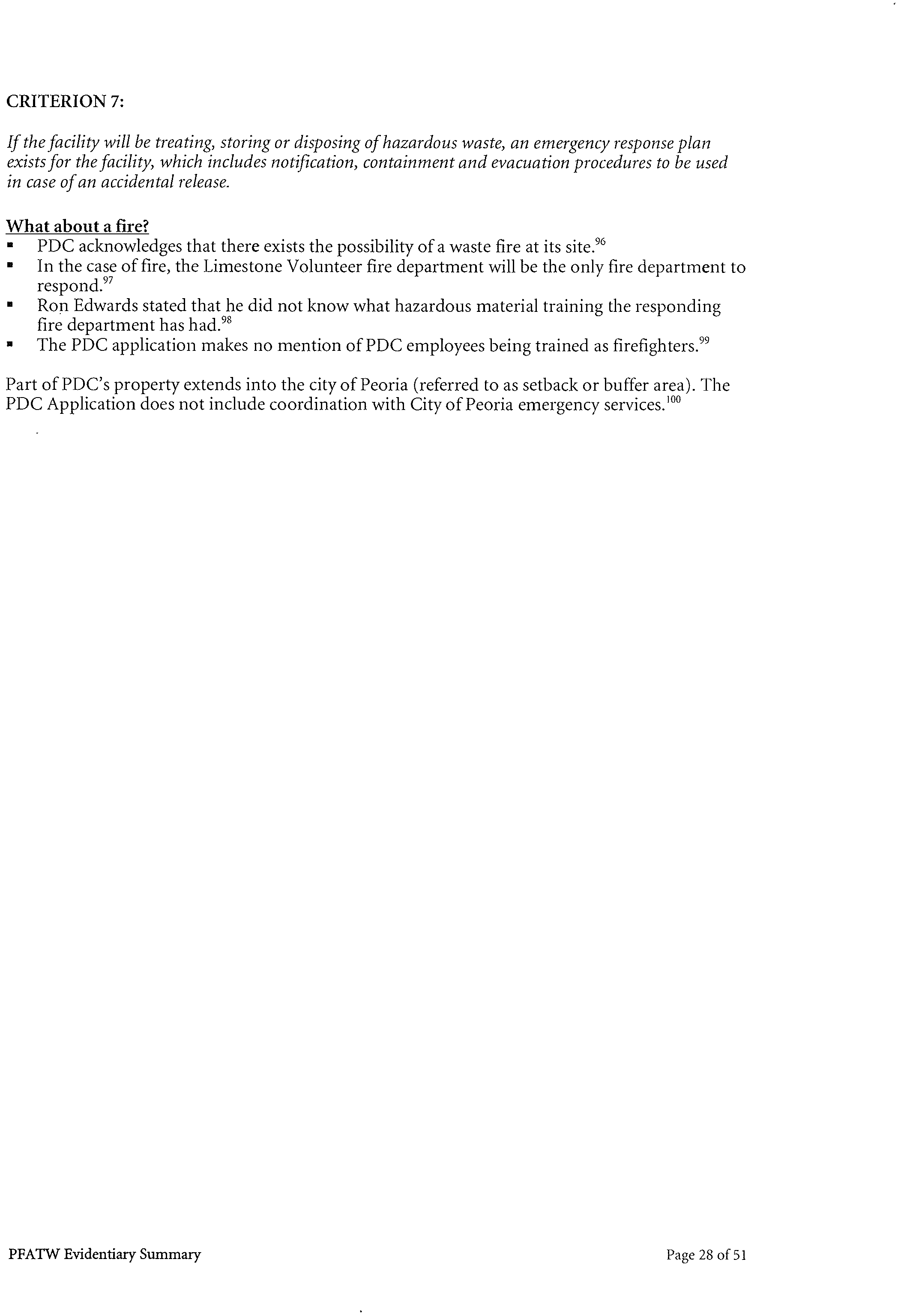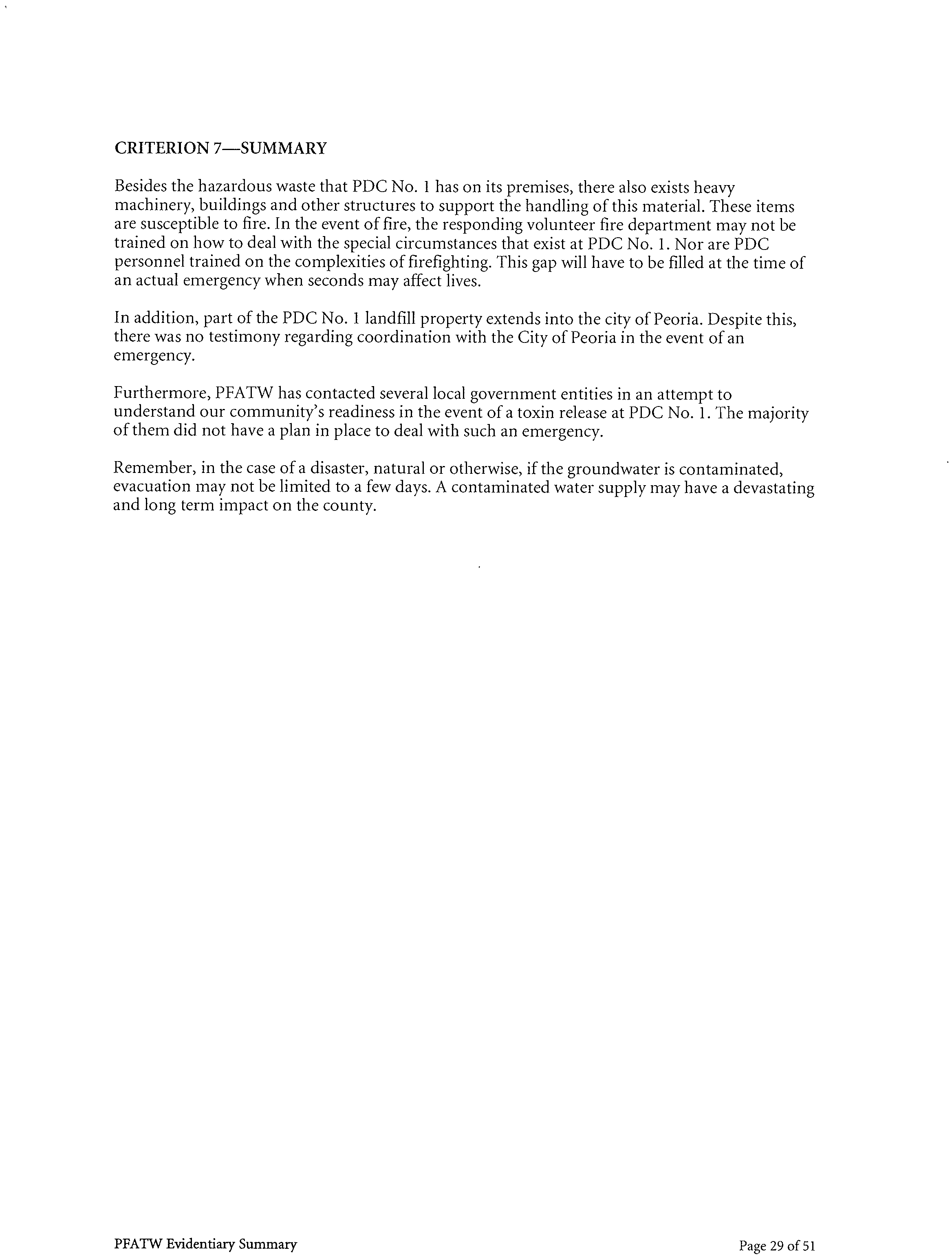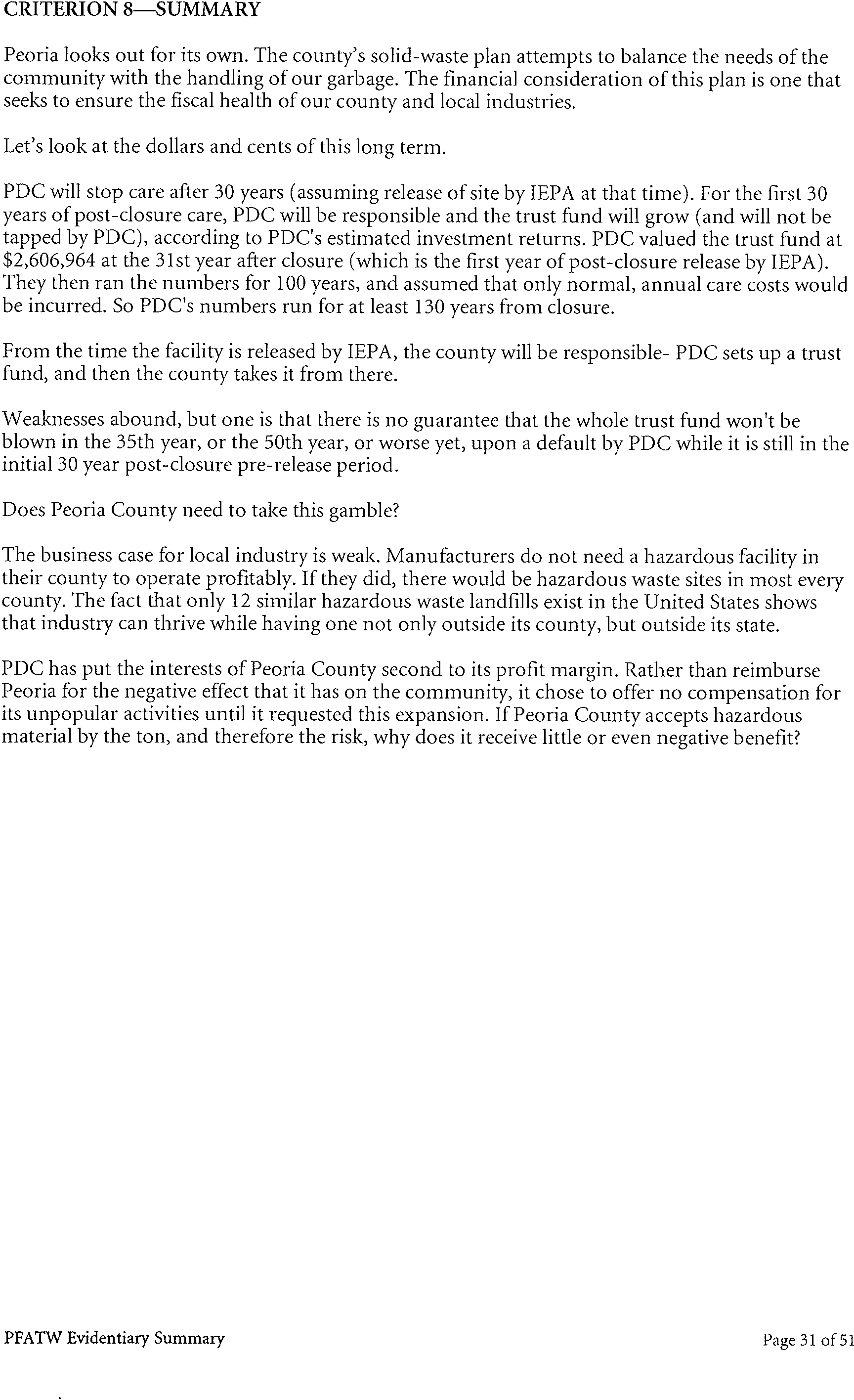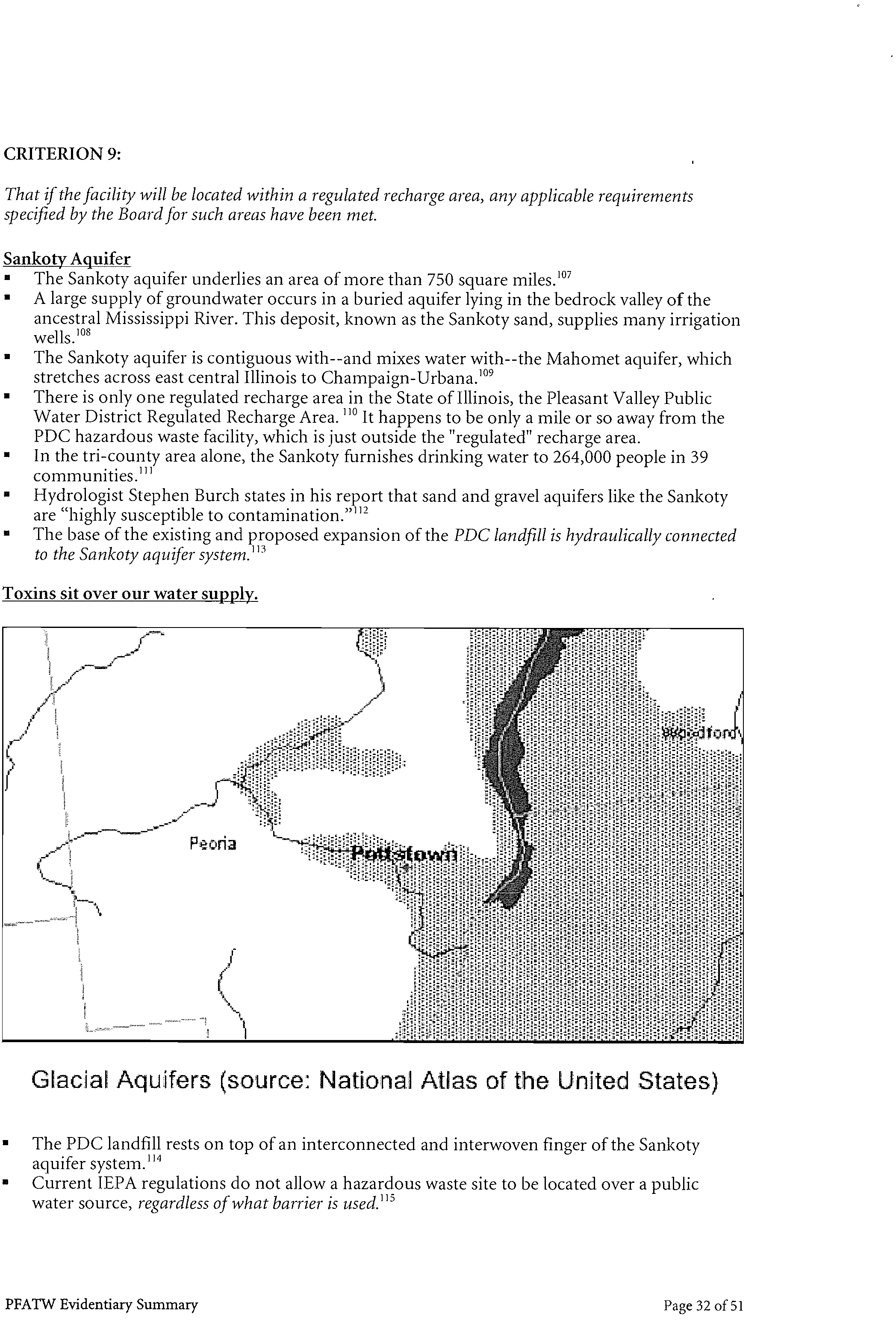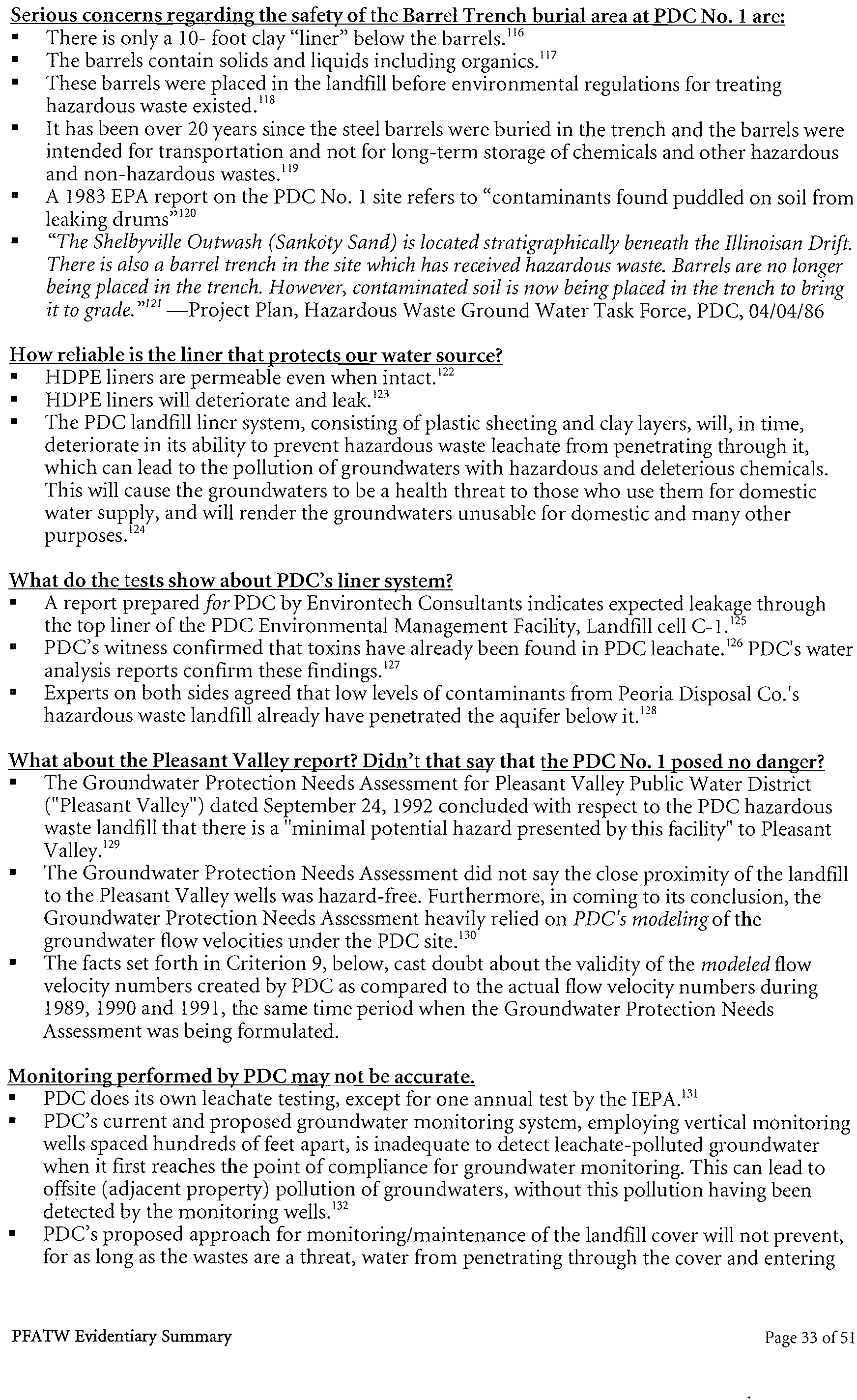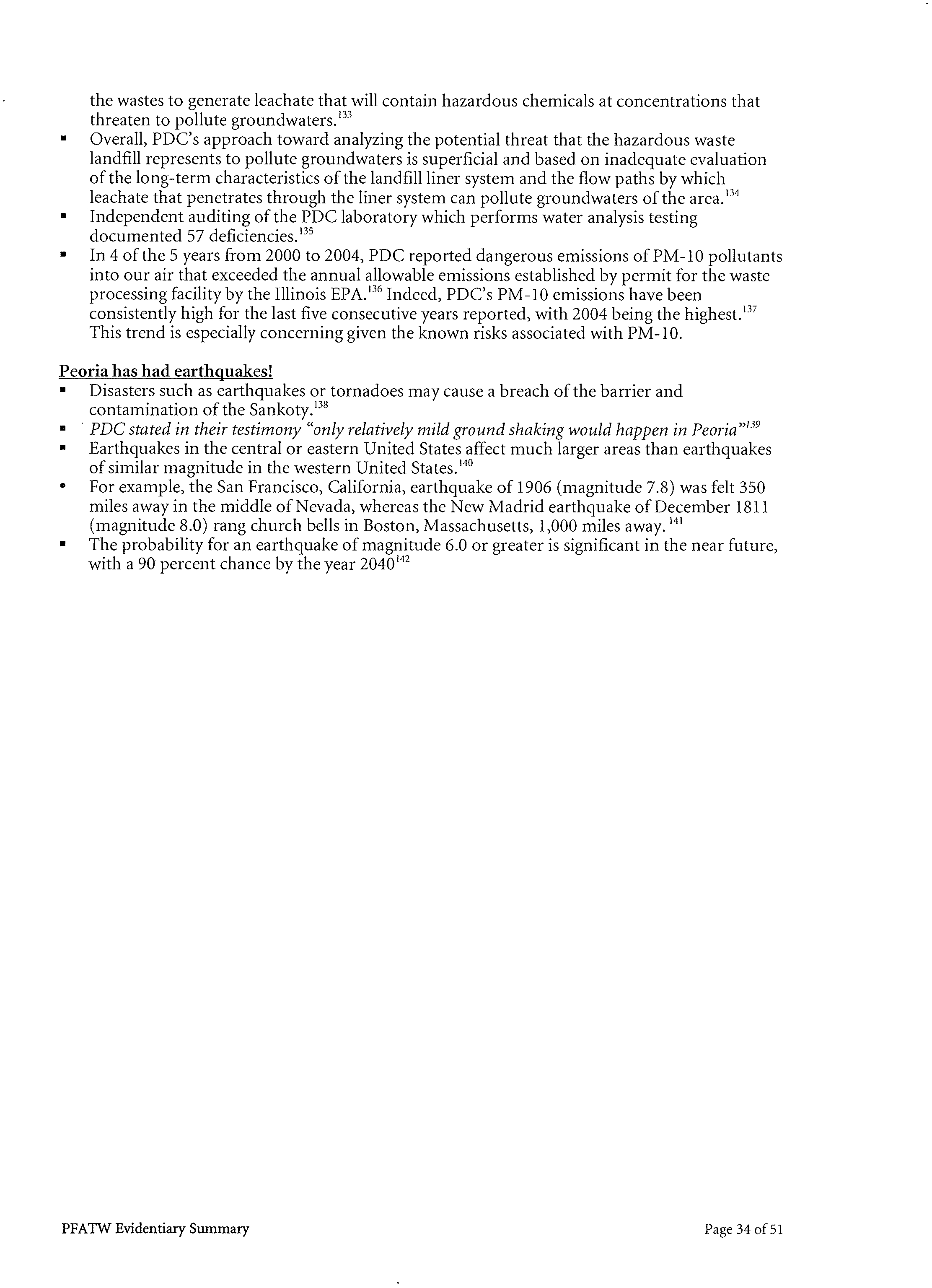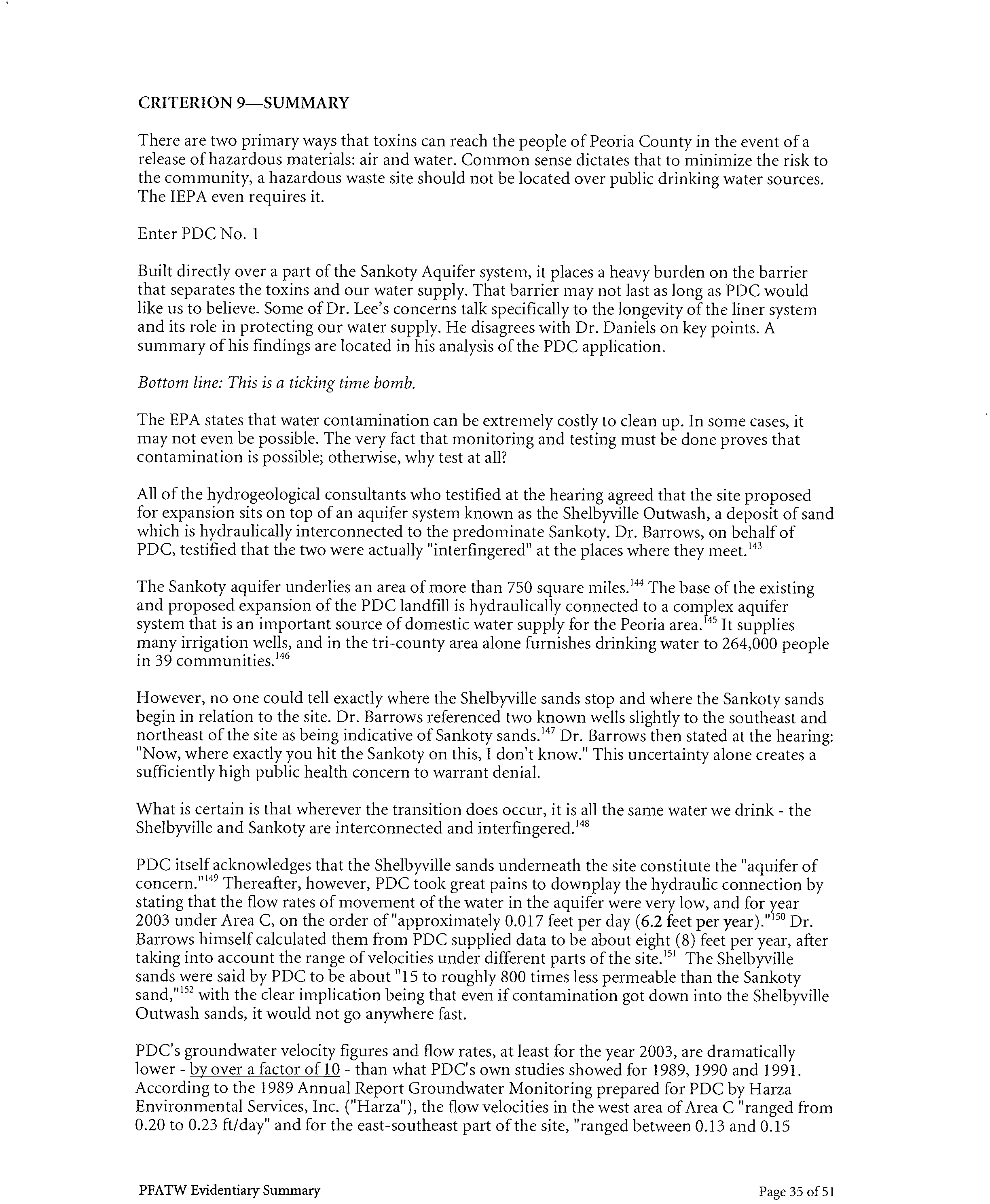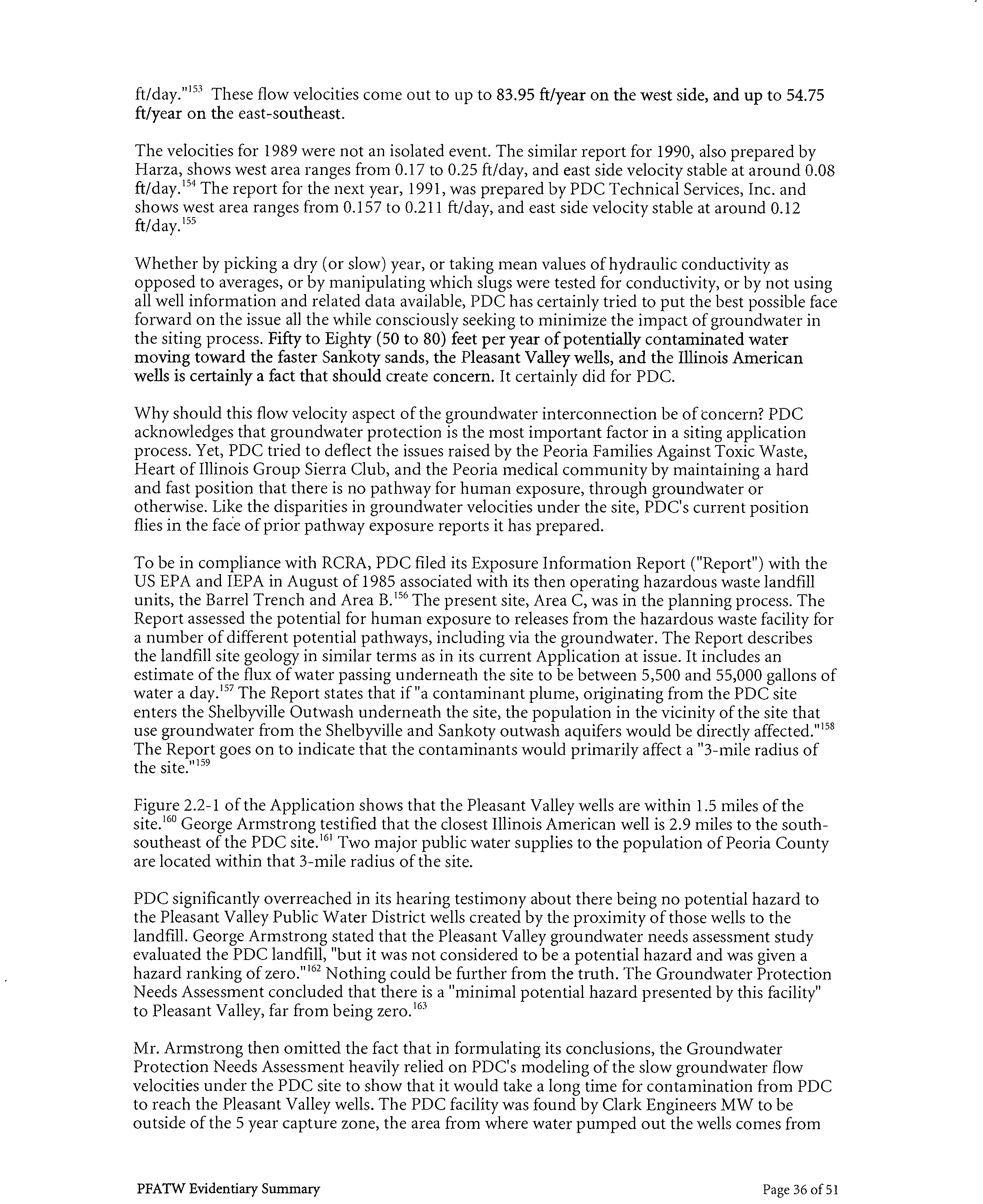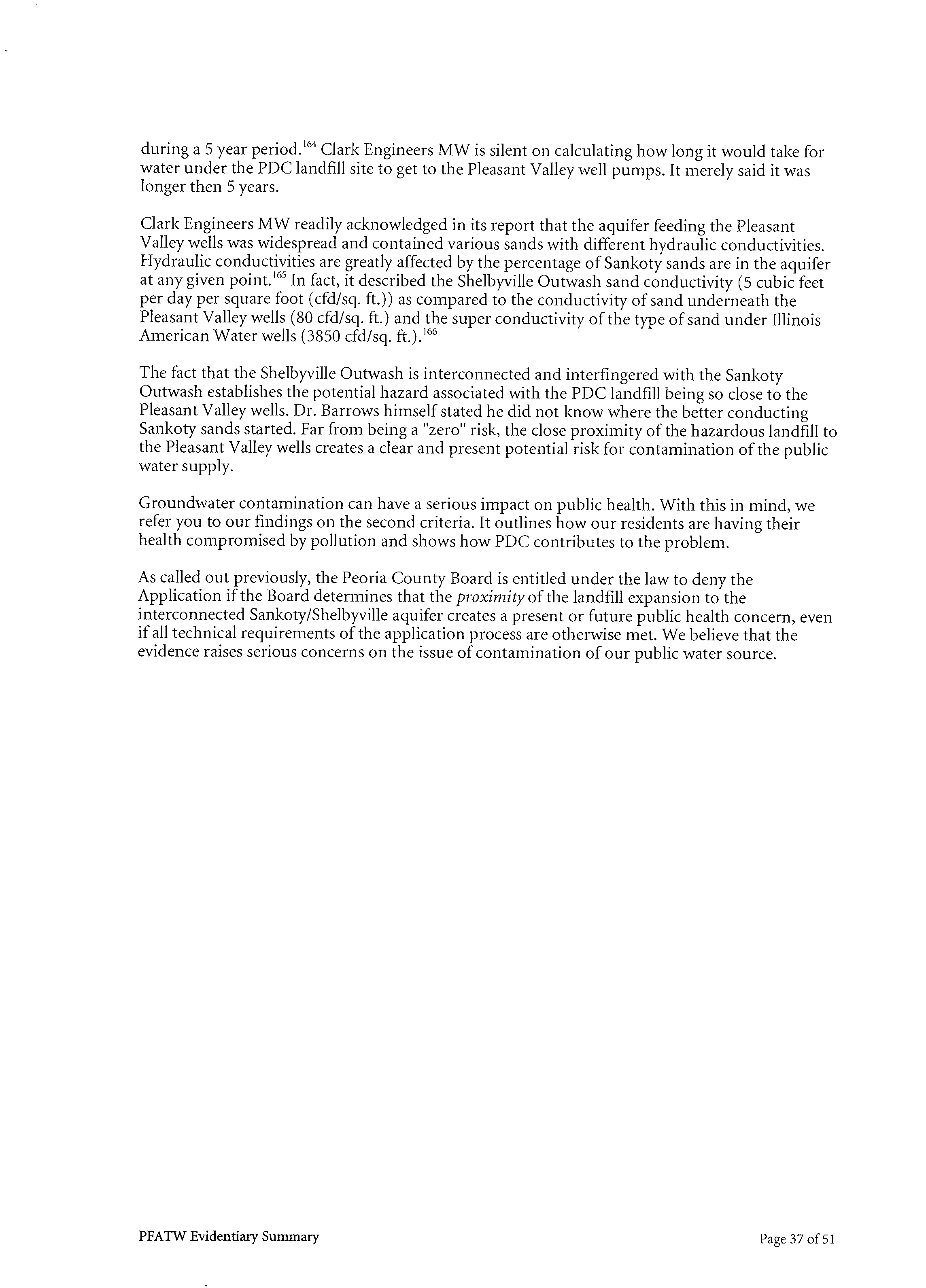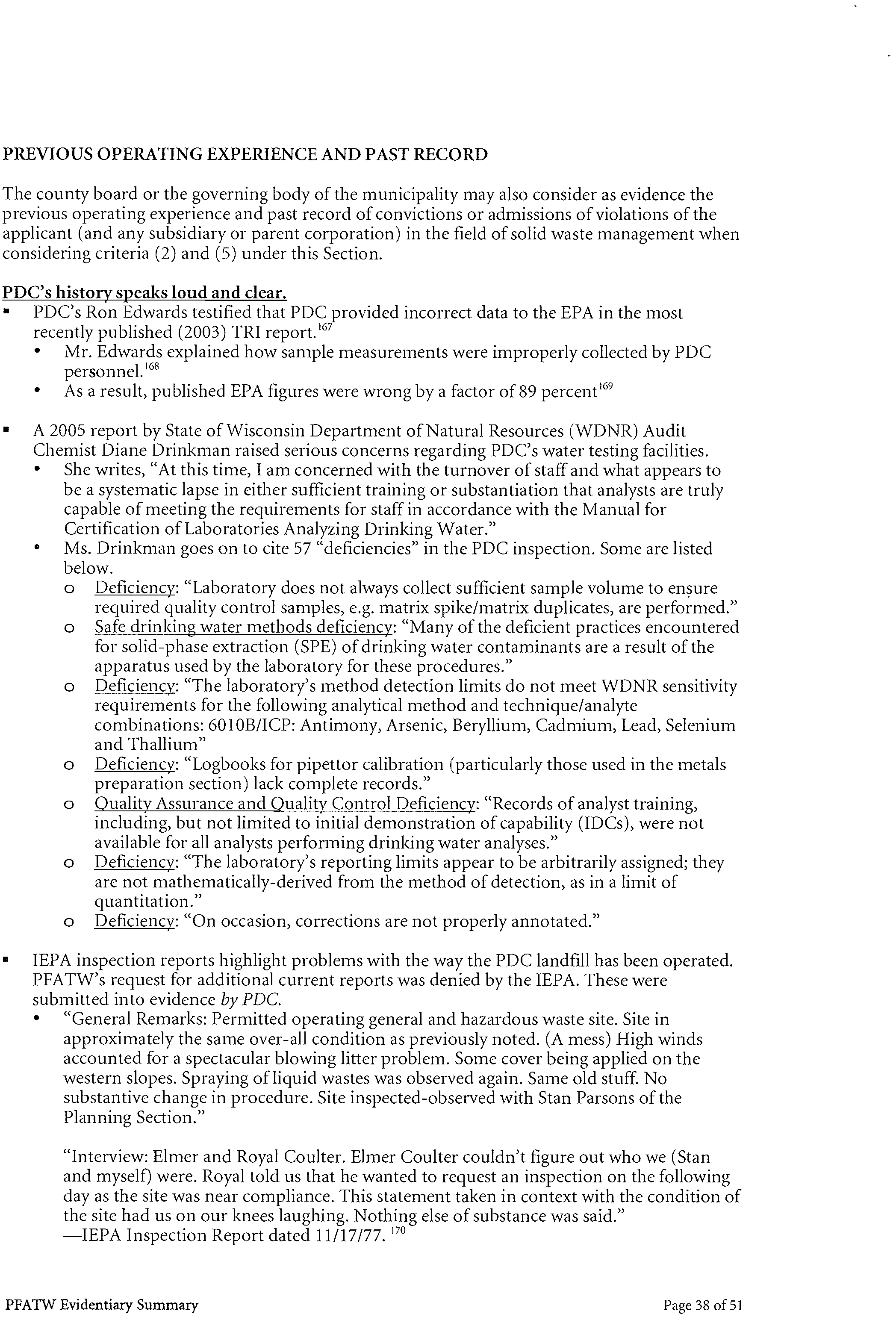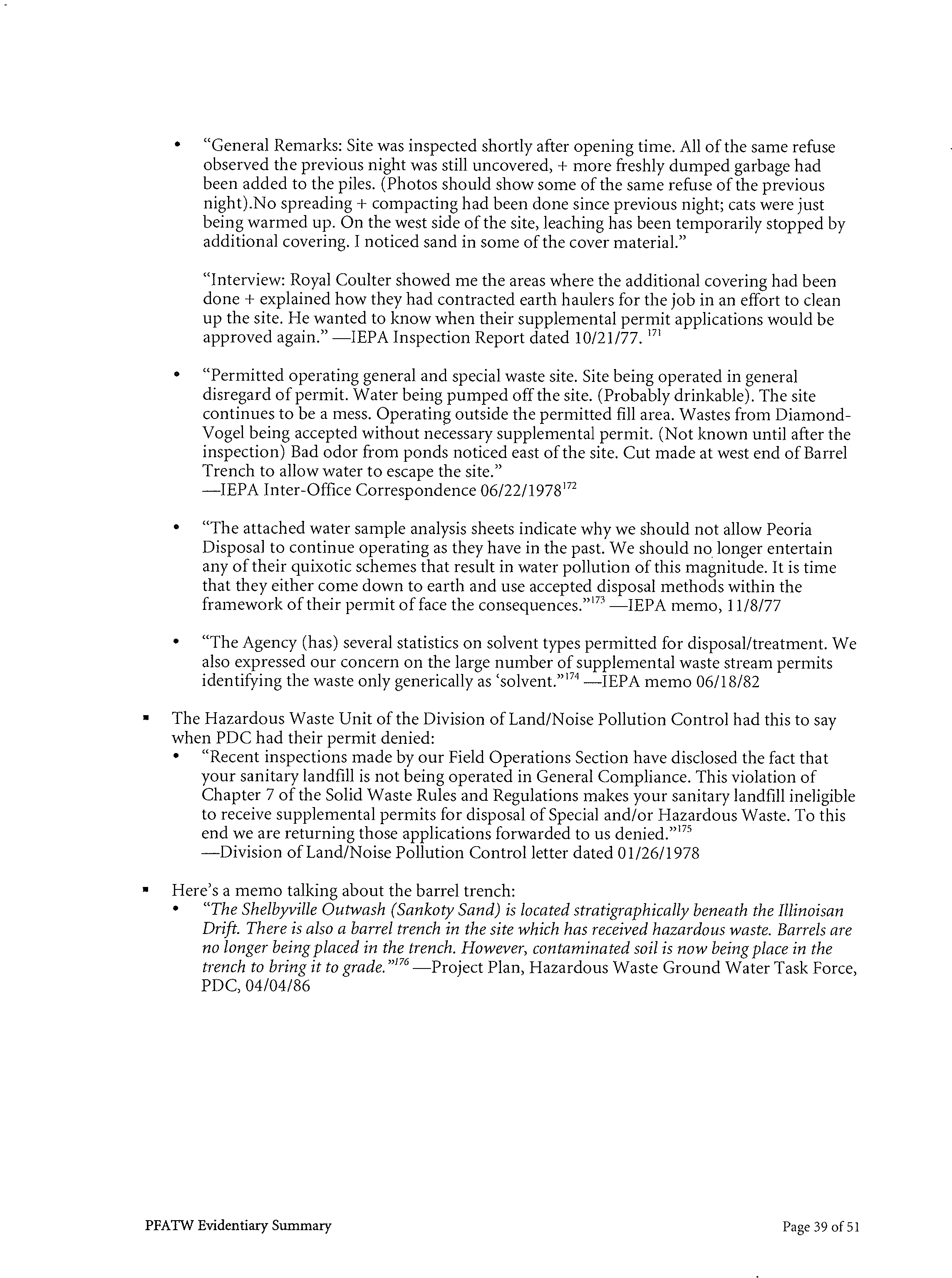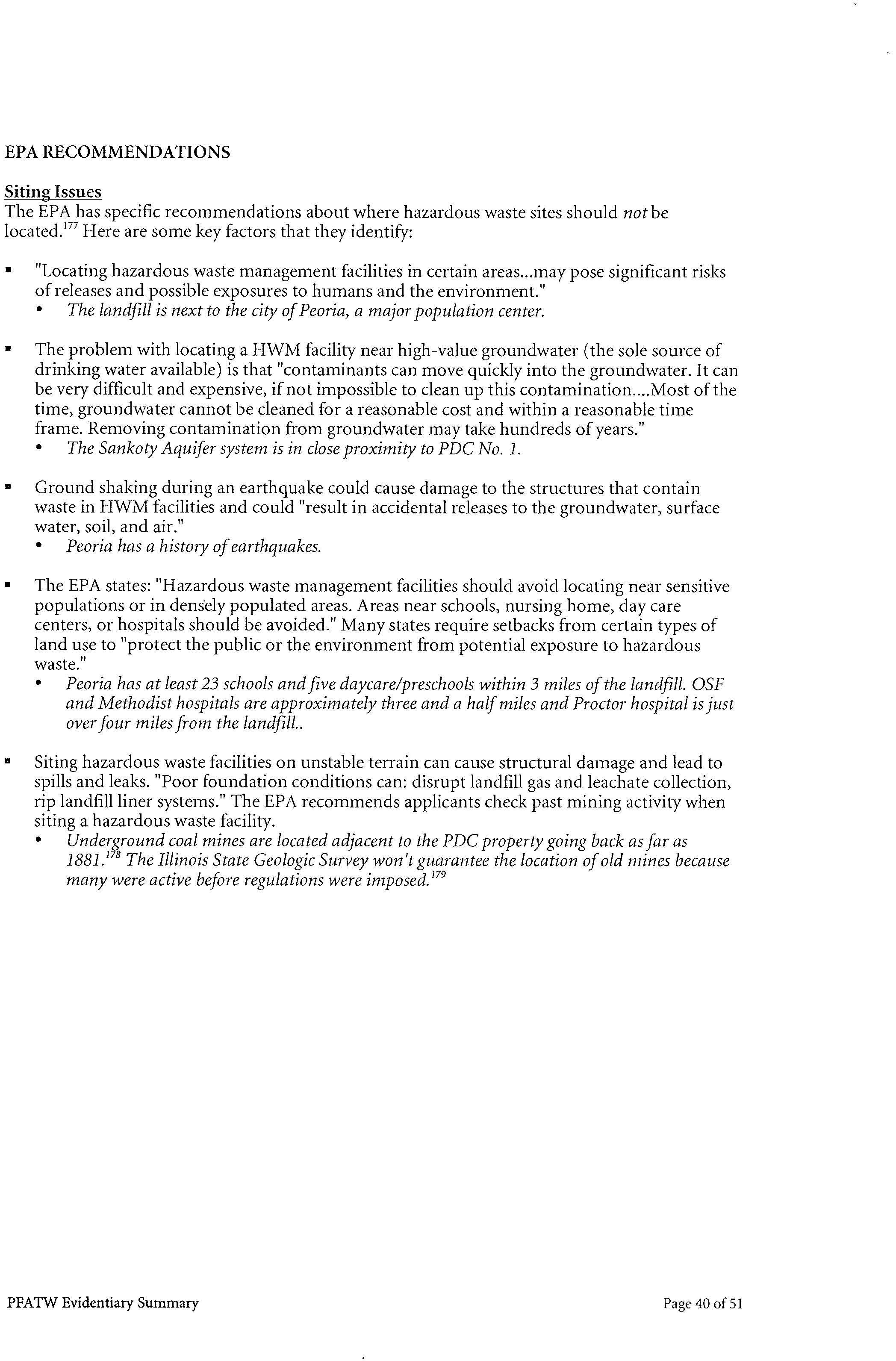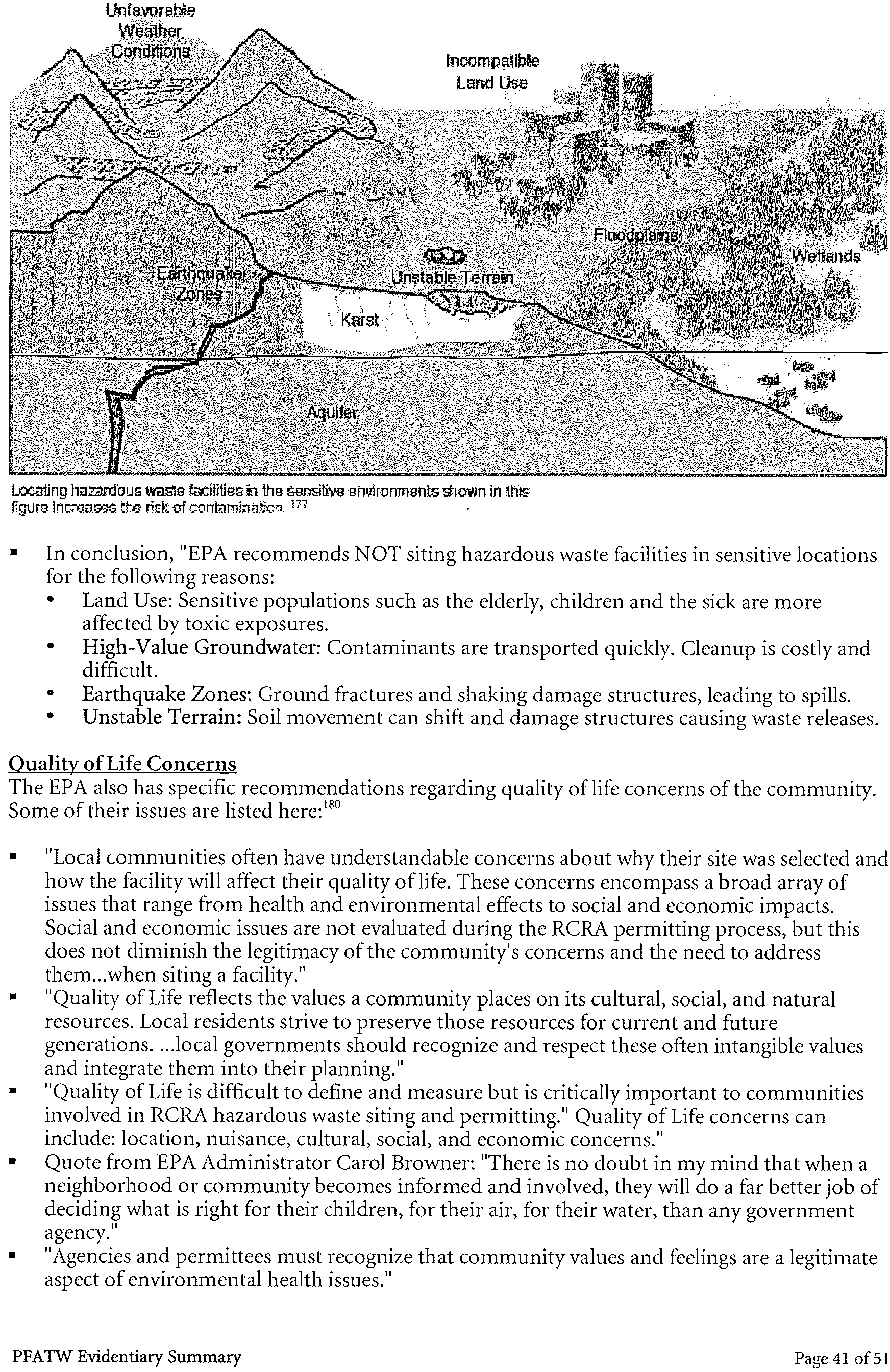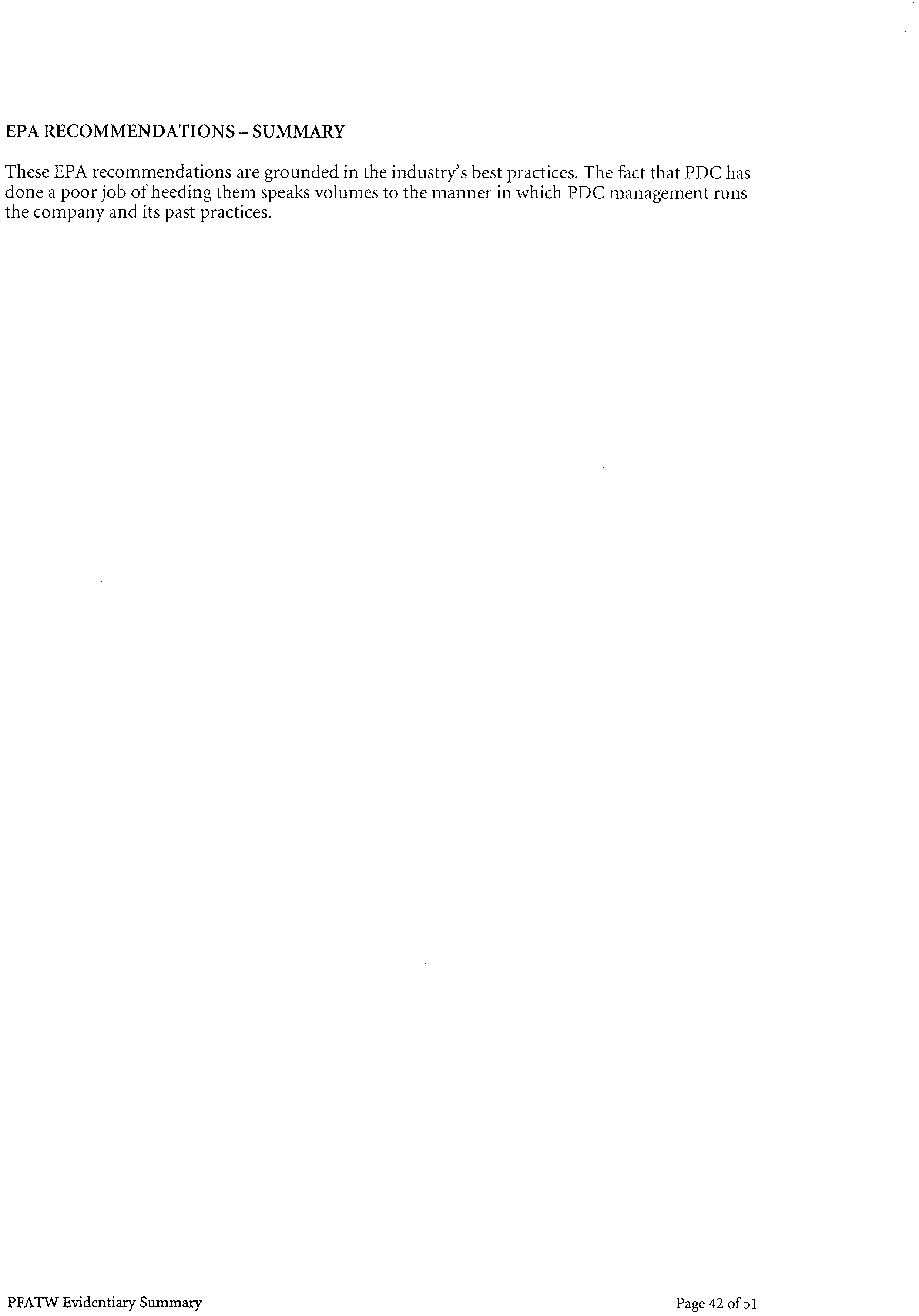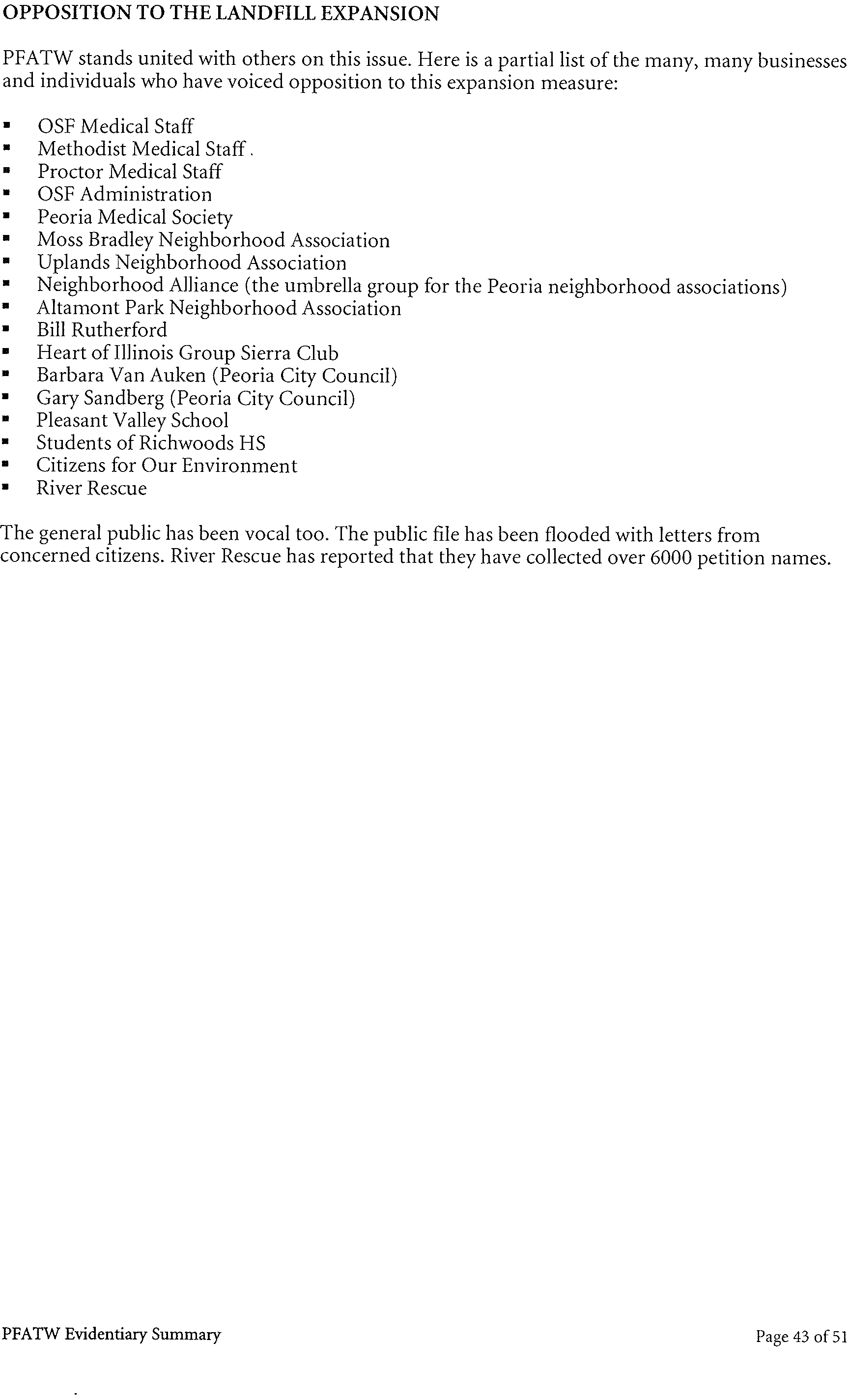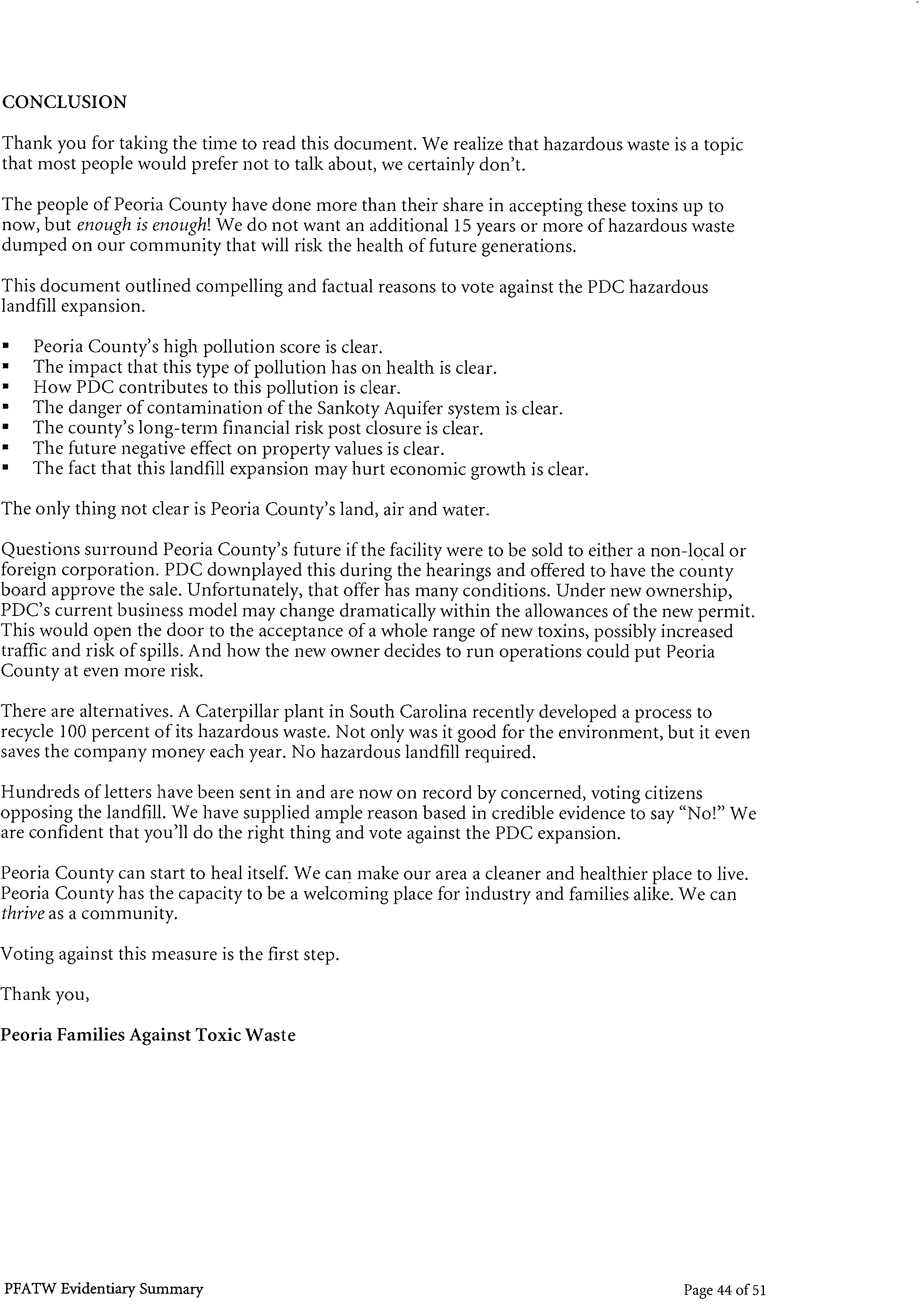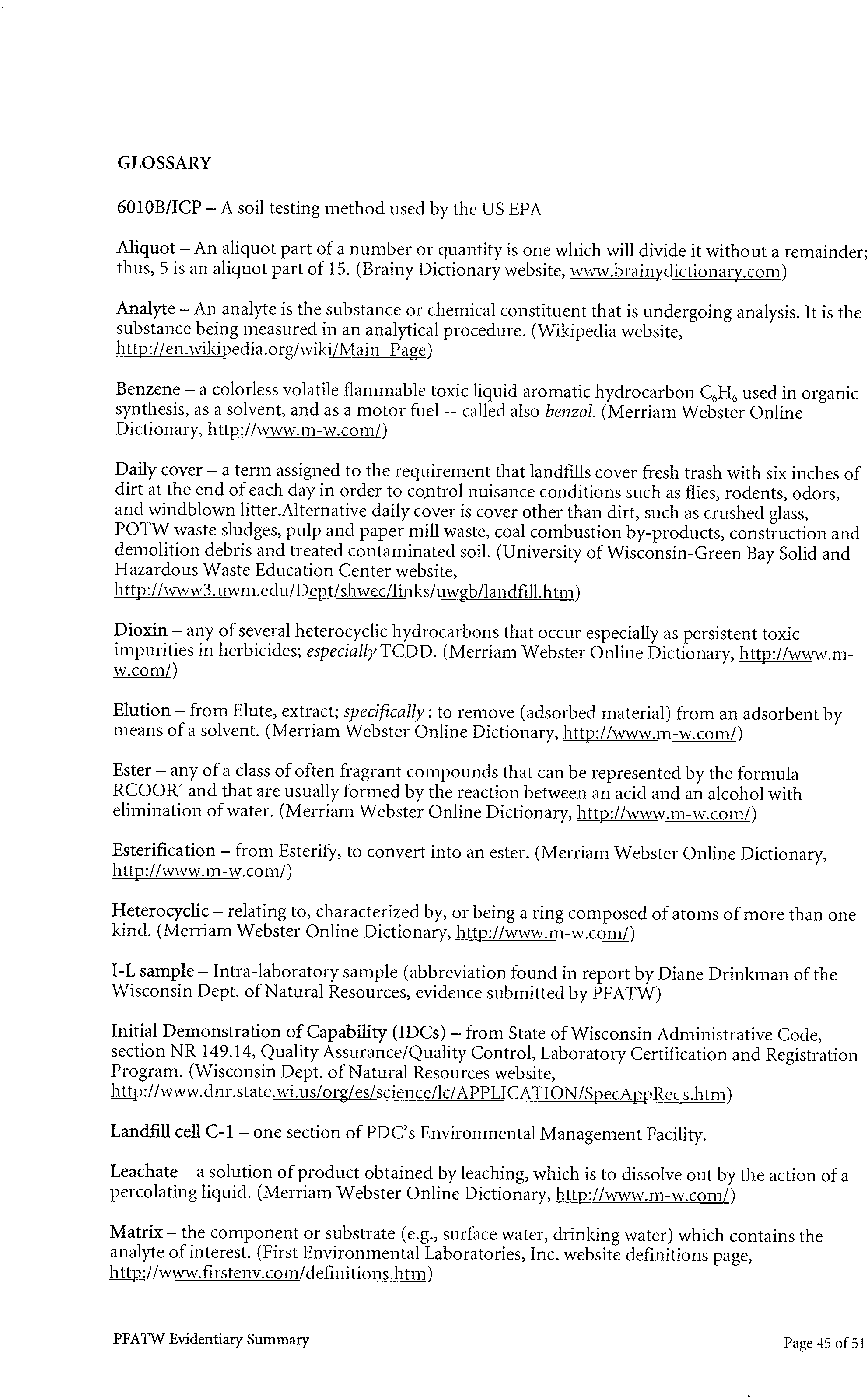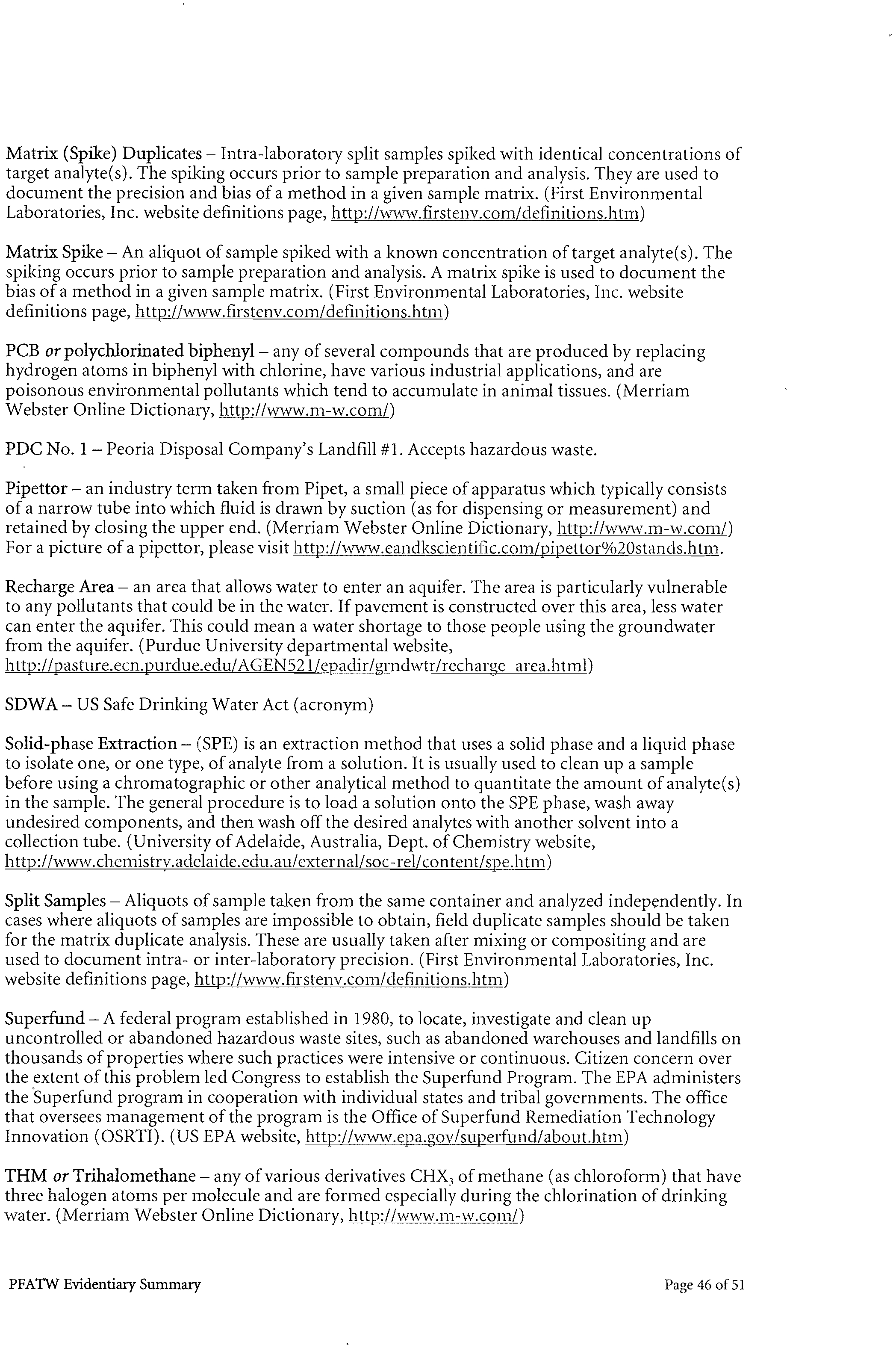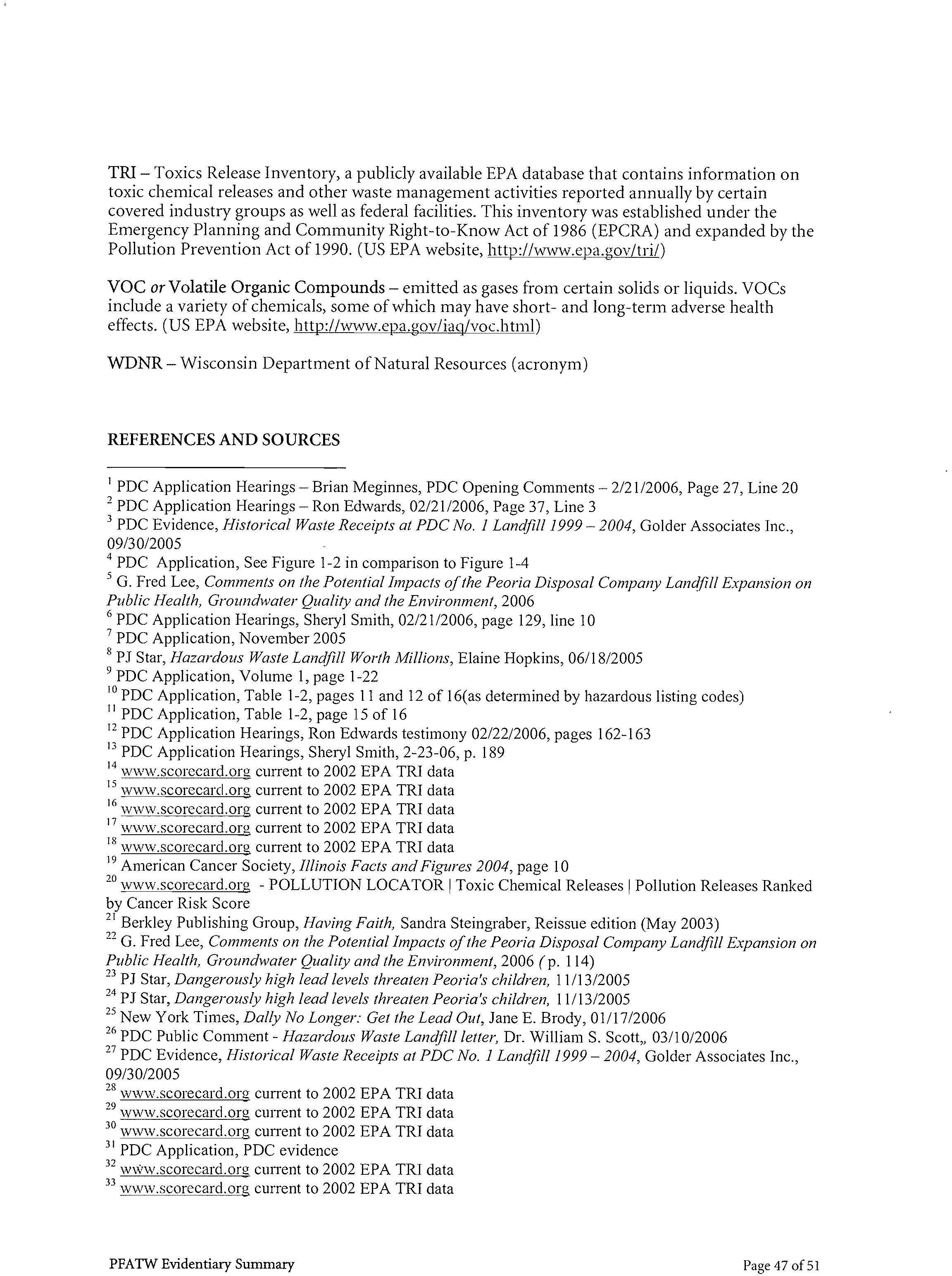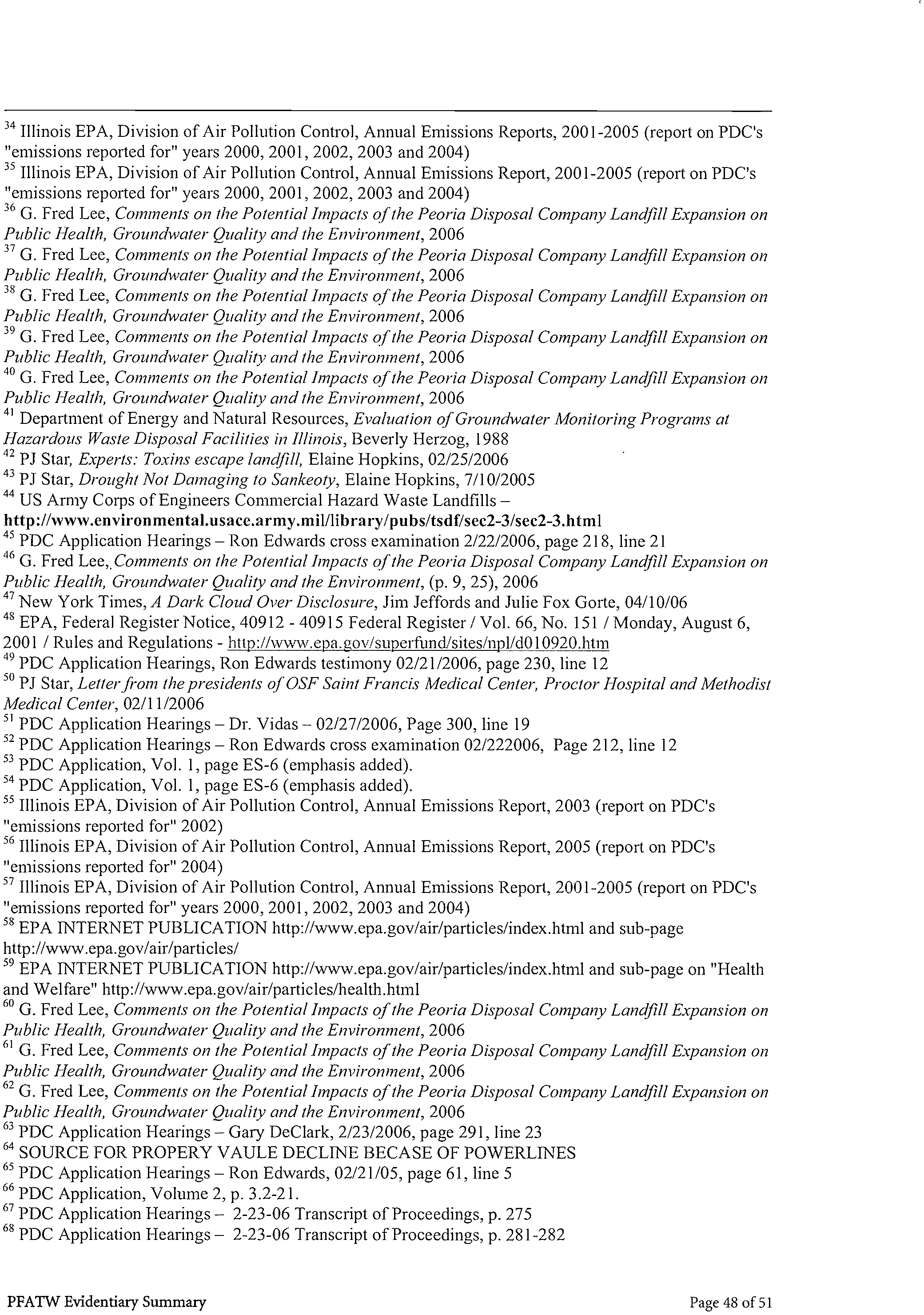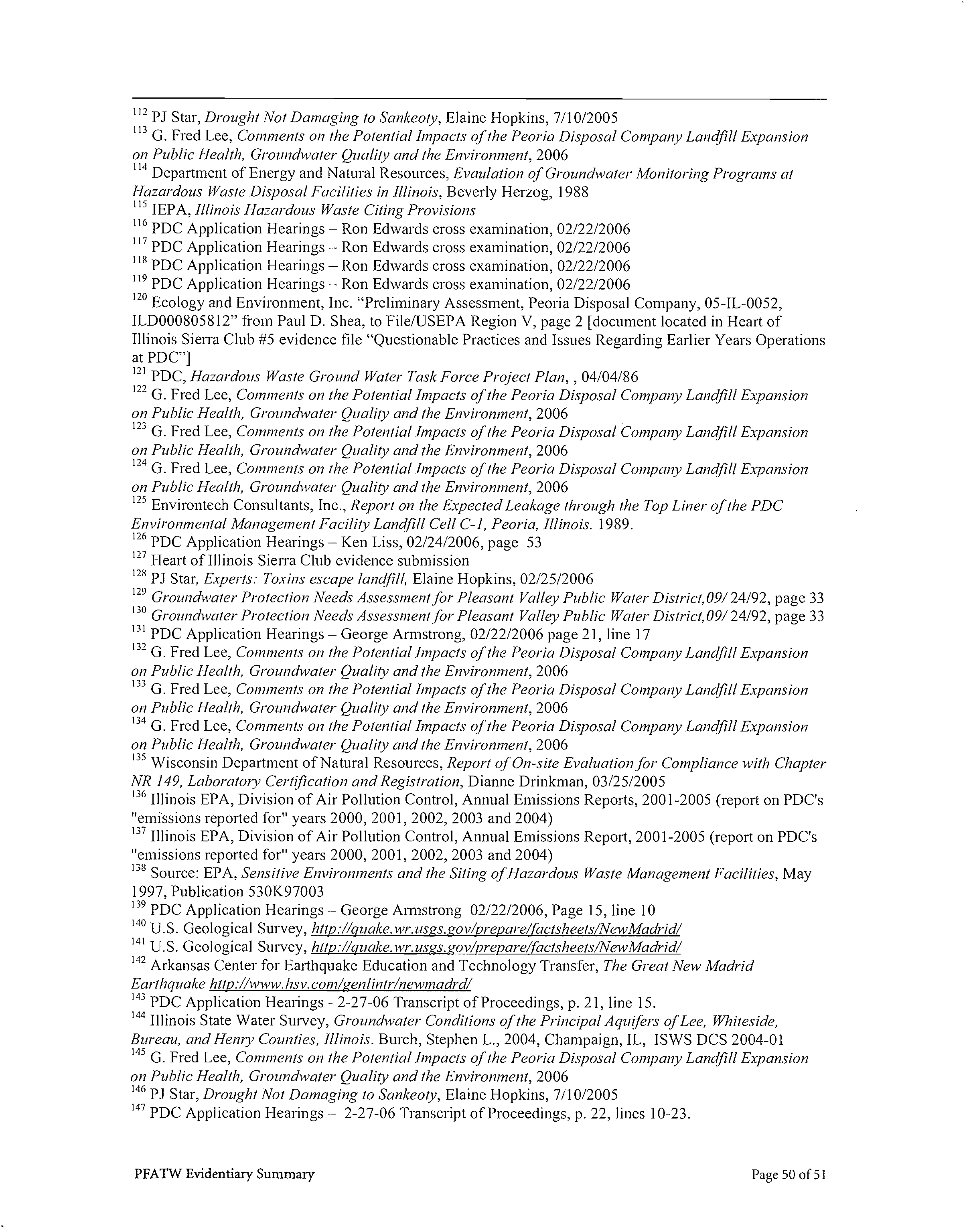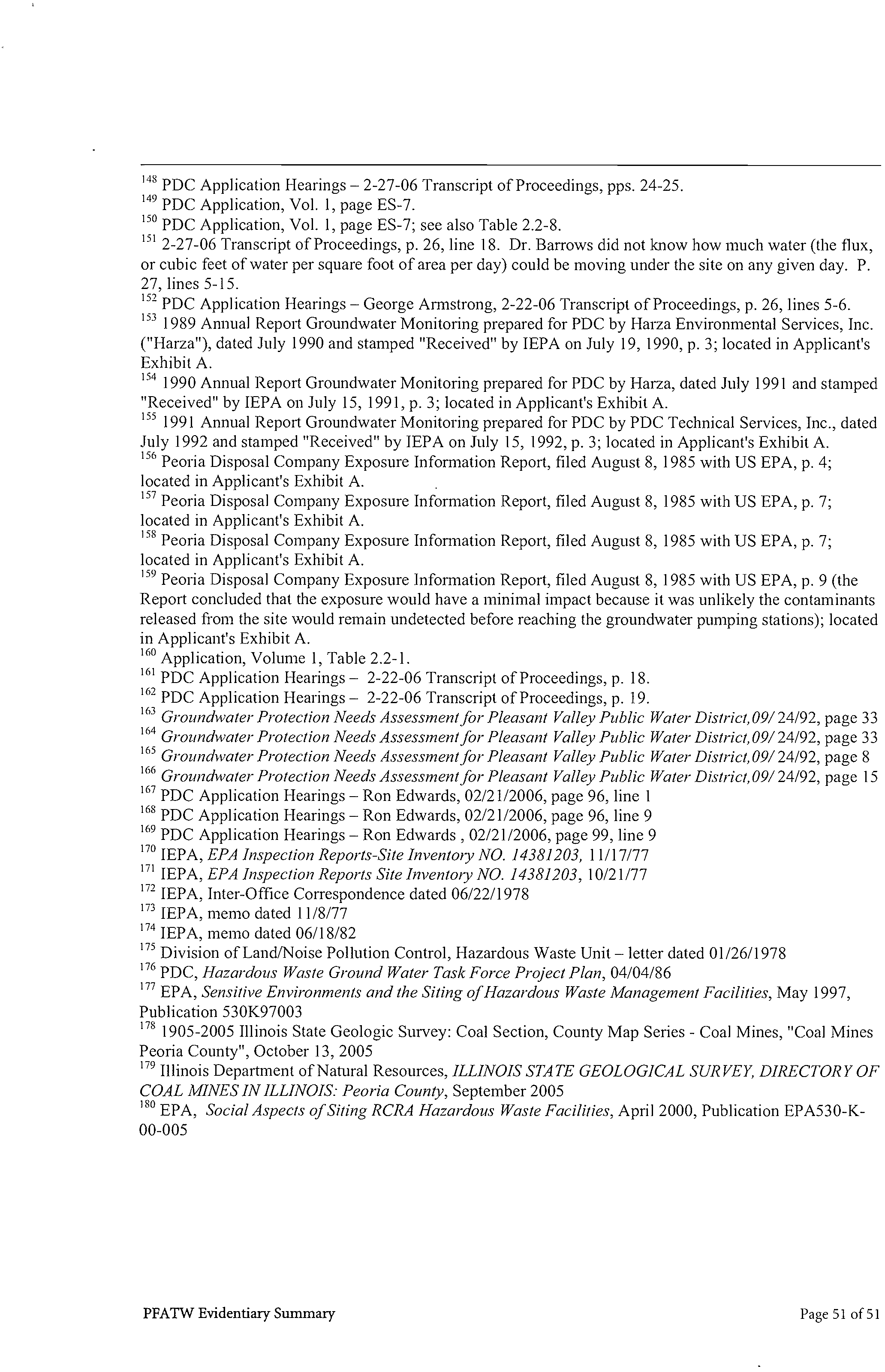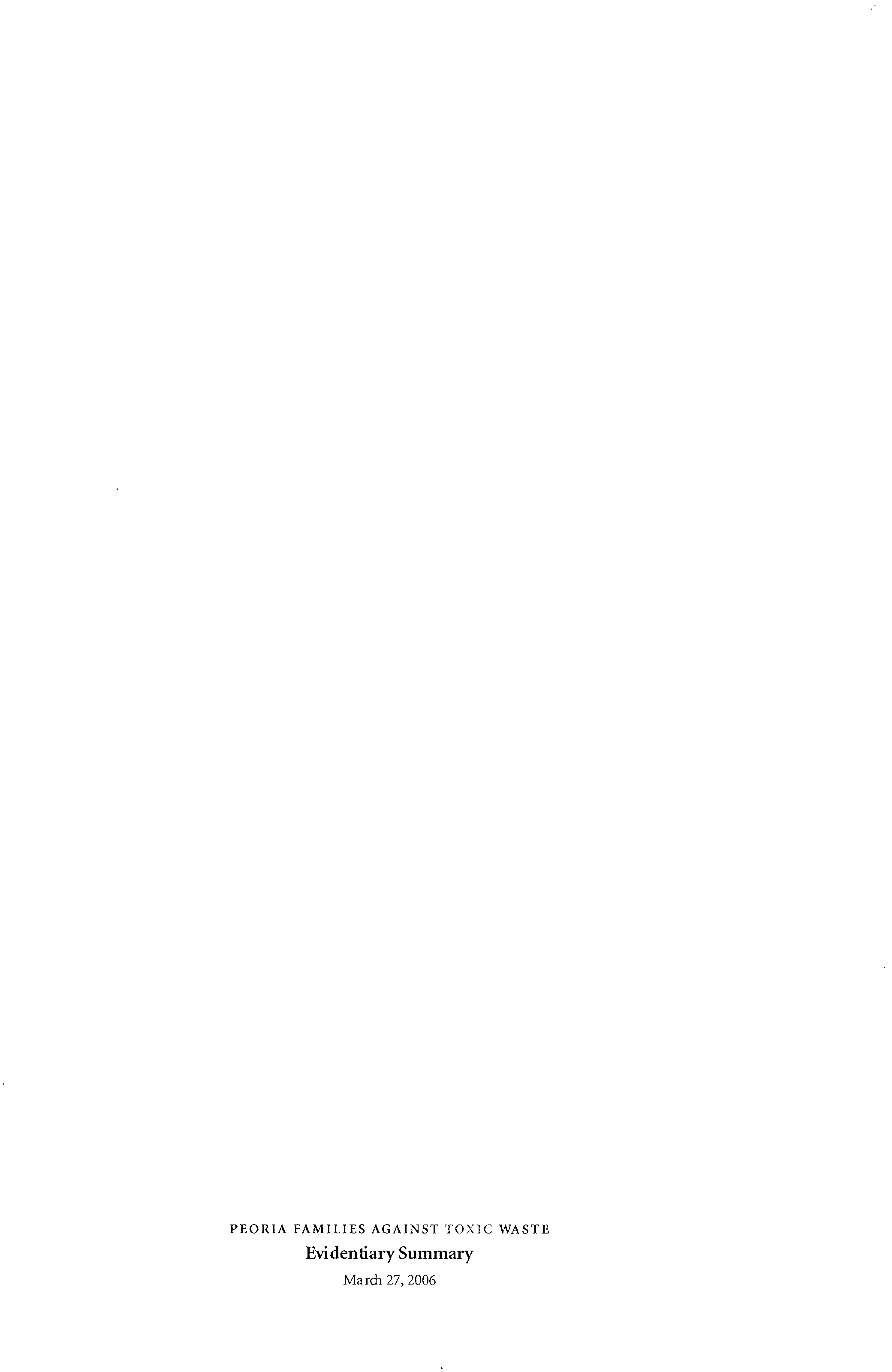Re:
Case
#
AS
08-10
1
Dear
Members
of
the
Board:
I
write
to
you
concerning
Peoria
Disposal
Company’s
proposal
to
obtain
a
delisting
of
electric
arc
furnace
dust
wastestreated
at
their
PDC
No.1
Landfill
and
waste
treatment
facility
near
Peoria,
Illinois.
I
am
opposed
to
this
delisting
on
numerous
grounds,
but
for
the
purposes
of
this
letter
I
will
confine
my
arguments
to
issues
of
the
location
of
the
waste
treatment
facility
that
would
(in
the
event
that
their
request
is
granted)
remain
open
indefinitely.
The
Peoria
County
Board
denied
PDC’s
application
to
expand
its
hazardous
waste
landfill
due
to
concerns
regarding
the
landfill’s
proximity
to
densely
populated
areas
of
Peoria
and
its
position
above
the
aquifer
from
which
Peoriaand
many
other
central
Illinois
communities
draw
drinking
water.
These
concerns
pertain
as
well
to
PDC’s
proposed
activities
should
it
obtain
this
delisting.
Truck
traffic
bringing
loads
of
dusty
hazardous
material
through
our
communities
to
PDC#1
would
continue
for
longer
and
at
an
increased
rate
over
what
would
be
expected
if
the
waste
continued
to
be
classified
as
hazardous
and
landfilled
accordingly.
Indeed,
if
PDC
succeeds
in
their
efforts
to,
in
effect,
self-delist
so
they
can
accept
wastes
from
generators
not
listed
in
this
application
then
such
traffic
could
increase
greatly
on
a
daily
basis
and
extend
indefinitely
into
the
future.
In
their
Technical
Support
Documents
PDC
projects
an
anticipated
200-300
tons
of
EAF
dust
coming
in
to
the
facility
on
a
daily
basis,
just
from
the
generators
listed
in
the
proposal.
It
could
be
much
more
if
theyare
allowed
to
accept
wastes
from
new
generators
withoutapproval,
as
they
are
proposing.
Increased
traffic
brings
an
increased
risk
of
accidents
and
spills.
This
summer
alone
in
Peoria
County
there
have
been
two
truck
spills
that
have
appeared
prominently
in
local
papers
(and
likely
others
that
have
not
received
such
press
coverage):
a
truckload
of
gravel
overturned
in
downtownChillicothe
at
the
intersection
of
Route
29
and
Truitt
Ave.;
and
a
tanker
truck
full
of
lye
skidded
onto
its
side
on
Route
24nearthe
interchange
with
1-474.
Just
last
month
a
truck
hauling
waste
to
PDC’s
DeWitt
County
Landfill
(a
listed
potential
recipient
of
the
proposed
delisted
EAF
dust)
overturned
just
outside
the
landfill’s
gates.
So
truck
accidents
and
spills
in
the
area
are
not
just
remote
hypotheticals,
but
fairly
regularly
occurring
events.
If
the
trucks
were
traveling
to
some
remote
location
far
from
the
city
limits
it
would
still
be
a
concern;
however,
PDC
No.1
sits
directly
on
the
edge
of
the
city
of
Peoria.Peoria
has
at
least
23
schools
and
five
daycare/preschools
within
3
miles
of
the
landfill.
OSF
and
Methodist
hospitals
are
approximately
three
and
a
half
miles
and
Proctor
hospital
is
just
over
four
miles
from
the
landfill.
53,000
citizens
live
within
three
miles
of
the
landfill,
and
largely
east
and
downwind
of
it.
A
spill
of
dusty
waste
on
a
breezy
day
would
send
clouds
of
dust
laden
with
lead,
hexavalent
chromium,
and/or
other
heavy
metals
drifting
over
and
into
some
of
the
most
densely
populatedneighborhoods
in
Peoria—
neighborhoods
that
arehome
to
some
of
our
most
vulnerable
citizens.
facility
knew
what
was
drifting
through
theirneighborhoods
and
public
parks
and
through
the
open
windows
of
their
homes,
schools,
and
nursing
homes—especially
considering
it
took
a
FOIA
request
for
us
to
discover
it?
Should
this
delisting
be
approved,
these
sorts
of
insults
to
the
systems
of
thousands
of
of
Peorians
would
be
repeated
indefinitely.
Not
only
must
we
have
clean
air
to
breathe,
but
we
also
need
clean
water
to
drink.
While
thedelisted
treated
EAF
dust
waste
is
not
proposed
to
be
landfilled
(by
and
large)
at
PDC
#1,
it
will
be
treated
there
and
held
for
testing
and
curing
there.
Activities
related
to
the
waste
treatment
facility
should
this
delisting
be
approved
will
only
make
aquifer
contamination
by
the
already-landfilled
hazardous
waste
more
likely.
In
the
Technical
Support
Document
for
their
delisting
proposal,
PDC
describes
how
the
treated
waste
will
be
moved
to
a
storage
area
in
25
cubic
yard
rolloff
boxes
or
168
cubic
yard
gondola-style
railboxes
to
await
testing,
or
(having
failed
initial
testing)
to
cure
for
a
period
of
time
before
retesting.
These
very
large,
very
heavy
containers
will
need
to
be
moved
by
very
large,
very
heavy
equipment.
The
storage
area
PDC
proposes
to
use
is
portions
of
landfill
cells
0-1,
0-2,
and
C-3.
According
to
PDC’s
estimates,
each
rolloff
box
holds
37.5
tons
of
treated
waste,
and
each
gondola
box
holds
252
tons
of
treated
waste.
With
an
anticipated
daily
output
of
treated
waste
of
300-450
tons
(again
using
PDC’s
own
numbers),
that’s
between
8
and
12
trips
across
the
closed
landfill
cells
hauling
a
37.5-ton
rolloff
container
every
day.
PDC
plans
to
transfer
the
waste
using
articulated
off-
road
trucks
when
gondolas
are
used
for
storage.
These
trucks
range
in
size
from
about
25
to
40
tons,
and
hold
about
as
much
as
they
weigh.
Therefore,
there
could
be
as
many
as
18
50-ton
trips
or
11
80-ton
trips
across
the
closed
cells
every
day.
I
am
very
concerned
about
the
repeated
compaction
and
wear
and
tear
to
the
landfill
cells
of
driving
these
heavy
machines
and
heavy
loads
back
and
forth
over
them
on
a
daily
basis.
This
does
not
even
go
into
the
loading-out
for
disposal
using
track-type
excavators
and
tractor-dump
trailers,
all
of
which
will
be
maneuvering
over
these
closed
landfill
cells.
I
am
also
concerned
about
the
additional
weight
of
the
stored
material
on
the
closed
cells.
From
the
Technical
Support
Document
it
appears
that
PDC
anticipates
successfully
treated
waste
being
in
storage
on-site
for
a
day
before
being
loaded
out
for
disposal
at
another
landfill.
However,
it
seems
they
anticipate
fairly
regularly
having
to
keep
batches
of
treated
waste
in
storage
for
further
curing
before
it
is
acceptable
for
landfilling—they
obtained
a
modification
of
their
operating
permit
from
the
IEPA
to
increase
the
amount
of
time
treated
waste
may
be
stored
prior
to
re-treatment
from
15
to
60
days.
There
does
not
seem
to
be
any
overall
storage
time
limit;
in
other
words,
it
appears
that
if
a
batch
requires
retreatment,
it
can
be
held
60
days
before
being
retreated,
then
held
again
for
60
days,
etc.etc.
So
at
a
bare
minimum,
there
would
be
1
day’s
output,
or
8-12
rolloff
boxes
or
1-2
gondolas
stored
on
the
closed
landfill
cells
every
day,
for
an
additional
weight
of
300-450
tons.
However,
there
are
quite
likely
to
be
more.
A
week’s
worth
of
treated
waste
waiting
to
cure
and
be
retested
would
be
40-60
rolloff
boxes
or
5-10
gondolas,
for
a
total
of
1,500-2,250
tons.
If
every
batch
stays
in
storage
for
45
that
PDC
had
encountered
a
sand
lens
digging
cell
C-i,
and
that
they
were
unable
to
find
the
bottom
of
it.
Sand
lenses
can
be
a
direct
route
into
the
aquifer
below.
Cell
C-I
was
built
over
two
sand
lenses
encountered
in
construction
of
the
cell.
Repeated
hauling
of
heavy
loads
backand
forth
across
this
already
compromised
area
only
increases
the
chances
of
a
breach
and
the
contamination
of
the
source
of
60%
of
Peoria’s
drinking
water.
A
map
showing
the
location
of
the
sand
lenses
is
enclosed
with
this
letter.
Because
it
has
been
stated
that
this
delisting
proposal
would
be
considered
separately
from
PDC’s
earlier
expansion
application
and
related
filings
and
arguments,
I
am
enclosing
with
my
letter
an
Evidentiary
Summary
prepared
by
Peoria
Families
Against
Toxic
Waste
in
response
to
that
expansion
application.
I
do
so
because
many
of
the
same
concerns
are
relevant
to
this
delisting
proposal,
in
particular
issues
involving
compatibility
with
the
surrounding
area,
airpollution
emissions,
and
potential
contamination
of
the
Sankoty
Aquifer.
This
summary
is
well-researched
and
fully
footnoted.
This
delisting
would
pose
a
long-term
threat
to
the
health
of
local
residents
through
both
air
and
water
pollution,
all
to
gain
profit
for
a
few
shareholders
of
Peoria
Disposal
Company
and
cost-reduction
for
companies
largely
outside
of
Peoria
County
(and
even
Illinois),
some
of
whom
are
owned
by
companies
outside
of
the
United
States.
The
tens
of
thousands
of
citizens
of
central
Illinois
who
depend
on
clean
air
to
breathe
and
clean
drinking
water
from
the
Sankoty
Aquifer
deserve
better
than
to
be
endangered
for
someone
else’s
profit.
We
are
depending
on
you
to
deny
this
delisting
request.
Sincerely,
Lisa
K.
Offutt
10629
N
Moss
Street
P0
Box
222
Mossville,
IL
61552-0222
end:
map
of
sand
lenses
beneath
Cell
C-i
Peoria
Families
Against
Toxic
Waste
Evidentiary
Summary
PEORIA FAMILIES
AGAINST TOXIC
WASTE
Evidentiary
Summary
March 27, 2006
(excerpt from the)
PEORIA COUNTY
BOARD STRATEGIC PLAN:
“The Strategic Plan includes avision
statement and guiding principles to
help
maintain focus on long-term goals. The incorporated
principles that guide our vision serve
as a checks and balances system
for
all policies, decisions, plans and actions.
If a policy does not meet the standards
set forth by our guiding piinciples, then the policy
does not refl ect our vision for the future and shall not
be
implemented.”
VISION
STATEMENT:
“Our residents live in a safe environment
and have an opportunityfor healthy living’
TABLE
OF
CONTENTS
Introduction
.4
Decision
Criteria
6
Criterion
1: The
facility
is
necessary
to
accommodate
the
waste
needs of the
area
it is
intended
to serve
7
Criterion
2: The facility
is
so designed,
located
and
proposed to
be
operated that the
public
health,
safety and welfare will
be protected
11
Criterion
3: The facility is located
so as to minimize
incompatibility
with
the character
of the
surrounding area
and
to minimize
the effect
of
the
value of surrounding
property
18
Criterion 4: The facility
is located
outside the boundary
of
the 100-year
flood plain
or
the
site is
flood-proofed
23
Criterion
5: The plan of
operations for the facility
is designed to
minimize
the
danger
to the surrounding area
from fire, spills,
or other operational
accidents
24
Criterion
6: The traffic
patterns
to
or from the facility
are
so designed as
to minimize
the
impact on existing
traffic flows
26
Criterion 7: If
the facility
will
be treating, storing
or disposing of hazardous
waste,
an emergency response
plan exists
for
the facility,
which includes
notification,
containment
and evacuation
procedures
to
be
used in case of
an accidental release
28
Criterion
8: The facility
is consistent with the
County
solid
waste management
plan
30
Criterion
9:
That
if
the facility will
be located within a regulated
recharge
area,
any applicable requirements
specified
by the Board for
such areas
have
been met
32
Previous operating
experience
and past record
38
EPA
Recommendations
40
Opposition
to the Landfill
Expansion
43
Conclusion
44
Glossary
45
References
and
Sources
47
PFATW
Evidentiary
Summary
Page 3 of 51
INTRODUCTION
Recently, Peoria
Disposal Company
(PDC)
filed for an expansion
of its hazardous
waste
landfill.
This expansion would
expand the current
32.4-acre
facility by eight additional
acres and
allow a
vertical
expansion of an additional
45 feet.
PDC’s
current
landfill
will reach capacity
in about four
years. Their
recent application for expansion
will extend
the
operation
of the facility
beyond that
by an additional
15 years
or
more.’
Peoria Families Against
Toxic Waste
(PFATW)
consists of a concerned
group of Peoria
County
citizens who care about
our
community.
We are
ordinary
people. We have
different backgrounds,
different
political
views and different
income levels,
but we are united
on one point—to
see that
the
PDC landfill local siting
measure
is not
approved
by the
Peoria County
Board.
We do not
make our
money
in the hazardous
waste business. Unlike
PDC, which
will make many
millions of dollars if this
measure
passes,
we will receive
no financial gain regardless
of the outcome
of this measure.
This Document
Peoria Families
Against Toxic Waste
(PFATW)
prepared
this document
to directly address
the
criteria that the county
board must evaluate
when deciding
this
issue.
We
have addressed each criterion
individually.
Each criterion
starts with a list of sourced
facts and
figures,
followed
by
a summarization of those
facts. Our conclusions
are
based on evidence
submitted
by
PFATW,
PDC, the
original PDC
application
and hearing testimony.
We realize that technical
terms like “TRI”
and “Recharge
Area” may
be new to some people
reading this document.
We have included
a glossary
to help
demystify
the language.
A lot
of this data overlap
the nine criteria.
Please
do not feel
the need to confine
a fact to a
particular
criterion, as it may also
apply
to others.
Our goal
was
to make the document
readable
and organize
the information
logically for you.
Our Concerns
Why
are we against this
measure? The document
goes into
detail on each point,
but we
summarize them
here in order of greatest
concern.
Health
(Criterion 2)—Our
primary concern
speaks to the
health issues related
to the site.
We share
the concern of Peoria’s
medical community
that the risk
is too great. Submitted
evidence
shows that
PDC’s
hazardous waste
facility puts our citizens’
health
at risk. PDC is
polluting our environment
and this
type
of pollution
has been shown
to
have
a damaging
effect on the
human body. The
risk is too great.
Groundwater Protection
(Criterion
9)—The Sankoty Aquifer
provides drinking
water to
264,000
people. Part of this
fragile water system
lies
directly beneath
the PDC landfill.
The
poor choice
of the
landfill
location
puts
a
heavy
burden on the
barrier
that
separates
our
drinking water
from the
thousands
of tons of
toxins that PDC accepts
annually.
As
you will
see,
experts disagree on how
long
this barrier
will be able
to
protect
our aquifer. No
one
disputes the fact
that the liner
will
fail.
Property Values (Criterion
3)—PDC
has claimed that
property values will not
be affected by
its
operations.
Industry experts,
history and common
sense disagree.
The fact that PDC
has
been
processing
hazardous
materials at its
site was largely
unknown to most of our
citizens.
But
that has changed
in recent months.
This new knowledge
that
an
active
hazardous waste
facility
operates within
a few miles from the majority
of homes
in Peoria will have
an
impact
on property values.
PFATW Evidentiary Summary
Page
4 of5l
These
are our
main
concerns,
but we
also
present
strong
cases
that
speak to
the other
criteria.
We
back up
our
views
with industry
experts
including
Dr.
G.
Fred
Lee.
Dr.
Lee is
a nationally
recognized
scientist
and
expert
in hazardous
waste
evaluation
and management.
He has
conducted
contract
and
grant
research
and prepared
affidavits/declarations
for hundreds
of
companies,
government
entities
and
organizations
in the
United
States
and
Canada.
Dr. Lee
talks
directly
to
technical
issues
regarding
this
expansion
proposal,
and his
analysis
highlights
weaknesses
in
PDC’s
plan.
Looking
Forward
We respect
the role
of the
county
board
in this
decision-making
process
and trust
that
you
will
make
your
decision
based
on the
best
interests
of the
constituency
that
elected
you.
vVe have
a
deep
concern
for
the people
and businesses
in this
community.
The
facts
are clear.
This
expansion
initiative
will be
bad
for our
county,
not
only in
the short
term,
but for
many, many
generations
to come.
Long
after
this
decision
is
made,
long after
PDC
No.
1 has
closed,
long after
the
liners
fail,
the
toxins
that
are being
buried
will still
be present
in
our community.
You can
change
this.
Peoria
County
can have
cleaner
air,
land,
and water.
This
can be a
healthier
place to
live. Industry
can thrive
here.
Property
in Peoria
can
be a desired
commodity.
We
can
hand
our future
generations
a
legacy they
will
be
proud
of.
Please vote
not only
with
your constituents
in mind
but
also
knowing
that
the
future
and
well-being
of your
children,
your
grandchildren
and
ours
is at
stake.
PFATW
Evidentiary
Summary
PageS
of
51
DECISION
CRITERIA
An applicant
for local siting
approval shall
submit sufficient details
describing
the proposed
facility
to
demonstrate
compliance, and
local siting approval
shall
be
granted only if the
proposed
facility meets
the following
criteria:
(1)
The facility is necessary
to accommodate
the waste needs
of the
area
it is intended to
serve.
(2) The
facility is
so designed,
located and
proposed to be operated
that
the
public health,
safety and
welfare will
be protected.
(3)
The
facility is located
so
as
to minimize
incompatibility
with the character of
the
surrounding
area and to
minimize
the
effect on
the
value
of the surrounding
property.
(4) The
facility is located outside
the
boundary
of the 100-year
floodplain, or the site is
flood-proofed.
(5) The plan
of operations for
the facility is designed
to
minimize
the danger to
the
surrounding area from
fire,
spills or other
operational
accidents.
(6)
The traffic
patterns
to or from the
facility are so designed
as
to minimize
the impact on
existing
traffic flows.
(7)
If
the facility will be
treating, storing
or disposing of hazardous
waste, an
emergency
response
plan exists for the facility,
which includes
notification,
containment and
evacuation
procedures
to be used in case
of an accidental release.
(8) The facility is
consistent with
the county’s solid waste
management
plan.
(9)
If the facility
will
be located
within a regulated
recharge area, any applicable
requirements
specified
by the board for
such areas have been
met.
The county board
or the
governing
body of
the municipality
may also consider
as
evidence
the
previous
operating experience and
past
record
of
convictions or admissions
of violations
of the
applicant (and any subsidiary
or parent
corporation)
in the field
of solid
waste
management when
considering criteria (2)
and
(5) under
this Section.
Local
jurisdictions, like Peoria
County, may
impose stricter
standards or require additional
criteria
to be met to achieve
local siting
approval,
as long as the additional
locally
imposed criteria
are not
inconsistent
with the Illinois Environmental
Protection
Act. One example
of this is Peoria
County’s requirement
that the
Applicant
provide detailed financial
planning
and technical
information
for the perpetual care of
the site after
closing.
Peoria County
Code Section 7.5-38(e).
This
is in effect the 10th criteria.
PFATW Evidentiary Summary
Page
6 of5l
CRITERION
1:
The
facility
is
necessary
to
accommodate
the
waste
needs
of
the
area
it
is
intended
to
serve.
What
is
the
“area
intended
to
serve”
and
how
well
is
PDC
meeting
its
needs?
PDC’s
Vice
President
of
Development
and
Operations,
Ron
Edwards
stated
in
his
testimony
that
the
intended
area
was
local.
He
says:
“Why
is
hazardous
waste
here?
Problem,
local
industry
such
as
Caterpillar,
Keystone,
International
Paper,
International
Harvester,
Sherex,
and
others
such
as
John
Deere,
had
a
problem,
our
waste
is
suddenly
being
regulated
and
we
have
nowhere
to
go,
who
will
take
care
of
it
for
us.
We
will
have
to
close
our
operations
or
at
best
haul
the
waste
for
long
distances.
Solution,
PDC
again
responded
to
its
customers
in
the
advancements
of
environmental
protection
in
Peoria
County.”
2
In
2004,
only
9.5
percent
of
all
hazardous
waste
that
PDC
accepted
came
from
Peoria
County,
with
the
trend
in
a
clear
downward
direction.
The
majority
of
the
remaining
90.5
percent
are
transported
from
other
states.
3
This
translates
into
approximately
107,300
tons
of
hazardous
waste
that
is
accepted
each
year
by
Peoria
County,
from
non-local
companies.
The
remaining
fraction,
11,250
tons,
is
generated
locally.
93.00%-
83.00%
-
7100%-
63.00%-
5300%-
43.00%
33.00%-
23.00%
13.00%
3.00%
Percentage
of
Local
and
Non-Local
l-azardouc
Waate
Accepted
at
PDC
No.
I
[
c
Peotia
County
Hazardoio
Waste
Hazardous
Waste
shipped
in
Irons
oidsicie
Peoria
County
What
about
distance
and
cost?
•
It
is
closer
for
Peoria
generators
to
go
to
Indiana,
Ohio
or
Michigan
than
it
is
for
a
significant
number
of
PDC’s
current
customers
to
come
to
Peoria
County.
4
•
Since
a
substantial
part
of
the
hazardous
wastes
that
PDC
has
been
accepting
and
proposes
to
continue
to
accept
is
from
non-local
(non-Peoria
County)
sources,
the
Peoria
County
public
is
being
exposed
to
hazardous
chemicals
that
more
appropriately
should
be
managed
in
the
vicinity
of
their
sources.
•
A
nearby
hazardous
waste
facility
in
Indiana
could
readily
accept
our
local
waste
for
an
additional
transportation
cost
of
$30
per
ton.
6
-
PDC
has
only
recently
offered
the
county
a
token
sum
of
$1
per
ton
as
con3pensation’—far
below
typical
industry
rates.
8
103
00%-
PFATW
Evidentiai-y
Summary
Page
7
of
51
PDC
has competitors!
•
Hazardous waste
facilities
in
Indiana and Ohio
recently received expansion
permits.
9
PDC
receives waste from
27 Indiana generators.’°
PDC accepted waste
from
Ohio, another
state with
its own
facility.H
•
Ron Edwards testified that
PDC could
look
to
different
business models toward
the
end of the
15 year expansion.’
2
PFATW
Evidentiary
Summary
Page
8
of5l
CRITERION I—SUMMARY
Is
PDC meeting
the waste
needs of the industries
in our county?
It appears that our local companies will be negatively
affected if this expansion
measure
passes.
Here’s why:
The lifespan
of the
current
landfill is four years.
The reason? PDC accepts a huge
percentage
of
waste from non-local sources. If non-local
waste is taken
out of the equation, the landfill’s lifespan
reaches
about 33 years -- without the expansion
approval. PDC expects the landfill
to
reach
capacity
in 19
years with
the expansion. This means
local business will lose roughly
another 14
years
of use if the
measure
passes. This is bad for
local industry.
Related to the previous point, PDC’s self-serving
“accommodation” or voluntary
restriction
number
7, to
guarantee
capacity of Peoria County waste
for 15 years, is illusory. The expected life
of the expanded facility is
just that—15 years.
Add
to
this
the
fact
that
the numbers clearly show that
the receipt of local hazardous waste
is on a
steady decline and the impact of the
expansion may be even worse. It
appears that local businesses
are doing their part to keep our environment
clean by reducing hazardous
waste production, and
PDC
is responding
by
reaching
out to new markets
to
increase
the amount of hazardous material
that it imports into our county. Each shipment
increases PDC’s profit
at the expense of Peoria
County.
A key point to remember is less than one tenth
of all hazardous materials that PDC
dumps in our
county isfroni local companies.
PDC downplayed
the
fact that Indiana has an operating
hazardous waste site, which charges
less
than PDC to accept waste. Their argument
that local businesses would
be charged
$30
per ton for
transportation did not take
into account the fact that the
competition may have lower rates. This
difference could
drive
the
$30
per ton figure
much lower.
PDC was merely speculating
on
a cost increase to local generators if
the expansion request is
denied. No total cost or total volume picture or
information was given by PDC at any time
during
the hearing or in its Application. For
“proprietary” reasons, PDC intentionally
kept any such
information out of the application
process. PDC did inject disposal
costs
into
the application
process - not
about PDC’s
own cost and volume structure,
but about that of others, especially
Keystone Steel and Wire. Speculative and
incomplete testimony was given
about potentially
increased
transportation
costs if the expansion request is refused.
But
there is no way to quantify
or prove a
total cost differential
(including transportation
costs) when no evidence on disposal
fees or disposal volumes is in the record.
It’s important to remember that the states
PDC intends to serve can
be
served well
by other
hazardous
waste landfills. And just like waste
producing companies in the
ten
states in question,
our
local companies will survive
without a hazardous landfill
in their own county. PDC failed to
establish in its Application or at the hearing
that there is an urgent need
to expand the PDC
facility
when other hazardous
waste landfills exist in the
Midwest.
PDC’s retained consultant, Sheryl Smith,
admitted that in the 24 times
she has been retained by
landfills
in a
siting application
process, she had always
found a need for the landfill
to
exist)
3
PDC, and Sheryl Smith, defined the
intended service area
to
exclude
Indiana, a state with a
hazardous waste disposal facility.
This is manipulative
at best given the fact that PDC accepted
significant quantities of hazardous waste,
non-hazardous waste and special
wastes from Indiana
during the
same 1999 to 2004
study period. Indiana
generated waste included electric arc furnace
dust from ISPAT Inland Steel and
Nucor
Steel, as well as 25 other Indiana
generators. PDC also
accepted waste from Ohio, another
state with its own facility.
PFATW Evidentiary Summary
Page
9
of
51
There was no testimony that Indiana, Michigan
or Ohio facilities would
be
incapable
of providing
disposal service for Peoria County generators,
or for that matter, any generator in the Applicant’s
defined intended service area. In Indiana
and Ohio, the hazardous waste
disposal facilities recently
received
expansion permits. There is no evidence
that regional facilities and disposal alternatives
other than PDC will cease to exist any time in
the future. It is closer for Peoria generators
to go to
Indiana, Ohio or Michigan than it is for a significant
number of PDC’s current customers to come
to Peoria County. Based on the existence
of significant, recently expanded and nearby capacity
on
a regional basis, there is no urgent need to expand
PDC’s Peoria County facility.
PDC would still have a role in hazardous
waste disposal even if the Application is
denied. Ron
Edwards testified that
upon
reaching capacity at the landfill,
PDC would transition into “other
ways of helping customers manage their
wastes
PDC’s expertise and brokerage capabilities
would enable them to still have a significant role in servicing
the hazardous waste disposal needs
of Peoria County generators.
Peoria County has done its share. Enough is
enough.
PFATW
Evidentiary Summary
Page 10 of 51
CRITERION
2:
The facility
is so designed, located
and proposed
to be operated that
the
public health,
safety and
welfare
will be protected.
Peoria
County is
actively
being
polluted.
Peoria
has
some of the worst
pollution scores in
the state and nation:
•
National:
Peoria
County
is
the third
worst county in
the United States for
cadmium.
14
•
National:
Peoria
County
is the
16” worst
county in the United
States for Toxic
Release
Inventory (TRI) chemical
releases.’
5
•
National: Peoria
County ranks
24th
in the nation
for lead TRI)
6
•
State:
Peoria County is
the No. 1 worst county
in
Illinois for
TRI chemical releases.’
7
•
State:
Peoria
County is the fifth
worst county in Illinois
for
TRI
air releases.’
8
This
pollution
affects our citizens’
health.
The
American
Cancer
Society
indicates
that Peoria
County
is
“significantly
higher
than
state
average” in
cancer
incidences)
9
From
1998 to
2002 there
has
been a
1073
percent increase
in total
cancer
risk
scores.
2
°
Studies have
shown a significant
increase
in the incidence
of birth
defects with proximity
to
a hazardous
waste landfill.
Sandra
Steingraber,
Ph.D.
is an internationally
recognized
expert
on
the
environmental
links
to
cancer and
threats to reproductive
health. She
states:
“As the
distance
between
waste
site and place
of
residence
increases, the
chances
of birth
defects
consistently
decreases.”
2
’
Dr.
Lee’s
report
mentions:
“An
issue
of
concern is
whether those who
live near
landfills show
evidence
of
adverse health
effects. It is known
from a number
of
studies
conducted
by the
Centers
for
Disease
Control and Prevention
(Anderson,
pers. comm.,
1999)
that
some
populations
living near
landfills
have
shown
a greater
incidence
of
some
diseases
22
OAvege 4818
15 percent of
Peoria
s children
have
been
diagnosed with
lead poisoning
the highest
in
the nation.
2
A recent
PJ Star article
about
lead
poisoning in Peoria stated:
“It’s likely
in your bloodstream.
It’s probably
in your child’s.”
24
There is no safe
threshold for
lead
levels in blood.
25
OSHA has recently
lowered
its Permissible
Exposure
Limits for workers
to hexavalent
chromium
by a factor of
100.26
U
Illinois
Incidence
Rates
by
County, 1996
— 2000
481.7
932
.;o
“45.16.
86.9
‘io
•,
-‘
383.9
485.6
;99.9
467.1
505.6
-
506.0
3526
-
5088
.275
.:79
.7
‘9
.$)1
i’;.3•
:
PFATW Evidentiary
Summary
Page 11
of5l
According
to recent EPA data, PDCis actively
pollutingthe county.
•
PDC brings toxins into our county.
•
PDC accepted 118,561 tons of hazardous
waste in
2004.27
•
Here is a small sample list of these
heavy metals and their pounds
in benzene-equivalents
accepted by PDC in
2002:28
o Cadmium Compounds—130,000
pounds
o
Chromium
Compounds—33,000
pounds
o Lead Compounds—2800 pounds
PDC’s pollution
scores
•
PDC is No. 1 in Peoria
County for TRI chemical releases.
29
• PDC is No. I in Illinois for TRI
chemical releases.
3°
•
PDC is the 1
9
th
top facility
for TRI chemical releases
in
the
United States.
•
Air Pollution: In 2003 alone, PDC
released 1,533 pounds of heavy metals
into the county’s
air.
In
addition
to 88 pounds of lead, they also
released chromium, copper; manganese
and
zinc compounds
31
• Toxins entering Peoria
County via PDC are increasing.
32
PDC
#1 TRI Releases in Pounds
21
.000,00O’
20,500,000 -
20,000,000-
19,500,000-
19,000,000-
1 8,500,000 -
18,000,000-
17,500,000-,
1999
2000
2001
2002
PFATW Evidentiary Summary
Page
12 of5l
PDC is the No. 1 polluter
in Peoria County,
according
to the recent 2002
EPA TRI data:
53
2002TR1Total
ReleaseBreakdownfor
Peoria Cousty
OPeona
Cicposal#1
cantraI I Iincisupht
Company
DACI,1
Dl<e
5
stnne
Wire
&
Clod
Eapuooal0olclnchm8t
Chemical
Corp
Dlerpillar Inc.
M
000ville
Plant
mrwr
rermentotion Prods Inc.
0 Caterpillar Inc.
M aplelon Plant
Lorza Goup
0ernpton Carp.
DF&lsris
Irds.
Ire.
DlmatnrjAmeoco
Corp
UMist
Mill
Cesice Co
calerpillar
Inc. RutdterPrecesdng
Facility
Cast Tech Inc
Lf3Nelonn Corp
In 4 of the
5 years from 2000 to 2004,
PDC reported
dangerous emissions
of PM-b
pollutants
into
our
air which
exceeded
the annual allowable
emissions
established
by permit for the
waste processing facility
by the Illinois
34
EPA. Indeed, PDC’s
PM-b emissions
have been
consistently
high
for the last five consecutive
years reported,
with 2004 being
the highest.
35
This
trend is especially concerning
given
the
known risks associated
with
PM-b.
PM1O
Air Pollution
Emissions
for
PDC #1
tltinnis PFA,
OloPsiop
of Air Pollirloo Conrrol. deAul 5rrrs5IOc55
Cepord Irnyorr cr1
P0cc
ernicciocc ecrded
fm’
2002.3003.70043
15.366000
16.374800
(tons/year)
(eons/year)
a
Concerns
about the PDC
hazardous waste site
19,077000
(tons/sear)
.442478
(torls/year)
II
C-
01.2
05
-t
C-
00
001
23
PFATW
Evidentiary
Summary
Page 13 of5l
•
The PDC proposed landfill
expansion includes
the
continued
acceptance of a wide variety of
hazardous waste tpes that
are a potential threat
to
public health,
groundwater resources and
the environment.
In addition to known,
regulated chemicals,
hazardous
wastes
of the type that PDC has been
accepting and proposes
to continue to accept contain a wide
variety of unregulated,
unmonitored hazardous
and deleterious chemicals that are a threat
to groundwater quality
and nearby air quality.
•
PDC has failed to inform Peoria
County and the public about
the long-term (effectively,
forever) threat that the hazardous wastes
represent to domestic water supplies that can
be
affected
by
landfill
releases of leachate
(soluble components of the deposited hazardous
wastes)
•38
•
The
PDC
landfill
represents a near-term and long-term
threat to public health, groundwater
resources and the environment
associated with releases of hazardous
and deleterious
chemicals from the landfill.
• HDPE liners
will deteriorate and leak.
4°
The PDC landfill rests on top of an interconnected and
interwoven finger of the Sankoty
aquifer system.
4’
•
Experts on both sides agree that low levels
of contaminants from PDC No. 1 have already
penetrated into the aquifer
system below it.
42
a
Contamination from
the PDC landfill can potentially affect the
health of the people
who
use
the Sankoty as their drinking water
source.
43
a
The materials that
PDC accepts in the future may present
even more health issues for our
community.
There is no governing or regulatory
body outside of PDC that can block the
acceptance of other types of hazardous
materials in the future.
44
°
•
Dr. Lee
calls attention
to the subset of pollutants for which
PDC tests versus the number of
hazardous substances potentially present
in leachate and air emissions.
46
a
Future legislation
may relax regulations on pollution controls.
Senator
Jim Jeffords, ranking
member of the Senate
Environment and Public Works Committee commented
in The New
York Times: “Now President Bush and the Environmental
Protection Agency want to weaken the
largely successful Toxics
Release Inventory program, which requires companies
to tell the
public
how they dispose of or release nearly
650
chemicals that
may harm human health and the
environment.”
47
a
PDC actively submits
proposals to and accepts waste from Superfund sites outside
our
county.
48
49
Where does the health community
stand on the issue?
•
The medical committees of all three Peoria hospitals representing
approximately 750 doctors,
citing health risks and the proximity
to a large population center, have spoken out against
PDC
landfill expansion.’°
•
Peoria Medical Society of the American Medical Association has
passed a resolution calling
for the prevention
of
hazardous waste
landfills
being placed over aquifers. This resolution is
being considered at the Illinois State Medical Society
and the American Medical Association.5’
a
PDC failed to provide
any medical testimony or evidence to support its claim that
the
landfill
expansion will not adversely
affect the population’s health.
52
PFATW Evidentiary Summary
Page 14 of 51
CRITERION
2—SUMMARY
Welcome
to
Peoria!
The bottled
water
business
is booming.
Children
undergo
routine,
mandatory
lead
testing.
We
rank
among
the
highest
in
the
state
for
cancer.
We
are consistently
in
the highest
group
for
air,
water
and
land
pollution.
We lead
the
nation
in
lead poisoning.
And
the
trends
show
that the
situation
is getting
worse,
not
better.
Truth
be
told, Peoria
County
is polluted.
PDC
is part
of the
problem,
not
the
solution.
The
fact
that a
major
hazardous
waste
facility
is
located
adjacent
to a
major
population
center
and over
an
aquifer
system
seems
more
like
a work
of bizarre
fiction.
But it
is our reality.
PDC
routinely
trucks
toxins
into
our community,
buries
them
in
our
soil and
in
the
process
pollutes
our air
with
heavy
metals.
All
of
this
occurs
on
top
of
our
water
supply
system,
which
is
protected
by
a
barrier
that
will degrade
in time.
PDC paints
a picture
of
local industry,
working
within
the
EPA
regulations,
filtering
out toxins
before
the
material
is
released
into
the environment.
This filtered
material
is shipped
to PDC
for
safe
disposal.
Indeed,
it is
a fine
picture.
But
something’s
not
working
here.
Our
residents
are ailing
from
health
conditions
like cancer
and lead
poisoning
at
significantly
higher
rates
than
other
areas.
It appears
that
the
EPA
regulations
are
failing
in
Peoria
County.
Remember,
this
criterion
talks to
the public
health,
not
adherence
to
the EPA
regulations.
Because
of our
county’s
pollution
rankings
and
health
crisis,
our
county
board
needs
to
hold Peoria
to a
higher
standard
than
the
EPA
regulations.
And
it should.
The medical
community,
whose
job
it
is
to
treat the
health
of
the
public,
has
spoken
out
loudly
against
this
expansion
measure.
They
are
directly
affected
by
anything
that
adversely
affects
our
citizens’
health.
For
the millions
of dollars
that
PDC
has
profited,
how
many
cases
or
lead
poisoning,
cancer,
leukemia,
etc.,
have
we endured?
Zero?
One?
Ten?
One
hundred?
One
thousand? More?
We
may
never
know.
The
future
may
be
even
more concerning.
PDC
currently
limits
its business
to certain
toxins.
This can
all
change,
without
any
oversight
outside
of
PDC.
Although
it currently
doesn’t,
the
landfill
can
accept
materials
such as
PCBs
and
dioxins.
These
items
would
add
a
whole
new set
of health
risks to
a community
already
struggling.
The only
thing
that would
prevent
PDC
from
bringing
these
toxins
into
Peoria
County
is
a
committee
made
up
of, and
paid
by,
PDC.
There
are
no
provisions
for
an independent
committee
to review
such
matters
in
the future.
There
is no
check
and
balance
for the
citizens
of
Peoria
County.
Since
a
major
part
of
the
health
issue
concerns
the possibility
of
groundwater
contamination,
we
encourage
you
to
review
our
concerns
on
the
ninth
criteria.
That
section
describes
the
fragility
and
importance
of the
Sankoty
aquifer
and
calls
out
problems
with
how
PDC
has
handled
the
challenge of keeping
our
water
supply
uncontaminated.
The
Peoria
County
Board
must
make
the
decision.
Decisions
about
the
protection
of
the
public
health,
safety
and
welfare
of
our
community
are solely
within
the
province
of
our
elected
representatives
on
the Peoria
County
Board.
PFATW
Evidentiary
Summary
Page
15
of 51
It is the
same
water we
drink. Complete protection
of
public water
supplies and
the groundwater
that feeds them
demands
a
heightened sensitivity
and thoroughly critical
review
of
the pending
Application.
The Peoria
County Board is entitled
under the
law to deny the Application
if
the
Board determines
that the proximity
of the landfill
expansion
to
the interconnected
Sankoty/Shelbyville
aquifer
creates a present or
future public health
concern,
even
if all technical
requirements
of the application
process are otherwise
met.
In its Application,
PDC
itself
agrees
that “protection
of the groundwater quality
is
one,
if
not
the
most importantfactor
in the
siting,
design and permitting
of any
landfill. This is particularly
true for
hazardous waste
landfills such
as the PDC No. 1 Landfill.”
3
PDC continues
by explaining why
it is
the most important
factor:
“The primary risk
to
groundwater comes
from landfill
leachate.
Leachate is water
(primarily from precipitation
infiltration)
that
seeps through
the landfill wastes.
As it
seeps
through
the wastes, various
leachable
constituents of the waste
dissolve
into
the
leachate. Ifsignificant
quantities
of leachate
were allowed
to infiltrate to groundwater,
such as has
happened at
some poorly located unlined
landfills, groundwater
quality
can
be impaired.”>
4
PDC
framed the issue
very
well, essentially:
Given
the proximity
of the landfill to the
Sankoty/Shelbyville
aquifei
is the design of the landfill
in
question
foolproof in every way to
protect
the public
health
from present
or future groundwater
and water
supply contamination? The
answer
is
NO!
PDC is not required
to report air emissions
data from their
separately permitted hazardous
waste
processing facility
as part of
their
Application. If they had,
the Peoria County
Board would surely
be
alarmed
by
the data. Thanks
only to requests
by
citizens
who
exercised the Freedom
of
Information Act, the County
may now
consider that PDC reported
dangerous
PM- 10 pollutants
in our air, for
example in 2002,
of 35 times the permitted
level
established
by the Illinois EPA.
5
Likewise,
for 2004, it was 43
times the permitted
level.
56 Indeed, PDC’s
recent
annual
PM-b
emissions have been
consistently
high, with
its
highest numbers
reported
in 2004.
This
trend
is
especially concerning
given
the known
risks associated with
PM-b.
“PM” stands for particulate
matter, which
is a complex mixture
of extremely
small particles and
liquid droplets.
“10” stands for
micrometers.
8
PM-b
particles are
of concern to the EPA because,
given
their tiny size, they can
be
inhaled and reach
deep
into our lungs,
and some can even
get
into our bloodstream.
Numerous
scientific studies have linked
particle
pollution
to a variety of
problems
including
increased respiratory
problems,
decreased lung function,
aggravated asthma,
chronic bronchitis, irregular
heartbeat,
non-fatal
heart
attacks,
and premature death in
people
with heart or lung disease.
59
PDC
did not disclose this information
during
the hearing process
or, to the best of
our
knowledge, in the
Application.
The
Peoria
County Board
should
consider
this to be a very serious
concern.
We hope IEPA is working
diligently
to
correct this serious health
concern in order
to
protect Peoria County
citizens for the
remaining life of the existing
landfill. The
County Board
now has an opportunity,
and responsibility,
to eliminate
this known health and
safety threat going
forward
by denying the PDC
expansion.
Without
the expansion of
the hazardous landfill facility,
the
processing plant emitting
the PM-b would
have nothing
to do.
One
of
the
greatest threats
to the public’s health
is the PDC
No.
1 barrel trench area. It’s
a much
older
part
of
the site where waste was
buried in steel
drums. The drums were
not designed for
long term storage
and there is only
a ten foot clay liner
that serves
as
a barrier. In his report,
Dr.
Lee provides a roadmap
to address the issues
concerning
the barrel trench area.
Little
testimony
was given
by
PDC about the pre-placement
treatment
(if any) of manufactured
gas plant (MGP) remediation
waste
disposed
in and comprising
a significant
quantity of landfill
capacity.
The dust created by
the disposal process
itself plus the wind
will result
in
easy
movement
of
this most toxic of substances
to neighboring
residential
properties, thus risking
their health and
safety.
PFATW Evidentiary
Summary
Page 16 of
51
PDC attempted
to
discount
the
TRI
numbers.
That
the
Toxic
Release
Inventory
(TRI)
includes
materials
deposited
in
the PDC
hazardous
waste
landfill
is
beside
the
point.
To the
public,
college
students,
and
those
looking
to move
families
or
businesses
to
Peoria
County,
looking
at the
TRI
numbers
is
shocking
- so
shocking
as to
dissuade
anyone
who
looked
at
them
from
locating
here.
In
addition,
the TRI
is a
good benchmark
of
how
many
toxic
chemicals
are being
stored
in
the
landfill
in
Peoria
County,
in
perpetuity,
just
waiting
for
the
“foolproof”
design
to
deteriorate
over
time.
As
stated
earlier,
the
Peoria
County
Board
is
entitled
under
the
law
to
deny
the Application
if the
Board
determines
that the
proximity
of the
landfill
expansion
to the
interconnected
Sankoty/Shelbyville
aquifer
creates
a present
or
future
public
health
concern,
even
if all
technical
requirements
of
the application
process
are otherwise
met.
On
this
criterion,
the
Peoria
County
board
is
free
to
weigh
the
science
with
public
policy.
In effect,
it
defines
what
steps
can
be taken
to
protect
the
health,
safety
and
welfare
of the
people
they
are
elected
to
serve.
As
board
members,
you
can decide
“how
safe
is safe?”
The
long
list
of constituents
who
oppose
this
measure
are counting
on
you to
consider
their
safety
when
making
this
decision.
Voting
against
this measure
is
a
strong
vote
of support
for our
community’s
health
and
well
being.
Not
only for
today,
but
for
many
generations
to come.
PFATW
Evidentiary
Summary
Page 17
of
51
CRITERION 3:
The facility is located so as to minimize incompatibility
with the character
of the surrounding area
and
to
minimize the effect of the value ofsurrounding
property.
The following
photos demonstrate that there has
been little or no regard to remain
compatible
with
the
surrounding residential area. Worse
yet, PDC plans to add an additional
45 feet (4.5
stories) to these mounds.
PFATW Evidentiary Summary
Page
18 of 51
!Jll
Pe,ria
Cøunty
.!
L
PDC
No.
I
affects
neighboring
properties.
PDC
has
failed
to properly
evaluate
the
airborne
releases
from
the
existing
landfill,
as
well
as
those
that could
occur
from
the landfill
expansion,
which
are
a
threat
to public
health
and
the
environment
in
the
vicinity
of the
landfill.
6
°
PDC
has
failed,
in developing
this
landfill,
to provide
adequate
PDC-owned
buffer
lands
between
where
hazardous
wastes
have
been
and
are
proposed
to
continue
to be
deposited,
and
adjacent
properties.
6
’
The
inadequate
buffer
lands
lead
to
a situation
where
airborne
releases
of regulated
and
currently
unregulated
hazardous
chemicals,
through
off-gases
and
volatilization,
have
limited
opportunity
for dispersion
on PDC
property
before
trespass
onto
adjacent
properties.
62
Property
values
will decrease.
PDC’s
claim
that
property
values
will
not
decrease
is fundamentally
flawed.
There
was no
evidence
that
the
buyers
or sellers
were
notified
of
the
existence
of
the
hazardous
waste
facility.
63
In
a recent
legal
case,
a property
owner
was
awarded
damages
because
a health
stigma
drove
down
property
values.
6
’
PDC
implied
that
there
is already
a
stigma
associated
with
their
landfill
when
they
stated
that
their
facility
has
been
compared
to
“Love
Canal,”
and
then
PDC
had
to educate
the county
board
as
to
the
differences.
65
PDC’s
consultant
on
property
values,
Gary
DeClark,
testified
about
property
values,
but...
•
Gary
DeClark
did
not even
attempt
to
analyze
the 52%
of the
land
to the
west
of
the
site
that
was
predominately
agricultural
or
vacant.
The
report
did
not cover
the
entire
“surrounding
property,”
it only
covered
half of
it, and
left
out
a
significant
piece
of
the
puzzle.
66
PDC
has
not satisfied
the valuation
impact
criteria.
•
Gary
DeClark
has
studied
valuation
and
impact
issues
relating
to
landfill
siting
on
four
(4)
prior
occasions,
and
on all
4, found
no
affect
on value
from
the
location
a
landfill.
The
effect
of the
landfill
on
valuation
was
not just
‘minimized,”
it
did
not exist.
67
•
Again,
Gary
DeClark
failed to
conduct
his
“impact
study”
on the
roughly
one-half
of the
land
predominately
to the
west
of the
site and
consisting
of vacant
or
agricultural
land.
He
initially
claimed
he did
not
do
such
a
study
because
of “insufficient
data”
of
sales,
etc.
68
•
Truth
be told,
however,
is that
Gary
DeClark
later
admitted
that
he
never
even
investigated
the
agricultural
land
on the
west
half
of the
site, never
even
considered
doing
a
study
on
it.
69
A
study
was
not
done
because
of
insufficient
data,
but
rather
because
PDC
and Gary
DeClark
only
wanted
to
give us
half the
picture.
•
Without
doing
a
study,
without
doing
any investigation
whatsoever,
Gary DeClark
still
gave
his
opinion
that there
would
be no
impact
on property
values
to
the west
side
of the
site.
This
opinion
was
based
on his
4
previous
landfill
studies,
none
of which
concerned
hazardous
waste
facilities.’
0
•
After
having
given
his
opinion
that there
is
no impact
on
property
values,
residential
to
the
east
and agricultural
to
the west,
Gary
DeClark
then
declared
that
every
real
estate
salesperson
had
a
duty
to disclose
the
existence
of
the landfill
to
their
clients
and
customers.
7
’
How
can
Gary
DeClark
declare
that
real
estate
salespeople
have
a
duty
to
disclose
the existence
of the
hazardous
landfill
to
potential
buyers,
and
then
still
declare
that
that disclosure
will
have
no
impact
on
valuation?
It defies
reality
and
common
sense.
Testimony and
report
by
PDC’s
Consultant,
Chris
Lannert,
was
not
credible:
•
The
written
conclusions
of
the Lannert
Group
(authored
by
Gregory
B. Stevens,
and
not the
testifying
witness,
Chris
Lannert)
failed
to find
any incompatibility
of
any
kind
whatsoever
between
the
hazardous
waste
disposal
facility
and
the residential
areas
directly
abutting
roughly
42
%
of the
site,
most
of it
being
located
in the
City
of Peoria.
72
No incompatibility
was found
by
Mr.
Lannert
even
though
some
residences
are a
mere
200
feet
away
from the
PDC
site.
73
•
It
also
concluded
that no
visual
detriment
to the
landscape
will be
created
by
adding
45 feet
in
elevation
to
the
site,
and
therefore,
there
is
no incompatibility.’
4
PFATW
Evidentiary
Summary
Page
19 of
51
Lannert Group
failed
to
analyze
the size of
population
living within
close proximity
(within
1500 feet) of landfill,
but acknowledged
a large
number
of
homes and apartment
buildings,
including
some ongoing new construction.
75
Lannert Group had never
seen an operating
hazardous
landfill this close
to a
major
residential
population center,
with the closest
they had ever
seen being in Joliet
and “a mile
or
so” away
from the nearest residential
units;
yet again, PDC’s landfill
was found to
be compatible with
its
surroundings.
76
No setback restrictions
or locational
requirements
were
even contemplated
by
Lannert
Group
where
they
did
not find anything
“incompatible” in the
first place.
Nonetheless,
he later
testified
that if the landfill
got
too high
or too close, “there
could
be some
negative
aspects,
you know, of that
type
of landfill
design.”
7
’
Vertical
expansion
computer
landform
models were purposely
manipulated
so
as to distort
and minimize the truly
massive
impact
another
45
feet vertical
expansion is going
to
have
on
adjacent
residential properties.
In
point of fact,
Proposed View
3 was taken from a
third-story
balcony
in
a
distant
apartment
(800
feet
back) to lessen the
modeled impact
78
,
a greater
distance away
than any other computer
modeled
photo created
by
Lannert
Group.
Mr.
Lannert
stated that the initial
picture forming the
basis for the
modeled image was taken
on
a
public access
cul-de-sac at ground
level, and implied
that the computer
use of aerial photos
made
it look like
the picture
had
been taken from
a higher vantage point.
79
Mr. Lannert
even
acknowledged
the impact
of his manipulation
when he answered
another question
by stating
that when one is closer
to a viewpoint,
“it tends to mask what
reality
°8
is.”
The “reality” is that
Lannert
Group
set out to
minimize the impact
of the photos taken
by
Peoria Families Against
Toxic Waste.
•
Mr. Lannert
testified that
“a
picture is worth a thousand
words.”
81
The
3-D photo image that
Lannert
Group manipulated
was the one with
a similar perspective to
the Peoria Families
Against Toxic Waste
photos included
at the beginning of this
section. Lannert
Group’s action
speaks louder
than
even
those thousand
words.
•
Mr.
Lannert
did
acknowledge
that the Peoria
Families Against Toxic
Waste photos at issue
represented “realistic pictures
in
terms
of relationship.”
82
Mr. Lannert,
a member
of the
American Planning
Association (APA),
was
unfamiliar with the
APA’s
Policy Guide on Solid
and
Hazardous
Waste Management dated
April
15, 2002,
and in
particular with Policy
6
which recommended
that environmental
protection
and
environmental justice
should be ensured
in every landfill
siting determination.
He agreed
with the policy, just not
as it applied
to
the PDC case.
83
In essence, Mr. Lannert’s
testimony on
compatibility
was: Since the landfill is
already there,
the
surrounding
uses
must be
compatible. On this
point he is wrong:
The
Application is
treated
as if it is a new pollution
control facility,
and compatibility standards
must
be applied
as
strictly to an expanded
facility
as to one not
yet
in
existence. He, and the
Lannert Group,
did neither,
and therefore their report
is insufficient
to meet Criterion
3.
Authorities
weigh in on the
topic of property
values...
“Everyone
is concerned about
property
values.
Very
few people would
buy a house near
an airport
or
highway
but
we are less
diligent when it comes
to
investigating
hazardous waste sites
near our
home. In the
case of hazardous waste
sites, the
best
form ofprevention is to avoid
them. Finding
the location
of current or potential
hazardous waste
sites is critical
before you purchase a home.
Sometimes they
may
be closer than you
think.
Proximity
to such sites should be considered
especially ifyou
acquire
your
drinking water from a iell.”
84
—The
Center for Environmental
Health, Home
Safety
“No one
wants
to buy-or
list-a house near an
environmental hazard.
“and “Homebuyers have
a
million details to manage,
from financing
their new homes
to checking out the quality
of nearby
schools. They shouldn’t
have
to worry about the air
they breathe or the
water they drink. Real
estate
professionals
can recommend
Scorecard.org
to help buyers evaluate
an area’s environmental
safety.
The
site
allows
users to identify
local environmental
hazards
and gauge
area pollution
levels. You
might also want
to check it out before
you list a toxic home
that could hurt your
reputation and possibly
e2cpose you to liability.”
8
—RealtorMag
PFATW Evidentiary
Summary
Page 20 of
51
“The results
of
the study
of residential
housing prices
of homes located in
the proximity
to
a
large
toxic
chemical waste landfill in
Toledo, Ohio,
area from 1986
to 1990 strongly suggests
a
distinct
negative impact on
sale
prices for homes
located within
2.6 miles of the existing
site
and a
diminishing
impact before
a
distance of 5.75 miles
is reached.”
86
—Department
of Finance at the University
of Toledo,
Ohio
“It is now so clear that
hazardous waste
condition should result
in
lower real
property tax
assessments
that an appellate court
has held
that an
upstate town had a
cause of action against
a
polluter for an alleged reduction
in tax revenue
for neighboring
properties whose assessments
were
reduced
because
of its alleged pollution.”
87
—Hazardous
Waste Conditions
and Real Estate
Taxes
Revisited,
William Siegel
PFATW Evidentiary
Summary
Page 21 of
51
CRITERION 3—SUMMARY
PDC expects people
to believe that their
business of disposal
of hazardous
waste and the
proximity
of
their site
to surrounding homes will
not
have
any
effect on property values.
It goes against logic to-assert
that
people
would choose to live next
to
an environmental
hazard. Even if
it were
just a perceived threat,
most
people
would
still choose not to
live near it.
PDC’s secret
is out. Now that the
community is
becoming aware of the issue,
expect to see
declines
in property values and
county tax revenues.
Until
this application was
submitted a few
months
ago,
most Peoria
County residents
were not
aware that
a
hazardous
waste dump
was in
our
midst.
This
hazardous waste
site has been largely
unknown.
It is certainly not
a business that our
community has publicized
when
attempting
to
attract talent
and
families to the area.
Many of the citizens
of Peoria County were
not aware of the
activities
that
were
being performed
behind the PDC
No.
1 security
gate. They know now. Now
that it is
public knowledge,
realtors
will
be
forced
to disclose
the fact that an active
hazardous
waste dump is operating
within miles
of the proposed house
sale. Property values
will decline.
The publicity of the dump
has caused
a recent increase in requests
to
the
Assessor’s
Office by
Peoria-area home
owners
to
decrease their property
taxes given their proximity
to a hazardous
landfill.
This will have a negative
effect
on
property values
overall.
PDC also
expects us to believe that
they have taken
care to minimize the
impact to the
surrounding areas. The
photographs
speak for themselves.
PFATW
Evidentiary Summary
Page 22 of
51
CRITERION
4:
The
facility
is located
outside
the
boundary
of
the 100-year
flood plain
or
the site
is flood-proofed.
The
“glacial
terrace”
upon
which
the
landfill
is
located,
although
not
in
a
flood
plain,
is
essentially
surrounded
by
floodplains
or
ravines/low
areas.
There
is
no room
for
error—if
waste
is
released
off of
site laterally
(leachate
runoff
from
the
sides
as
opposed
to
down
through
the
till)
it
will
immediately
get
into
the floodplain
and
the recharge
area.
Kickapoo
Creek
is a
significant
recharge
source,
as
are the
3 forks
of the
unnamed
creek
to
the
east
and
south
of the
site.
PFATW
Evidentiary
Summary
Page
23
of
51
CRITERION 5:
The plan
of
operations for
the facility is designed to minimize
the danger to the surrounding area
from
fire, spills, or other operational accidents.
Dr. Lee has specific comments that
talk to the hazards of the PDC
No.
1 site. We list some of
his issues below, but we
prefer you to his report and papers
for a more complete and in-depth
technical analysis of the matter.
•
The buffer area between the landfill operations
and adjacent
properties is inadequate for
safety. Dr.
Lee
discusses
the hazards of living near
a hazardous waste landfill.
88
•
Airborne releases will have little opportunity
to dilute before drifting
into
nearby
neighborhoods
and schoolyards.
89
•
Dr. Lee addresses the inadequacy
of PDC’s airborne emissions
monitoring, particularly
the number of potentially harmful
substances that are tested for.
9°
•
Seventy wells are within 1.5 miles
of the site; 11 are within
a mere 1,500 feet. Dr. Lee
details eventual
problems in this regard, including
inadequate
monitoring and the lack
of
a plan for replacing contaminated
water sources for the
surrounding area.
91
There have been at least four documented spills
at PDC No. 1 since
1994.92
PFATW
Evidentiary Summary
Page 24 of 51
CRITERION
5—SUMMARY
Spills
prove
accidents
happen,
and any
accident
puts
our citizens’
health
at risk.
There
have
been
at
least
four
documented
spills
from
the
PDC site
since 1994.
The
topic
of
undocumented
spills
was
not
addressed
in
the
hearing,
but questions
remain.
Any
spill
of toxic
material
is serious.
PDC
has a
history of
them.
Dr.
Lee’s paper
addresses
some
of the
hazards
that
exist with
the
PDC landfill
and
how
those
issues impact
the
people
and
resources
surrounding
it.
One
thing
is
sure.
Once
the
landfill
is closed,
the
possibility
of
such
occurrences
diminishes
significantly.
PFATW Evidentiary
Summary
Page
25
of
51
CRITERION 6:
The traffic patterns to or from the facility are
so designed as to minimize the impact on existing traffic
flows.
PDC has discussed increasing their area traffic,
including rail.
“The hazardous waste industry is shrinking,
so we will have to expand beyond our territory of the
Midwest
if
we want
to maintain
and/or
expand our disposal
volume at our Peoria hazardous
waste landfill. This entails the use of rail, which
gives us access into those other markets.
‘
—Chris Coulter
“Thinking outside of the
box
on
issues, such as rail transportation ofgarbage from across the
United States to our facilities and operating the
transfer stations we already have in place, will
help
us to grow.”
91—Matt Coulter
More traffic means more transportation
pollution and hazards.
•
90.5 percent of all hazardous material disposed
of at PDC No. 1 comes from outside our
county. This represents a significant increase in
traffic as well as transportation related
emissions and pollution
that would exist because such
a
high
percentage
of PDC’s
business
is
non-local.
•
Ron Edwards
himself
acknowledged the issue of transportation pollution
in
his
testimony.
95
•
Question:
“So
it’s not practical
to
have
a local generator bring the waste that is normally
done where the only thing
that has changed is instead of it being put in Trench C-5, it
would be packed up and shipped to Indiana or to
another then licensed
facility?”
•
Answer of Ron Edwards:
“Right, that certainly wouldn’t be economically practical. But,
you know, also just the transportation of that creates
many more
emissions
as well. I
mean, you know, if we’re looking out for the environment,
there’s a couple of reasons
there,
but certainly the economic impact
would be the most substantial for generators.”
PFATW Evidentiary Summary
Page 26 of 51
CRITERION
6—SUMMARY
Because
PDC
accepts
hazardous waste
from
non-local
industry,
its traffic
on our county
roads is
approximately
10
times higher
than
if
it
were just
local.
Approximately
nine out of
10 shipments
PDC
accepts
would not even
be
on
the road. This
significant
amount
of non-local
traffic greatly
increases
the chance
of accidents
and
spills.
Keep
in mind that
the entire
expansion
proposal
is based
on a business-as-usual
scenario.
PDC
may
elect to
double
or
triple
its shipments
without
oversight.
In addition,
this
application
does
not
address
potential
traffic
impact in the
event that
PDC
changes
management
or chooses
to
utilize
rail
transport.
PDC’s
voluntary
condition
number
2, to agree
not
to construct
a rail
spur,
may
be
beyond the
County
of
Peoria’s
ability
to enforce.
One
just
has to look
at the
Kellar
Branch
abandonment
application
being subject
to
other
regulatory
authorities
to
see
why.
PFATW
Evidentiary
Summary
Page 27 of
51
CRITERION
7:
If the facility
will be treating, storing
or disposing
of hazardous waste,
an emergency response
plan
exists for the facility, which
includes notification,
containment and
evacuation procedures
to be used
in
case of an accidental release.
What about
a fire?
PDC acknowledges that
there exists the
possibility of a waste fire
at
its site.
96
•
In the case of
fire, the
Limestone
Volunteer
fire department will be the
only fire department
to
respond.
97
Ron Edwards
stated that he did not
know what
hazardous material training
the responding
fire department
has had.
98
The PDC application
makes no mention
of PDC employees
being trained
as
firefighters.
99
Part
of
PDC’s
property
extends into the city
of Peoria (referred
to as setback or buffer area).
The
PDC Application does
not include
coordination
with City
of Peoria emergency
services.’
00
PFATW Evidentiary
Summary
Page 28 of
51
CRITERION
7—SUMMARY
Besides
the
hazardous
waste
that PDC
No.
1
has on
its premises,
there
also exists
heavy
machinery,
buildings
and
other
structures
to support
the
handling
of
this
material.
These
items
are susceptible
to
fire.
In the
event of
fire, the
responding
volunteer
fire
department
may
not be
trained
on
how to
deal with
the
special
circumstances
that
exist
at
PDC
No.
1. Nor
are PDC
personnel
trained
on the
complexities
of
firefighting.
This
gap
will have
to
be
filled at
the time
of
an actual
emergency
when
seconds
may
affect lives.
In
addition,
part of
the PDC
No. 1
landfill
property
extends
into
the city
of
Peoria.
Despite
this,
there was
no
testimony
regarding
coordination
with the
City of
Peoria in
the event
of an
emergency.
Furthermore,
PFATW
has
contacted
several local
government
entities
in
an attempt
to
understand
our
community’s
readiness
in
the
event
of a toxin
release
at PDC
No.
1.
The majority
of them
did
not have
a
plan
in
place
to
deal
with
such an
emergency.
Remember,
in the
case of
a disaster,
natural
or otherwise,
if the
groundwater
is contaminated,
evacuation
may
not be limited
to
a few days.
A
contaminated
water
supply
may have
a
devastating
and
long
term
impact
on
the
county.
PFATW
Evidentiary
Summary
Page
29 of
51
CRITERION
8:
The facility is consistent with
the County solid waste mantigement
plan.
The current Peoria County Solid
Waste Management Plan is
silent on hazardous waste landfills.
Prior
versions
did
seek to reduce
generation and to facilitate recycling
of hazardous waste in the
county,
but were dropped
due to funding.
10’
Dr. Lee
points
out
issues regarding the long
term care of the site
PDC only proposes
to
provide postclosure
care (monitoring and maintenance) of the
landfill
for the
minimum
30-year period. This
approach does not conform
to
Peoria
County’s
requirement of “perpetual
care.”
•
PDC has established a postclosure
funding approach in the
form
of a Trust Fund, which will
provide
for minimal postclosure monitoring
and maintenance during
a
30-year
postclosure
care period.
•
Apparently, PDC’s
approach to postclosure funding
will require that Peoria County provide
postclosure funding beyond
this minimum 30-year postclosure
care period, for the effectively
infinite period
of time that the wastes in
the
landfill
will be a threat. The required
postclosure
funding will
represent a significant financial
burden and liability to the County.
Other
financial
concerns
•
Local businesses that do
not use PDC hazardous landfill are
being harmed through difficulty
in recruiting talent
to the area.’°2
03
•
Up to this point, Peoria County has received
little or no compensation for
the acceptance of
these toxins.’0’
•
According to the assessor, PDC paid
$23,065
for Landfill #1 in 2004 taxes.’°5
•
The Peoria Journal Star states: “It expects
to take in 150,000 tons yearly during the
15
additional years if the expansion
is approved, a total of
$180
million
in revenues at an average
rate of
$80
per ton.”°6
PFATW Evidentiary
Summary
Page 30 of
51
CRITERION
8—SUMMARY
Peoria
looks
out
for
its
own. The
county’s
solid-waste
plan
attempts
to
balance
the needs
of
the
community
with
the handling
of our
garbage.
The
financial
consideration
of
this
plan is
one
that
seeks
to
ensure
the fiscal
health
of our county
and
local
industries.
Let’s
look at
the
dollars
and
cents
of this
long
term.
PDC
will
stop
care
after
30 years
(assuming
release
of site
by IEPA
at that
time).
For the first
30
years
of
post-closure
care, PDC
will
be responsible
and
the trust
fund
will
grow
(and
will
not be
tapped
by
PDC),
according
to PDC’s
estimated
investment
returns.
PDC
valued
the
trust fund
at
$2,606,964
at
the 31st
year after
closure
(which
is
the
first
year
of post-closure
release
by
IEPA).
They
then
ran
the numbers
for
100 years,
and
assumed
that
only normal,
annual
care
costs
would
be
incurred.
So
PDC’s
numbers
run for
at least
130
years
from closure.
From the
time
the
facility
is
released
by IEPA,
the
county
will be responsible-
PDC
sets up
a trust
fund,
and
then
the
county
takes
it from there.
Weaknesses
abound,
but one
is
that
there is
no
guarantee
that the
whole
trust
fund
wont
be
blown
in the
35th
year,
or
the
50th
year,
or
worse
yet,
upon
a
default
by
PDC while
it
is still
in the
initial
30
year
post-closure
pre-release
period.
Does
Peoria
County
need to take
this
gamble?
The business
case
for local
industry
is weak.
Manufacturers
do
not
need
a hazardous
facility
in
their
county
to
operate
profitably.
If
they did,
there
would
be
hazardous
waste
sites in
most
every
county.
The
fact that
only 12
similar
hazardous
waste
landfills
exist in
the United
States
shows
that industry
can
thrive
while
having
one
not only
outside
its county,
but
outside
its state.
PDC
has
put
the interests
of Peoria
County
second
to its profit
margin.
Rather
than
reimburse
Peoria
for
the negative
effect
that
it
has on
the community,
it chose
to
offer
no compensation
for
its
unpopular
activities
until it
requested
this expansion.
If Peoria
County
accepts
hazardous
material
by
the
ton, and
therefore
the
risk,
why
does
it receive
little or
even
negative
benefit?
PFATW
Evidentiary
Summary
Page
31
of 51
.
a
•
aa
C
c,)
C
C
C’,
I
I
cic
C
•
a
:
())
H
,.0
:3
F
C’,
-1
C
—
t:rC
—0
o
(C
0
C
(C
0
(C
Q_
(C
(C
00
(C
‘-
0-
o
-
(C
-
(C
C
(ID
—
C
C)
Q)
0>
.r3
C,)
0
0
CD
z
0)
0
0)
>
0)
C),
0
-4’
CD
C
CD
0
(1
‘-4
0)
CD
C,)
0
(C
<
_(C
cC
0
0
C
—
0
0
cC
0
0-9
•
—
-
—
o
o•
—.
C,,
-
—
(C)
C-
-
(C
0
C
-
O
0
0o-
C,,
C,
CD
(C
C)
0
C)
C
0
-
C)
-*
(C
C)
C-
9.
(C
C
C-
(C
‘
(ID
C
CC
C-
•aI(ID
-H
0
I
(Cj
C
9
•-
.3Th
—
p-,(C
--1
•‘
z
C
iW
IC
‘j:
<
C-C
(C
(C
Hg
C--C
;•
0
C)
C_
-9
CC
C,,
(CC)
o:5•o
C.q
-
—C
c-9
CC
O(Cc
(C
C-C
C)C)
0-C
•-.i
(CçCJi
(C
(fD
C
C)_:_
0CC)
C
0
B
1I
I
CQC
C.
0-
0
-J
Serious
concerns regarding
the
safety
of the
Barrel Trench
burial area at PDC
No. 1 are:
There
is only a 10- foot clay
“liner”
below
the
barrels.”
6
The
barrels contain
solids and liquids including
organics.”
7
•
These barrels
were placed in the landfill
before environmental
regulations
for
treating
hazardous
waste existed.’
18
•
It has been over
20 years
since
the steel
barrels
were buried in the trench
and the barrels
were
intended
for transportation
and not for long-term
storage
of chemicals and
other hazardous
and non-hazardous
wastes.”
9
•
A 1983 EPA
report on the
PDC No. 1 site refers
to “contaminants
found
puddled
on soil from
leaking
drums”
2
°
•
“The Shelbyville
Outwash
(SankOty
Sand)
is
located stratigraphically
beneath the Illinoisan
Drift.
There
is
also
a
barrel
trench in the site which
has received hazardous
waste. Barrels
are no longer
being placed in the
trench.
However,
contaminated
soil is now being placed
in the trench to bring
it
to grade.”
12
’
—Project
Plan, Hazardous
Waste Ground
Water Task Force, PDC,
04/04/86
How reliable is the
liner
that protects
our water
source?
HDPE
liners
are permeable
even when intact.’
22
HDPE liners will
deteriorate and
leak.’
23
•
The PDC
landfill
liner
system,
consisting of plastic
sheeting
and
clay layers, will,
in time,
deteriorate in its ability
to prevent
hazardous
waste leachate
from penetrating
through
it,
which can lead
to the pollution of groundwaters
with
hazardous
and
deleterious chemicals.
This
will cause the groundwaters
to be a health
threat
to those
who
use them for
domestic
water
supply, and will
render the groundwaters
unusable for
domestic
and
many other
purposes.’
24
What
do the tests show about
PDC’s liner
system?
•
A report
prepared
for PDC
by
Environtech
Consultants
indicates
expected
leakage through
the
top
liner
of the PDC Environmental
Management
Facility,
Landfill cell C-i.’
25
•
PDC’s
witness confirmed
that toxins have already
been
found
in PDC leachate.’
26
PDC’s water
analysis reports
confirm
these findings.’
27
•
Experts on
both sides agreed that
low
levels of contaminants
from
Peoria
Disposal
Co.’s
hazardous waste landfill
already have
penetrated
the aquifer
below it.’
28
What about
the Pleasant Valley
report? Didn’t
that say that the PDC
No. 1 posed no danger?
The
Groundwater Protection
Needs Assessment
for Pleasant
Valley Public
Water District
(“Pleasant Valley”)
dated
September
24, 1992 concluded
with respect to the
PDC hazardous
waste landfill that
there is a “minimal
potential
hazard
presented
by this facility” to Pleasant
Valley.’
29
•
The Groundwater
Protection
Needs Assessment
did not
say the close
proximity of the landfill
to the Pleasant
Valley
wells was
hazard-free.
Furthermore, in coming
to its conclusion,
the
Groundwater
Protection
Needs
Assessment
heavily relied
on
PDC’s modeling of the
groundwater flow velocities
under
the PDC site.’
3
°
The facts
set forth in Criterion
9, below, cast doubt
about
the
validity
of the modeled
flow
velocity numbers created
by
PDC
as compared
to the actual
flow velocity numbers
during
1989, 1990 and 1991, the
same time period
when
the
Groundwater Protection
Needs
Assessment
was being formulated.
Monitoring performed
by PDC may
not be accurate.
•
PDC does
its own leachate
testing, except for one
annual
test by
the IEPA.’
3
’
•
PDC’s
current
and proposed groundwater
monitoring
system,
employing
vertical monitoring
wells spaced hundreds
of feet
apart, is inadequate
to detect leachate-polluted
groundwater
when
it first reaches the
point of compliance
for groundwater
monitoring.
This can lead
to
offsite
(adjacent property)
pollution
of groundwaters, without
this pollution
having
been
detected
by
the
monitoring
wells.’
32
PDC’s proposed approach
for monitoring/maintenance
of the landfill cover
will not prevent,
for as long as the
wastes
are a
threat, water from
penetrating through
the cover
and
entering
PFATW
Evidentiary
Summary
Page
33
of
51
the wastes
to generate
leachate
that will contain
hazardous
chemicals
at concentrations
that
threaten
to
pollute
groundwaters.’
33
Overall,
PDC’s
approach
toward
analyzing
the potential
threat that
the
hazardous
waste
landfill
represents
to pollute
groundwaters
is superficial
and
based on inadequate
evaluation
of the
long-term
characteristics
of the landfill
liner system
and the
flow
paths
by
which
leachate
that
penetrates
through
the liner system
can pollute
groundwaters
of the area.’’
4
•
Independent
auditing
of the
PDC
laboratory
which performs
water analysis
testing
documented
57
deficiencies.’
3
•
In 4
of the 5
years from
2000
to 2004, PDC
reported
dangerous
emissions
of PM-b
pollutants
into our
air
that exceeded
the annual
allowable emissions
established
by
permit
for the
waste
processing
facility by
the Illinois
EPAJ’
6
Indeed,
PDC’s PM-b
emissions
have
been
consistently
high
for
the last
five consecutive
years reported,
with
2004 being
the
highest.
137
This trend
is especially
concerning
given the known
risks associated
with
PM-b.
Peoria
has
had
earthquakes!
•
Disasters
such as earthquakes
or
tornadoes
may
cause a breach
of
the
barrier and
contamination
of the Sankoty.’
38
• PDC
stated in
their testimony
“only relatively
mild
ground shaking
would
happen in Peoria”
39
•
Earthquakes
in the
central
or
eastern United
States affect
much larger
areas
than earthquakes
of similar
magnitude
in
the western United
States.’
4
°
•
For example,
the San
Francisco,
California,
earthquake
of
1906
(magnitude
7.8) was felt
350
miles
away
in
the middle of
Nevada, whereas
the New
Madrid earthquake
of
December 1811
(magnitude
8.0)
rang
church bells
in
Boston,
Massachusetts,
1,000 miles
away.
•
The
probability for
an earthquake
of
magnitude
6.0 or
greater
is significant
in the near
future,
with a 90
percent
chance
by
the
year
2040142
PFATW
Evidentiary
Summary
Page 34
of
51
CRITERION
9—SUMMARY
There
are two
primary
ways that
toxins
can
reach the
people of
Peoria County
in
the event
ofa
release
of
hazardous
materials:
air
and
water. Common
sense
dictates that
to minimize
the
risk to
the community,
a
hazardous
waste
site should
not be located
over
public
drinking water
sources.
The IEPA
even requires
it.
Enter
PDC No.
1
Built
directly over
a part of the
Sankoty
Aquifer
system,
it places
a heavy
burden
on the
barrier
that
separates
the
toxins
and
our water
supply. That
barrier may
not
last as
long as PDC
would
like us
to
believe.
Some
of Dr. Lee’s
concerns
talk specifically
to
the
longevity
of the
liner
system
and
its role in
protecting
our
water supply.
He disagrees
with Dr.
Daniels
on
key points.
A
summary
of his findings
are located
in his
analysis
of the
PDC application.
Bottom line:
This
is a ticking
time bomb.
The
EPA states
that
water
contamination
can
be extremely
costly
to clean
up.
In some cases,
it
may
not even
be
possible.
The
very
fact that monitoring
and
testing must
be
done proves
that
contamination
is
possible;
otherwise,
why
test
at all?
All of the hydrogeological
consultants
who
testified
at the
hearing
agreed
that the
site proposed
for expansion
sits
on
top of an aquifer
system
known as
the Shelbyville
Outwash,
a deposit of
sand
which
is
hydraulically
interconnected
to
the
predominate
Sankoty.
Dr. Barrows,
on behalf
of
PDC,
testified
that the two
were actually
“interfingered”
at
the places where
they
meet.”
3
The
Sankoty aquifer
underlies
an area of
more
than 750
square
miles.’
44
The
base
of
the
existing
and proposed
expansion
of the PDC
landfill
is
hydraulically
connected
to a
complex
aquifer
system
that is an
important
source
of domestic
water
supply
for the Peoria
area.’
45
It supplies
many
irrigation
wells,
and
in the tn-county
area alone
furnishes
drinking water
to 264,000
people
in
39 communities.’
46
However,
no one
could
tell exactly
where
the
Shelbyville
sands stop
and where
the Sankoty
sands
begin
in relation
to the site.
Dr. Barrows
referenced
two known
wells
slightly
to the
southeast
and
northeast
of the
site as being
indicative
of Sankoty
sands.’
47
Dr. Barrows
then stated
at the hearing:
“Now,
where
exactly
you
hit
the Sankoty
on this,
I
don’t
know.”
This
uncertainty
alone creates
a
sufficiently
high
public
health
concern
to
warrant denial.
What
is certain is
that
wherever
the transition
does occur,
it is all
the same
water
we drink
- the
Shelbyville and
Sankoty
are interconnected
and
interfingered.’
48
PDC
itself
acknowledges
that
the Shelbyville
sands underneath
the
site
constitute
the “aquifer
of
concern.”
49
Thereafter,
however,
PDC
took
great pains
to
downplay
the
hydraulic
connection
by
stating that
the flow rates
of movement
of
the
water in
the aquifer
were
very low,
and for year
2003
under Area
C,
on
the order
of”approximately
0.017
feet per
day
(6.2
feet
per
year).”°
Dr.
Barrows himself
calculated
them
from PDC
supplied
data
to be about
eight (8)
feet
per year, after
taking
into
account
the
range of
velocities under
different
parts of the
site.’’
The
Shelbyville
sands
were said
by
PDC
to
be
about “15
to roughly
800 times less
permeable
than the Sankoty
sand,”’
2
with
the
clear implication
being that
even
if contamination
got
down into the
Shelbyville
Outwash
sands, it
would
not
go
anywhere
fast.
PDC’s
groundwater
velocity
figures
and flow
rates, at least
for the
year 2003,
are dramatically
lower
- by
over
a
factor
of 10 - than
what
PDC’s
own
studies showed
for 1989,
1990 and
1991.
According
to the
1989 Annual
Report
Groundwater
Monitoring
prepared
for
PDC
by Harza
Environmental
Services,
Inc.
(“Harza”), the
flow
velocities
in the west
area
of
Area
C
“ranged
from
0.20 to
0.23
ft/day”
and for
the east-southeast
part
of the site,
“ranged between
0.13 and
0.15
PFATW
Evidentiary
Summary
Page 35 of 51
ft/day.’’
53
These flow velocities
come
out to up
to
83.95 ft/year
on the west side, and
up to 54.75
ft/year on the
east-southeast.
The velocities for
1989 were not an isolated
event. The similar
report for
1990, also prepared
by
Harza,
shows west area ranges from
0.17
to
0.25
ft/day, and
east
side velocity stable at around
0.08
ft/day.’
4
The
report for the next year,
1991,
was prepared
by
PDC
Technical
Services, Inc. and
shows west area
ranges
from
0.157 to 0.211
ft/day, and east side velocity
stable at
around
0.12
ft/day.’
55
Whether
by
picking a
dry (or slow)
year,
or taking mean
values of hydraulic
conductivity
as
opposed to averages,
or
by
manipulating
which slugs
were
tested for
conductivity, or
by
not
using
all
well information and related
data available,
PDC has
certainly
tried to put the best
possible
face
forward on the issue
all the while consciously
seeking to minimize
the impact
of groundwater in
the siting
process.
Fifty
to Eighty
(50
to 80) feet per year of potentially
contaminated
water
moving toward
the faster Sankoty sands,
the Pleasant
Valley wells, and the Illinois
American
wells
is
certainly
a fact that
should create concern. It
certainly did
for PDC.
Why should this
flow velocity
aspect
of the groundwater
interconnection
be of concern?
PDC
acknowledges
that groundwater
protection
is the
most important
factor in a siting application
process. Yet, PDC tried
to deflect
the
issues raised
by
the
Peoria Families Against
Toxic Waste,
Heart
of
Illinois Group
Sierra Club, and
the Peoria
medical
community
by
maintaining
a hard
and
fast position that
there
is no
pathway
for human exposure,
through groundwater
or
otherwise.
Like the
disparities in groundwater
velocities
under
the site, PDC’s
current position
flies in the
face of prior pathway
exposure
reports
it has prepared.
To be in compliance
with RCRA, PDC
filed its
Exposure
Information Report
(“Report”) with
the
US
EPA and
IEPA in August
of 1985 associated with
its then
operating
hazardous
waste landfill
units,
the
Barrel Trench and
Area
B.’
6The
present site, Area
C, was in the planning
process. The
Report assessed the
potential for human exposure
to releases
from the hazardous
waste
facility
for
a number
of different potential
pathways, including
via the groundwater.
The Report describes
the landfill site
geology
in similar terms as in its
current Application
at issue. It includes
an
estimate of the
flux of water passing underneath
the
site to be between 5,500
and
55,000 gallons
of
water a day.’
57
The Report states
that if”a contaminant
plume,
originating
from the PDC site
enters the
Shelbyville
Outwash underneath
the
site, the population
in the vicinity
of the site
that
use groundwater
from the Shelbyville
and Sankoty outwash
aquifers
would
be directly affected.”
58
The Report
goes on to indicate that
the contaminants
would primarily
affect a “3-mile
radius of
the site.”’
59
Figure
2.2-1 of the Application
shows that the Pleasant
Valley wells
are within 1.5 miles
of the
site.’
6
°
George
Armstrong
testified that the
closest Illinois
American well is 2.9 miles
to the south-
southeast
of the PDC
site.’
6
’
Two
major public water supplies
to
the population
of Peoria County
are located within that
3-mile radius of the
site.
PDC
significantly
overreached
in its hearing testimony
about
there
being
no potential hazard
to
the
Pleasant Valley Public Water
District wells
created by the proximity
of
those
wells
to the
landfill. George Armstrong
stated
that the Pleasant Valley
groundwater
needs assessment
study
evaluated
the
PDC landfill,
“but it
was
not considered
to
be a potential
hazard and was
given a
hazard ranking of zero.”
62
Nothing could
be further from the
truth.
The Groundwater
Protection
Needs Assessment
concluded that there
is a
“minimal
potential hazard presented
by this facility”
to
Pleasant Valley, far from
being zero.’
63
Mr. Armstrong
then
omitted
the fact that in formulating
its conclusions,
the
Groundwater
Protection Needs Assessment
heavily relied
on PDC’s modeling
of the slow
groundwater
flow
velocities under
the PDC
site
to show that it would take
a long time
for contamination
from PDC
to
reach
the Pleasant Valley
wells. The
PDC
facility was found
by
Clark
Engineers
MW to be
outside of the 5 year
capture
zone,
the area from where water
pumped out
the wells comes from
PFATW Evidentiary
Summary
Page 36 of
51
during
a 5
year
period.
64
Clark Engineers
MW is
silent
on calculating
how
long
it
would
take for
water
under
the
PDC
landfill
site
to
get
to the
Pleasant
Valley
well pumps.
It merely
said
it was
longer
then
5 years.
Clark
Engineers
MW
readily
acknowledged
in
its report
that
the
aquifer
feeding
the
Pleasant
Valley
wells
was widespread
and
contained
various
sands
with
different
hydraulic
conductivities.
Hydraulic
conductivities
are
greatly
affected
by the
percentage
of Sankoty
sands
are
in
the
aquifer
at
any
given
point)
In
fact,
it described
the Shelbyville
Outwash
sand
conductivity
(5 cubic
feet
per
day
per
square
foot
(cfd/sq.
ft.))
as
compared
to
the conductivity
of sand
underneath
the
Pleasant
Valley
wells
(80
cfd/sq.
ft.)
and the
super
conductivity
of
the type
of
sand
under
Illinois
American
Water
wells
(3850
cfd/sq.
ft.).’
66
The
fact
that
the Shelbyville
Outwash
is interconnected
and
interfingered
with
the
Sankoty
Outwash
establishes
the
potential
hazard
associated
with
the
PDC
landfill
being
so
close
to
the
Pleasant
Valley
wells.
Dr.
Barrows
himself
stated
he
did
not know
where
the
better
conducting
Sankoty
sands
started.
Far
from
being
a
‘zero’
risk,
the
close
proximity of
the hazardous
landfill
to
the
Pleasant
Valley
wells
creates
a
clear
and
present
potential
risk
for
contamination
of
the public
water
supply.
Groundwater
contamination
can
have
a
serious
impact
on public
health.
With
this
in
mind,
we
refer
you to
our
findings
on the
second
criteria.
It outlines
how
our
residents
are
having
their
health
compromised
by
pollution
and
shows
how
PDC
contributes
to
the
problem.
As called
out
previously,
the
Peoria
County
Board
is
entitled
under
the
law
to deny
the
Application
if the
Board
determines
that
the proximity
of
the landfill
expansion
to
the
interconnected
Sankoty/Shelbyville
aquifer
creates
a present
or future
public
health
concern,
even
if all
technical
requirements
of
the application
process
are
otherwise
met.
We
believe
that
the
evidence
raises
serious
concerns
on
the
issue of
contamination
of our
public
water
source.
PFATW
Evidentiary
Summary
Page
37 of
51
PREVIOUS
OPERATING EXPERIENCE
AND
PAST
RECORD
The
county
board or the governing
body
of the
municipality may also consider
as
evidence
the
previous
operating experience
and past
record of convictions
or admissions
of
violations of the
applicant (and
any subsidiary or
parent corporation)
in the field of solid waste
management
when
considering
criteria
(2) and (5) under this
Section.
PDC’s
history
speaks
loud and clear.
•
PDC’s
Ron
Edwards testified that
PDC
provided
incorrect data to the EPA
in the most
recently published (2003)
TRI report.’
67
•
Mr. Edwards
explained how
sample
measurements
were improperly collected
by PDC
personnel.’
68
•
As a result, published
EPA
figures
were
wrong by a factor
of
89
percent’
69
•
A 2005 report
by
State of
Wisconsin
Department
of
Natural
Resources (WDNR)
Audit
Chemist Diane
Drinkman
raised
serious concerns regarding
PDC’s
water testing facilities.
•
She writes, “At this time,
I
am concerned
with the turnover of staff
and what appears
to
be
a systematic
lapse in either
sufficient training or
substantiation that
analysts are truly
capable
of meeting the requirements
for staff
in accordance with the
Manual for
Certification of Laboratories
Analyzing
Drinking Water.”
•
Ms. Drinkman
goes on to cite
57
“deficiencies”
in
the PDC inspection. Some
are listed
below.
o Deficiency:
“Laboratory does not always
collect sufficient
sample
volume to
ensure
required
quality control samples,
e.g. matrix
spike/matrix
duplicates,
are performed.”
o Safe
drinking water
methods deficiency:
“Many of the deficient practices
encountered
for solid-phase
extraction
(SPE)
of
drinking water
contaminants are a
result of the
apparatus
used by the
laboratory for these procedures.”
o Deficiency: “The laboratory’s
method
detection limits do not
meet WDNR sensitivity
requirements
for the following analytical
method
and technique/analyte
combinations:
6010B/ICP: Antimony, Arsenic,
Beryllium,
Cadmium,
Lead, Selenium
and
Thallium”
o
Deficiency:
“Logbooks for pipettor
calibration (particularly
those used
in the metals
preparation
section) lack
complete records.”
o
Quality
Assurance
and Quality
Control
Deficiency:
“Records of analyst training,
including,
but not limited
to initial demonstration
of capability (IDCs), were
not
available
for all analysts performing
drinking
water analyses.”
o
Deficiency:
“The
laboratory’s reporting
limits appear
to
be
arbitrarily
assigned;
they
are not
mathematically-derived
from
the method
of
detection, as in a
limit of
quantitation.”
o
Deficiency:
“On occasion, corrections
are not properly
annotated.”
•
IEPA
inspection
reports
highlight problems with
the way
the PDC
landfill has been operated.
PFATW’s request for additional
current
reports was denied
by
the IEPA. These were
submitted into
evidence
by PDC.
•
“General Remarks: Permitted
operating general
and hazardous
waste site. Site in
approximately
the same
over-all
condition as previously
noted.
(A mess)
High winds
accounted
for a spectacular blowing
litter problem.
Some cover being
applied
on the
western
slopes. Spraying
of
liquid
wastes was observed again.
Same
old stuff. No
substantive
change in procedure. Site
inspected-observed
with Stan Parsons
of the
Planning Section.”
“Interview:
Elmer and Royal
Coulter. Elmer
Coulter couldn’t figure
out who we (Stan
and myself) were. Royal
told us that he wanted
to request an
inspection on the following
day as the
site was
near compliance.
This statement
taken in
context
with the condition of
the site had us on our knees
laughing.
Nothing
else of substance
was said.”
—IEPA Inspection
Report
dated
11/17/77.
PFATW Evidentiary
Summary
Page 38 of5I
•
“General
Remarks:
Site was
inspected
shortly
after
opening time.
All of the same refuse
observed
the previous night
was still uncovered,
+ more
freshly dumped garbage
had
been
added to the piles.
(Photos
should
show
some
of
the
same refuse
of the previous
night).No
spreading + compacting
had been
done
since previous
night;
cats
were just
being
warmed
up. On
the west side
of the site, leaching
has been temporarily
stopped by
additional covering.
I noticed
sand in some of
the cover material.”
“Interview:
Royal
Coulter
showed
me the
areas
where the
additional
covering had
been
done + explained
how
they had
contracted earth
haulers for
the
job in an
effort to clean
up
the
site. He wanted
to know
when
their
supplemental
permit
applications would
be
approved again.”
—IEPA Inspection
Report
dated
10/21/77.
171
•
“Permitted
operating
general
and special waste
site. Site being operated
in general
disregard
of permit. Water
being pumped
off the site. (Probably
drinkable).
The site
continues
to be a mess.
Operating
outside the permitted
fill area. Wastes from
Diamond-
Vogel being
accepted without
necessary
supplemental permit. (Not
known until
after the
inspection)
Bad
odor from
ponds noticed
east of the site.
Cut made at west end
of Barrel
Trench to allow water
to escape the site.”
—IEPA Inter-Office
Correspondence
06/22/1978172
•
“The attached water
sample
analysis
sheets
indicate
why we should not allow
Peoria
Disposal
to
continue operating
as they have in
the past. We should
no longer
entertain
any of their
quixotic
schemes
that result
in water pollution
of this magnitude. It
is time
that
they
either
come down
to
earth and use
accepted disposal methods
within
the
framework of
their permit
of
face the consequences.”
3
—IEPA memo,
11/8/77
•
“The
Agency (has)
several statistics
on solvent
types permitted
for disposal/treatment.
We
also expressed
our concern
on the large number
of supplemental
waste
stream
permits
identifying
the waste
only
generically
as
‘solvent.”
74—IEPA
memo
06/18/82
The
Hazardous Waste
Unit of
the
Division
of
Land/Noise
Pollution Control
had
this to
say
when PDC
had their permit
denied:
•
“Recent
inspections
made
by
our
Field
Operations
Section have disclosed
the
fact that
your sanitary landfill
is not being
operated in General
Compliance.
This violation of
Chapter 7
of the Solid Waste
Rules and
Regulations makes your
sanitary
landfill
ineligible
to receive supplemental
permits
for
disposal of Special
and/or Hazardous
Waste.
To
this
end we are returning
those
applications
forwarded
to us denied.”
175
—Division
of
Land/Noise
Pollution Control
letter dated
01/26/1978
•
Here’s a memo
talking about
the barrel trench:
•
“The Shelbyville
Outwash
(Sari
koty Sand)
is located stratigraphically
beneath the
Illinoisan
Drift. There is also a
barrel trench in the
site which has received
hazardous
waste. Barrels are
no
longer being
placed in the trench.
However,
contaminated soil is now
being
place
in
the
trench
to bring it to
grade.
“
—Project
Plan, Hazardous
Waste Ground Water
Task Force,
PDC, 04/04/86
PFATW Evidentiary
Summary
Page
39
of
51
EPA RECOMMENDATIONS
Siting Issues
The EPA has specific
recommendations
about where
hazardous waste
sites
should
not be
located.’
77Here
are
some key
factors that they
identify:
“Locating
hazardous waste
management facilities
in
certain
areas.. .may pose significant
risks
of releases and possible
exposures
to humans
and
the environment.”
•
The
landfill is next to the
city ofPeoria, a major
population center.
The problem
with locating
a
HWM facility
near high-value groundwater
(the sole source
of
drinking
water
available)
is that “contaminants
can move
quickly
into the
groundwater. It can
be very difficult and
expensive,
if
not impossible
to clean up this contamination....Most
of the
time, groundwater cannot
be cleaned for
a reasonable
cost and within a reasonable
time
frame. Removing
contamination from
groundwater may
take
hundreds of
years.”
•
The Sankoty
Aquifer system
is in
close proximity
to PDC No.
1.
Ground
shaking during an earthquake
could cause
damage
to the
structures that contain
waste in
HWM facilities
and could “result in
accidental releases
to the groundwater, surface
water, soil, and air.”
•
Peoria has
a history
of
earthquakes.
•
The EPA states: “Hazardous
waste
management facilities
should avoid locating
near sensitive
populations
or
in densely
populated areas. Areas
near
schools,
nursing home, day care
centers, or hospitals should
be avoided.”
Many states require setbacks
from certain
types
of
land use to “protect
the public
or the environment from
potential exposure
to hazardous
waste.”
•
Peoria
has at least
23 schools and
five
daycare/preschools
within 3 miles of the landfill.
OSF
and Methodist
hospitals are
approximately
three and a half
miles
and
Proctor
hospital is just
over
four miles
from
the landfill..
a
Siting hazardous
waste facilities on
unstable terrain can
cause structural
damage
and
lead to
spills
and
leaks.
“Poor foundation
conditions can:
disrupt landfill gas
and leachate collection,
rip
landfill liner systems.”
The EPA
recommends applicants
check past mining activity
when
siting
a
hazardous
waste facility.
•
Underground
coal mines
are located adjacent
to
the PDC propertygoing
back as far as
1881.178
The Illinois
State Geologic
Survey won’t guarantee the
location
of
old mines
because
many were
active before
regulations
were imposed.’
79
PFATW Evidentiary
Summary
Page
40 of 51
•
In
conclusion,
‘EPA recommends
NOT siting
hazardous
waste
facilities
in
sensitive locations
for the following
reasons:
•
Land
Use: Sensitive
populations
such
as the elderly,
children
and the
sick
are more
affected
by
toxic
exposures.
•
High-Value
Groundwater:
Contaminants
are transported
quickly.
Cleanup is
costly and
difficult.
•
Earthquake
Zones:
Ground fractures
and
shaking
damage
structures,
leading
to
spills.
•
Unstable
Terrain:
Soil
movement
can
shift and
damage
structures causing
waste
releases.
quality of
Life Concerns
The EPA also
has
specific
recommendations
regarding
quality
of life concerns
of the community.
Some
of their
issues are
listed here:’
8
°
“Local
communities
often
have
understandable
concerns about
why their
site was selected
and
how
the facility will
affect their
quality
of
life.
These concerns
encompass
a broad
array
of
issues that
range from
health
and environmental
effects
to social
and economic
impacts.
Social and
economic
issues
are not
evaluated
during
the RCRA
permitting
process,
but this
does not
diminish
the
legitimacy
of the community’s
concerns
and
the
need to address
them.
..when siting
a facility.”
•
“Quality of
Life reflects
the values a
community
places
on
its
cultural,
social,
and natural
resources.
Local residents
strive
to preserve
those
resources
for
current
and future
generations.
.
. .local
governments
should
recognize
and respect
these often
intangible values
and integrate
them
into their planning.”
“Quality
of
Life is difficult
to
define and
measure but
is critically
important to
communities
involved
in
RCRA
hazardous
waste
siting and permitting.”
Quality
of
Life
concerns can
include: location,
nuisance,
cultural,
social,
and
economic
concerns.”
•
Quote from
EPA
Administrator
Carol
Browner:
“There
is
no doubt in
my
mind
that
when a
neighborhood
or community
becomes
informed
and involved,
they will
do a far better
job
of
deciding
what
is right
for
their
children,
for
their
air,
for their water,
than any
government
agency.”
•
“Agencies
and
permittees
must
recognize that
community
values
and
feelings are
a legitimate
aspect
of environmental
health
issues.”
Lcaing
h2zrrJoua
wase fzIitiea
Th uni
niwnmenL thc’wn
in
1hi
r’gijm
incm
‘3
‘
rs
f n
lt€’T
1?
PFATW Evidentiary
Summary
Page
41 of5l
EPA RECOMMENDATIONS
- SUMMARY
These EPA recommendations
are
grounded in the industry’s
best practices.
The fact that
PDC has
done a
poor
job
of heeding
them speaks volumes
to the manner
in which
PDC
management runs
the company and its past
practices.
PFATW
Evidentiary Summary
Page 42 of
51
OPPOSITION
TO
THE
LANDFILL
EXPANSION
PFATW
stands
united
with
others
on
this
issue.
Here
is
a partial
list
of
the
many,
many
businesses
and
individuals
who
have voiced
opposition
to
this
expansion
measure:
OSF
Medical
Staff
a
Methodist Medical
Staff
•
Proctor
Medical
Staff
•
OSF
Administration
Peoria
Medical
Society
Moss
Bradley
Neighborhood
Association
•
Uplands
Neighborhood
Association
•
Neighborhood Alliance
(the umbrella
group
for
the Peoria
neighborhood
associations)
a
Altamont
Park
Neighborhood
Association
a
Bill Rutherford
a
Heart
of Illinois
Group
Sierra
Club
•
Barbara
Van
Auken
(Peoria
City
Council)
a
Gary
Sandberg
(Peoria
City Council)
a
Pleasant
Valley
School
a
Students
of
Richwoods
HS
a
Citizens
for
Our
Environment
a
River
Rescue
The
general
public
has
been
vocal
too. The
public
file
has been
flooded
with
letters
from
concerned
citizens.
River
Rescue
has reported
that
they
have
collected
over
6000
petition
names.
PEATW
Evidentiary
Summary
Page
43
of 51
CONCLUSION
Thank
you for
taking
the
time
to read this
document.
We realize
that
hazardous
waste is a
topic
that most people
would
prefer
not to
talk about,
we certainly
don’t.
The people
of
Peoria
County
have
done more
than their share
in
accepting
these toxins
up to
now,
but
enough is enough!
We
do not want
an additional
15 years
or
more
of
hazardous waste
dumped on
our
community
that will
risk the health
of future
generations.
This
document
outlined compelling
and
factual reasons
to
vote
against
the
PDC hazardous
landfill expansion.
•
Peoria County’s
high
pollution score
is
clear.
•
The
impact
that
this
type
of pollution
has on health
is clear.
-
How PDC
contributes
to this
pollution is
clear.
The danger
of contamination
of the
Sankoty
Aquifer
system is
clear.
•
The county’s
long-term
financial
risk
post
closure
is clear.
The
future
negative
effect
on
property values
is clear.
•
The
fact that
this
landfill expansion
may
hurt economic
growth
is clear.
The only
thing
not clear is
Peoria
County’s
land,
air and water.
Questions
surround
Peoria
County’s
future if the
facility were
to
be
sold
to
either a non-local
or
foreign
corporation.
PDC downplayed
this
during the hearings
and
offered to have
the county
board
approve the
sale. Unfortunately,
that
offer has many
conditions.
Under
new
ownership,
PDC’s current
business
model
may
change dramatically
within
the allowances
of the
new permit.
This
would
open
the
door to the acceptance
of
a whole range
of
new
toxins,
possibly
increased
traffic
and risk of
spills. And
how
the
new
owner decides
to run
operations
could
put
Peoria
County at even
more
risk.
There
are
alternatives.
A
Caterpillar
plant
in South
Carolina recently
developed
a process
to
recycle 100
percent
of its
hazardous
waste. Not
only was it
good for the
environment,
but it
even
saves
the
company money
each year.
No hazardous
landfill
required.
Hundreds
of
letters have
been sent in
and are
now
on record
by concerned,
voting citizens
opposing
the
landfill.
We have
supplied
ample
reason
based
in
credible
evidence
to say “No!”
We
are
confident
that
you’ll
do
the right thing
and
vote
against
the
PDC expansion.
Peoria
County can
start
to heal
itself. We
can
make
our
area a cleaner
and
healthier
place to
live.
Peoria County
has
the
capacity
to be
a welcoming
place for industry
and
families
alike.
We can
thrive
as
a
community.
Voting against
this measure
is
the
first step.
Thank
you,
Peoria
Families Against
Toxic
Waste
PFATW Evidentiary
Summary
Page 44 of
51
GLOSSARY
6010B/ICP —
A soil
testing
method
used
by
the
US
EPA
Aliquot
—
An aliquot
part
of
a
number
or
quantity
is
one
which
will
divide
it
without
a
remainder;
thus,
5 is
an
aliquot
part
of
15.
(Brainy
Dictionary
website,
wx.v.brainydictionaicom)
Analyte
— An
analyte
is the
substance
or
chemical
constituent
that
is
undergoing
analysis.
It
is the
substance
being
measured
in
an analytical
procedure.
(Wikipedia
website,
http://en
wiki
pedia
.org/wiki/1’vl.ain
Page)
Benzene
— a colorless
volatile
flammable
toxic
liquid
aromatic
hydrocarbon
C
6
H
6
used
in
organic
synthesis,
as
a solvent,
and
as
a
motor
fuel
--
called
also
benzol.
(Merriam
1
vVebster
Online
Dictionary,
http:/Iw.vw.
rn—w.coml)
Daily
cover
— a
term
assigned
to
the
requirement
that
landfills
cover
fresh
trash
with
six
inches
of
dirt
at
the
end
of
each
day
in
order
to
control
nuisance
conditions
such
as
flies,
rodents,
odors,
and
windblown
litter.Alternative
daily
cover
is
cover
other
than
dirt,
such
as
crushed
glass,
POTW
waste
sludges,
pulp
and
paper
mill
waste,
coal
combustion
by-products,
construction
and
demolition
debris
and
treated
contaminated
soil.
(University
of
Wisconsin-Green
Bay
Solid
and
Hazardous
Waste
Education
Center
website,
http://wv’3.uwm.ecluJDept/shwec/links/uwgb!landfihl.htm)
Dioxin
— any
of
several
heterocyclic
hydrocarbons
that
occur
especially
as
persistent
toxic
impurities
in
herbicides;
especially
TCDD.
(Merriam
Webster
Online
Dictionary,
http://www.m
w.com/)
Elution
—
from
Elute,
extract;
specifically:
to
remove
(adsorbed
material)
from
an
adsorbent
by
means
of
a
solvent.
(Merriam
Webster
Online
Dictionary,
http://www.m_w.com/)
Ester
—
any
of a class
of
often
fragrant
compounds
that
can
be
represented
by
the formula
RCOOR’
and
that
are
usually
formed
by
the
reaction
between
an
acid
and an
alcohol
with
elimination
of
water.
(Merriam
Webster
Online
Dictionary,
http://www.m-w.com/)
Esterification
—
from
Esterify,
to
convert
into
an
ester.
(Merriam
Webster
Online
Dictionary,
http://xrw.m_w.com/)
Heterocyclic
—
relating
to,
characterized
by,
or being
a ring
composed
of
atoms
of
more
than
one
kind.
(Merriam
Webster
Online
Dictionary,
h ttp:J!www.
m-w.com/)
I-L
sample—
Intra-laboratory
sample
(abbreviation
found
in
report
by
Diane
Drinkman
of
the
Wisconsin Dept.
of
Natural
Resources,
evidence
submitted
by PFATW)
Initial
Demonstration
of
Capability
(IDCs)
— from
State
of
Wisconsin
Administrative
Code,
section
NR
149.14,
Quality
Assurance/Quality
Control,
Laboratory
Certification
and
Registration
Program.
(Wisconsin
Dept.
of
Natural
Resources
website,
http://www.dnr.state.wi.us/org/es/science/lc/APPLICATION/SpecAppReqs.htm)
Landfill
cell
C-i
— one
section
of
PDC’s
Environmental
Management
Facility.
Leachate — a
solution
of
product
obtained
by
leaching,
which
is
to dissolve
out
by
the
action
of
a
percolating
liquid.
(Merriam
Webster
Online
Dictionary,
http:/!www.m-w.com/)
Matrix
— the
component
or
substrate
(e.g.,
surface
water,
drinking
water)
which
contains
the
analyte
of
interest.
(First
Environmental
Laboratories,
Inc.
website
definitions
page,
http://www.firstenv.com/definitions.htm)
PFATW
Evidentiary
Summary
Page
45
of
51
Matrix (Spike) Duplicates — Intra-laboratory
split samples spiked with identical
concentrations of
target
analyte(s).
The spiking occurs prior
to sample preparation and analysis.
They are used to
document the precision and bias
of a method in a given sample
matrix. (First Environmental
Laboratories, Inc. website definitions
page,
hflpi/!www.firstenv.coni!definitions.htm)
Matrix Spike — An aliquot of sample spiked
with a known concentration of target analyte(s).
The
spiking
occurs prior to sample preparation
and analysis. A matrix spike is
used to document the
bias of a method in a given sample matrix.
(First Environmental Laboratories, Inc. website
definitions
page,
http:!/w’rw.fIrstenv.com!definitions.htm)
PCB or polychiorinated biphenyl — any of several
compounds that are produced by replacing
hydrogen atoms in biphenyl with
chlorine, have various industrial applications,
and are
poisonous environmental pollutants which
tend to accumulate in animal tissues. (Merriam
Webster
Online Dictionary,
http://www.m -w.com/)
PDC
No.
1 — Peoria Disposal
Company’s Landfill #1. Accepts hazardous waste.
Pipettor
— an industry
term taken from Pipet, a small piece of
apparatus which typically consists
of a narrow
tube
into
which fluid is drawn
by
suction
(as
for dispensing
or measurement) and
retained by closing the upper end. (Merriam
Webster
Online Dictionary, http:/!www.m-w.com!)
For
a
picture of
a pipettor, please visit
http://www.eandkscientific.com!pipettor°A20stands.htm.
Recharge Area — an area that allows
water to enter an aquifer. The area is particularly vulnerable
to any
pollutants
that could be in the water. If pavement is
constructed over this area, less water
can enter the aquifer. This could
mean
a water shortage to those people using the groundwater
from the aquifer. (Purdue University departmental website,
http://pasture.ecn.purdue.edu/AGEN521/epadir/grndwtr/recharge area.htrnl)
SDWA — US Safe Drinking Water Act (acronym)
Solid-phase Extraction
— (SPE)
is
an
extraction
method that uses a solid phase and a liquid phase
to isolate one, or one type, of analyte from a solution. It is usually
used to clean up a sample
before
using a chromatographic or other analytical
method to quantitate the amount of analyte(s)
in the
sample.
The general procedure is to load a solution onto the
SPE phase,
wash
away
undesired components, and then wash off the desired analytes with another solvent into
a
collection tube. (University of Adelaide, Australia,
Dept. of Chemistry website,
http://www.chemistrv.adelaide.edu.au/external!soc-rel/content/spe.htm)
Split Samples — Aliquots of
sample taken from the same container and analyzed
independently.
In
cases where aliquots of samples are impossible to obtain, field duplicate
samples should be taken
for the matrix duplicate analysis.
These are
usually
taken after mixing or compositing and are
used to document intra- or inter-laboratory precision. (First Environmental
Laboratories, Inc.
website definitions page, http://www.firstenv.com/definitions.htm)
Superfund — A federal program established in 1980,
to
locate, investigate
and clean up
uncontrolled or abandoned
hazardous
waste sites, such as abandoned warehouses
and landfills on
thousands of
properties
where such practices were intensive or continuous.
Citizen concern over
the extent of this problem
led Congress to establish the Superfund Program. The EPA administers
the Superfund program in cooperation with individual
states and tribal governments. The office
that oversees management
of the program is the Office of Superfund Remediation
Technology
Innovation (OSRTI).
(US EPA website, http:!!www.epa.gov/superfu nd/about.htm)
THM or Trihalomethane — any of various derivatives
CHX
3of methane (as chloroform) that have
three halogen atoms
per molecule and are formed especially during the chlorination
of drinking
water. (Merriam Webster
Online Dictionary,
http://www.m_w.com!)
PFATW Evidentiary
Summary
Page
46 of
51
Till — Toxics
Release Inventory,
a publicly
available
EPA
database
that contains information
on
toxic
chemical
releases
and other waste management
activities
reported annually
by
certain
covered
industry
groups as well as federal
facilities. This
inventory was
established
under the
Emergency Planning
and Community
Right-to-Know
Act
of 1986 (EPCRA) and
expanded by the
Pollution Prevention
Act of
1990.
(US EPA website,
http://www.epa.gov/tri/)
VOC
or
Volatile Organic
Compounds
— emitted
as gases
from certain
solids or liquids. VOCs
include
a variety
of chemicals,
some of which may
have short- and long-term
adverse
health
effects.
(US
EPA website,
h
ttp://www.epa.gov/iaq/voc.html)
WDNR
— Wisconsin
Department
of Natural
Resources (acronym)
REFERENCES
AND
SOURCES
PDC
Application Hearings
— Brian Meginnes,
PDC Opening
Comments — 2/21/2006,
Page 27,
Line
20
2
PDC Application
Hearings — Ron
Edwards,
02/21/2006,
Page 37, Line
3
PDC Evidence,
Historical
Waste Receipts at
PDC No. I Landfill 1999—
2004,
Golder
Associates
Inc.,
09/30/2005
PDC Application,
See Figure 1-2 in
comparison to Figure
1-4
‘ G.
Fred Lee, Comments
on the Potential Impacts
ofthe Peoria
Disposal
Company
Land/ill Expansion
on
Public
Health, Groundwater
Quality
and the Environment, 2006
6
PDC Application
Hearings,
Sheryl Smith, 02/21/2006,
page
129, line
10
PDC Application,
November 2005
8
PJ Star, Hazardous Waste
Landfill Worth
Millions, Elaine
Hopkins,
06/18/2005
PDC Application,
Volume 1,
page 1-22
‘°
PDC
Application, Table
1-2, pages 11 and 12
of l6(as determined
by hazardous
listing codes)
PDC
Application,
Table 1-2, page 15
of 16
12
PDC Application
Hearings, Ron Edwards
testimony
02/22/2006,
pages
162-163
‘ PDC Application
Hearings,
Sheiyl Smith, 2-23-06,
p.
189
www.scorccard.org
current to 2002 EPA
TRI data
15
www.scorccard.org
current to 2002
EPA TRI data
6
www.scorecard.org
current to
2002
EPA TRI
data
www.scorecard.org
current to
2002 EPA TRI
data
18
www.scorecard.org
current to 2002
EPA TRI data
American
Cancer Society,
Illinois Facts and Figures
2004, page
10
20
wv,’wscorecard
org - POLLUTION
LOCATOR
Toxic
Chemical Releases
I
Pollution Releases
Ranked
by
Cancer Risk
Score
21
Berkley
Publishing Group,
Having Faith, Sandra
Steingraber,
Reissue edition
(May
2003)
22
G.
Fred Lee, C’omnienis
on the Potential
Impacts ofthe Peoria
Disposal company
Landfill
Expansion
on
Public Health, Groundwater
Quality
and the Environment,
2006
(p.
114)
23
PJ Star,
Dangerously high lead
levels threaten Peorias
children, 11/13/2005
24
PJ
Star, Dangerously
high lead levels threaten
Peoria
children,
11/13/2005
25
New York Times,
Dally No
Longer: Get the
Lead Out, Jane E. Brody,
0 1/17/2006
26
PDC
Public Comment
- Hazardous Waste Landfill
letter, Dr.
William
S. Scott,,
03/10/2006
27
PDC
Evidence,
Historical
Waste
Rece(pts
at PDC No.
I Landfill 1999 — 2004,
Golder Associates
Inc.,
09/30/2005
28
www.scorecard.org current
to 2002
EPA
TRI
data
29
www.scorecard.org
current to
2002 EPA TRI data
30
www.scorecarcl.org
current to
2002
EPA TRI
data
PDC Application,
PDC evidence
32
wvw.scorccard.orv
current to 2002
EPA TRI data
www.scorecard.org
current
to 2002
EPA
TRI data
PFATW
Evidentiary
Summary
Page 47 of 51
Illinois
EPA, Division of Air
Pollution
Control,
Annual Emissions
Reports,
2001-2005
(report
on PDC’s
“emissions reported
for” years 2000, 2001,
2002,
2003 and 2004)
Illinois EPA, Division
of Air Pollution Control,
Annual Emissions
Report, 200 1-2005 (report
on PDC’s
“emissions
reported
for” years 2000, 2001,
2002, 2003
and
2004)
6
G.
Fred Lee, Comments on
the Potential
Impacts
of the Peoria Disposal
company LandfIll
Expansion
on
Public Health, Groundwater
Quality and the Environment,
2006
G.
Fred
Lee, Comments
on the Potential Impacts
ofthe Peoria Disposal
Company Landfill Expansion
on
Public I-Jealth, Groundwater
Quality and
the Enviromnent, 2006
38
G.
Fred Lee,
comments on
the Potential Impacts
of the Peoria Disposal
company
Landfill Expansion
on
Public
Health, Groundwater
Quality and the Environment,
2006
G.
Fred
Lee, Comments on the Potential
impacts
ofthe Peoria Disposal
company
Landfill Expansion
on
Public Health,
Groundwater
Quality and the Environment,
2006
40
G.
Fred Lee,
Comments
on the Potential
Impacts of the
Peoria Disposal Company
Landfill
Expansion
on
Public
Health,
Groundwater
Quality
and the Environment,
2006
Department of Energy
and Natural
Resources, Evaluation
of
Groundwater Monitoring
Programs at
Hazardous
Waste Disposal Facilities
in Illinois, Beverly
Herzog, 1988
42
PJ Star, Experts: Toxins
escape landfill Elaine
Hopkins, 02/25/2006
PJ
Star, Drought Not Damaging
to Sankeoty,
Elaine Hopkins,
7/10/2005
Army Corps of Engineers
Commercial
Hazard
Waste Landfills —
http://www.environmental.usace.army.mil/library/pubs/tsdf/sec2-3/sec2-3.html
PDC
Application
Hearings
— Ron
Edwards cross examination
2/22/2006,
page
218, line 21
46
G.
Fred
Lee, Comments on the Potential
Impacts
ofthe Peoria Disposal
Company
Landfill
Expansion
on
Public Health,
Groundwater
Quality a/3d
the Environment,
(p.
9,
25),
2006
New York Times,
A Dark Cloud Over
Disclosure,
Jim
Jeffords and Julie Fox Gorte,
04/10/06
48
EPA,
Federal
Register Notice,
40912 - 40915
Federal Register / Vol.
66,
No. 151
/
Monday,
August 6,
2001 / Rules and
Regulations
- http://www.epa.gov/superfundlsites/npl/dO
1 0920.htm
u
PDC Application
Hearings, Ron
Edwards testimony
02/21/2006,
page 230, line
12
50
PJ Star,
Letter
from
the presidents
of OSF Saint Francis
Medical
Center,
Proctor
Hospital and
Methodist
Medical Center,
02/11/2006
PDC Application
Hearings — Dr. Vidas
—02/27/2006,
Page
300, line 19
52
PDC
Application Hearings
— Ron Edwards cross
examination 02/222006,
Page
212, line
12
PDC Application,
Vol.
1, page ES-6 (emphasis
added).
PDC
Application,
Vol. 1, page ES-6
(emphasis added).
Illinois
EPA,
Division
of
Air Pollution
Control,
Annual
Emissions
Report, 2003
(report on PDC’s
“emissions reported
for” 2002)
56
Illinois
EPA,
Division
of Air
Pollution
Control, Annual
Emissions
Report, 2005
(report on PDC’s
“emissions reported
for” 2004)
Illinois EPA, Division
of Air Pollution Control,
Annual
Emissions
Report, 200 1-2005 (report
on PDC’s
“emissions
reported
for”
years
2000,
2001, 2002, 2003
and 2004)
8
EPA INTERNET PUBLICATION
http://www.epa.gov/air/particles/index.html
and sub-page
http://www.epa.gov/air/particles/
EPA
INTERNET
PUBLICATION
http://www.epa.gov/air/particles/index.html
and sub-page on “Health
and Welfare” http://www.epa.gov/air/particles/health.html
60
G. Fred
Lee,
Comments
on the Potential
impacts
of
the Peoria
Disposal Company
Landfill Expansion
on
Public Health, Groundwater
Quality and the Environment,
2006
G.
Fred Lee, Comments
on
the Potential
Impacts ofthe Peoria Disposal
Company
Landfill Expansion on
Public
Health, Groundwater Quality
and the Environ,’nent,
2006
62
G. Fred Lee,
Comnsents
on the Potential Impacts
of
the Peoria
Disposal Company Landfill
Expansion
on
Public Health,
Groundwater Quality
and the Environment, 2006
63
PDC Application
Hearings
— Gary DeClark, 2/23/2006,
page 291, line 23
64
SOURCE FOR
PROPERY VAULE DECLINE
BECASE
OF POWERLINES
65
PDC
Application
Hearings —
Ron Edwards, 02/21/05,
page 61, line 5
66
PDC Application,
Volume 2,
p.
3.2-2
1.
67
PDC Application
Hearings — 2-23-06
Transcript
of Proceedings,
p.
275
68
PDC Application Hearings
— 2-23-06 Transcript
of Proceedings,
p.
281-282
PFATW Evidentiary
Summary
Page 48 of
51
69
PDC
Application
Hearings
— 2-23-06
Transcript
of Proceedings,
p.
285
70
PDC Application
Hearings
— 2-23-06 Transcript
of Proceedings,
p.
283.
PDC Application
Hearings — 2-23-06
Transcript
of Proceedings,
p.
292.
72
PDC
Application, Volume 2,
p.
3.1-13, and
p.
3.1-8.
°
PDC Application
Hearings
— 2-23-06
Transcript
of
Proceedings,
pps.
256.
PDC Application,
Volume
2,
p.
3.1-13.
u
PDC Application
Hearings — 2-23-06
Transcript
of Proceedings,
pps. 214-215.
76
PDC Application
Hearings
-
2-23-06 Transcript
of Proceedings,
pps.
216-217.
PDC
Application
Hearings
- 2-23-06 Transcript
of Proceedings,
p.249.
78
PDC Application,
Volume
2,
p.
3.1-11
and Photo
Sheet
3.1-5. 2-23-06 Transcript
ofProceedings,
pps.
224.
PDC Application
Hearings - 2-23-06 Transcript
of Proceedings,
pps.
223-227.
The correct answer
was in
the
report itself at page 3.1-11,
which the testif’ing
witness apparently did
not know because
on 2 separate
occasions,
he said it was at ground
level on a public
street.
80
PDC Application
Hearings - 2-23-06
Transcript
of
Proceedings, p.226.
PDC Application
Hearings
- 2-21-06 Transcript
of Proceedings, p.165.
62
PDC Application Hearings
- 2-21-06 Transcript
of
Proceedings,
p.172.
83
PDC Application
Hearings - 2-23-06 Transcript
of Proceedings,
pps.
23
1-237.
The
Center for Environmental
Health, Home
Safety,
2005
ReatorMag, Get the
Lowdown
on
Pollution Levels, Chris Leporini,
03/01/2002
86
Department
of Finance at the University
of Toledo,
Ohio, Economic
Ejfrcts ofHazardous Chenmical
and
Proposed
Radioactive Waste
Landfills on Surrounding
Real Estate
Values,
Gerald Smolen
87
William
Siegel,
Hazardous Waste Conditions
And Rca/Estate
Taxes
Revisited
http://www.aptcnet.com/articles/hazwasterevisited.htm
88
G.
Fred Lee, Flawed Technology
ofSubtitle
D Landfilling
of
Munici’al Solid Waste, 2006,
(p.
56)
89
G.
Fred
Lee, Comments
on the Potential
Impacts ofthe Peoria
Disposal
Jompany
Landfill Expansion on
Public Health,
Groundwater
Quality and the Environment,
2006,
(p.4,
11)
90
G.
Fred
Lee, Comments
on the Potential Impacts
ofthe Peoria Disposal
Company
Landfill Expansion on
Public Health, Groundwater
Quality and
the Environment,
2006,
(p
25)
G. Fred Lee,
Comments on the Potential
Jn3pacts
ofthe
Peoria Disposal
Company Land/Ill Expansion
on
Public
Health, Groundwater
Quality and the Environment,
2006,
(p.
11, 16, 18, 21)
92
pj
Star,
Activists
Continue to Fight Landfill
Growth,
Elaine Hopkins,
12/18/2005
°
PJ
Star,
Still Playing in Peoria, John
Roebush,
7/1/2003
PJ Star,
Still Playing in Peoria,
John Roebush, 7/1/2003
PDC
Application
Hearings — Ron Edwards,
2-22-06
Transcript
of Proceedings,
pps.
164-165.
96
PDC Application-Volume
2, Section
5.10.2, Waste Fires
°
PDC
Application-Volume 2,
Section
5.10. 5,
Government Unit Participation
98
PDC
Application Hearings
— Ron Edwards cross
examination:
02/22/06 Page 234, line 21
PDC Application
— Volume
2
‘o°
PDC
Application — Volume 2
o
PDC Application Hearings
- Sheryl Smith
2/23/06
pages
157-158.
102
PDC Application
Hearings Public
Comments 02/25/2006,
page 137, line 24
103
PDC Application Hearings
— Public Comments
02/25/2006,
page 186, line 24
104
Previous PDC Application,
1987
‘°
Peoria
County Assessor, PDC #1
Landfill
reference
parcel/I 13-36-101-005
106
PJ Star,
C’osts ofLandfill
Expansion Application
Piling
Up, Elaine
Hopkins, 03/11/2006
107
Illinois State
Water Survey, Groundwater
Conditions
of
the Principal
Aquifers
of
Lee, Whiteside,
Bureau,
and Henmy Counties, Illinois.
Burch, Stephen
L., 2004, Champaign,
IL, ISWS
DCS
2004-01
08
Illinois
State Water
Survey, Groundwater
Conditions of the
Princpal Aquifers
ofLee, Whiteside,
Bureau, and Henmy
Jounties, Illinois.
Burch, Stephen
L.,
2004,
Champaign, IL,
ISWS DCS 2004-01
09
USGS, Water-Quality
Assessment
of
the
Lower Illinois River Basin:
Environmental
Setting, Water-
Resources Investigations
Report
97-4165,
1998
110
JEPA, Press Release dated
08/30/2001 - http://www.epa.state.il.us/news-releases/200
1/2001-122-
groundwater-protection
html
Ill
pj
Star, Drought
Not Damaging
to Sankeoty,
Elaine
Hopkins, 7/10/2005
PFATW
Evidentiary Summary
Page
49 of 51
2
PJ
Star,
Drought
Not Damaging
to Sankeoty, Elaine
Hopkins,
7/10/2005
113
G.
Fred
Lee, Comments
on the Potential
Impacts ofthe Peoria Disposal
Company
Landfill Expansion
on Public
Health, Groundwater
Quality
and the
Environment,
2006
114
Department of Energy
and Natural Resources,
Evaulation
of
Groundwater Monitoring
Programs
at
1-lazardous
Waste Disposal Facilities
in Illinois, Beverly
Herzog, 1988
‘‘
IEPA,
Illinois
Hazardous
Waste Citing Provisions
116
PDC Application
Hearings
— Ron Edwards cross examination,
02/22/2006
“
PDC Application Hearings—Ron
Edwards
cross examination,
02/22/2006
‘“ PDC Application
Hearings
— Ron
Edwards cross examination,
02/22/2006
119
PDC
Application Hearings—Ron
Edwards cross
examination, 02/22/2006
120
Ecology
and
Environment,
Inc. “Preliminary
Assessment,
Peoria Disposal Company,
05-IL-0052,
1LD000805812”
from
Paul
D.
Shea, to File/USEPA
Region
V,
page 2 [document
located in Heart of
Illinois
Sierra Club
#5 evidence file “Questionable
Practices
and
Issues Regarding Earlier
Years
Operations
atPDC”j
121
PDC, Hazardous Waste
Ground Water
Task Force Project Plan,
, 04/04/86
22
G.
Fred Lee, Comments
on the Potential
Impacts
of the
Peoria Disposal Company
Landfill Expansion
on
Public Health,
Groundwater
Quality and the Environment,
2006
23
G. Fred Lee, Comments on
the Potential Impacts
of
the Peoria
Disposal Company Land/Ill
Expansion
on
Public Health, Groundwater
Quality
and
the
Environment,
2006
24
G.
Fred
Lee, Comments
on the Potential Impacts
of
the Peoria
Disposal
Company Landfill Expansion
on Public Health, Groundwater
Quality
and the Environnsent, 2006
l2
Environtech
Consultants, Inc., Report
on
the Expected
Leakage through the Top Liner
ofthe
PDC
Environmental
Management
Facility Landfill
Cell C’-], Peoria, Illinois.
1989.
126
PDC
Application
Hearings — Ken Liss, 02/24/2006,
page 53
27
Heart
of Illinois SielTa Club evidence
submission
12b
PJ Star,
Experts: Toxins
escape landfill Elaine Hopkins,
02/25/2006
29
Groundwater Protection
Needs Assessment
for
Pleasant
Valley Public Water District,09/
24/92,
page
33
L’O
Groundwater
Protection
Needs
Assessment
for Pleasant
Valley Public Water
District,09/ 24/92, page
33
31
PDC Application Hearings
— George Armstrong,
02/22/2006 page 21,
line
17
32
G.
Fred
Lee,
Comnients
on the Potential Impacts
ofthe Peoria
Disposal Company LandjIll
Expansion
on Public
Health, Groundwater
Quality and the Environment,
2006
G.
Fred
Lee,
Comments
on the Potential impacts
ofthe Peoria Disposal
Company Landfill Expansion
on Public Health,
Groundwater
Quality
and the Environmnent,
2006
134
G.
Fred Lee,
Comments on the
Potential hnpacts ofthe
Peoria Disposal Company
Landfill
Expansion
on
Public
Health,
Groundwater
Quality and the
Environment,
2006
135
Wisconsin Department
of Natural Resources,
Report of On-site
Evaluation for Compliance
with
Chapter
NR 149,
Laboratory
CertUlcation
and
Registration,
Dianne Drinkrnan, 03/25/2005
36
Illinois
EPA,
Division
of Air Pollution Control, Annual
Emissions
Reports, 200 1-2005 (report
on PDC’s
“emissions reported
for” years 2000, 2001,
2002,
2003 and
2004)
Illinois
EPA,
Division
of Air
Pollution Control, Annual
Emissions Report,
200 1-2005 (report on
PDC’s
“emissions
reported
for”
years 2000, 2001, 2002,
2003
and
2004)
b8
Source: EPA, Sensitive
Environments
and the Siting
of
Hazardous
Waste
Management
Facilities, May
1997,
Publication
530K97003
u
PDC
Application Hearings
— George Armstrong
02/22/2006,
Page
15,
line 10
140
U.S.
Geological
Survey,
http://quake.
wr.z,ss.gov/preyare/1àctsheets/NewMadrid/
141
U.S. Geological Survey, http://guake.
wr.
usgs.gov/prepare/factsheets/NewMadrid/
142
Arkansas Center
for
Earthquake
Education and Technology
Transfer, The Great
New Madrid
Earthquake
http://www.hsv.com/genlintr/newmadrd/
‘‘
PDC Application Hearings
- 2-27-06
Transcript of Proceedings,
p.
21, line 15.
144
Illinois
State Water
Survey, Groundwater
c’ondiiions
ofthe Princmal Aquifers
ofLee, Whiteside,
Bureau, and
Henry
Counties, Illinois. Burch, Stephen
L., 2004,
Champaign, IL, ISWS DCS
2004-0
1
l4
0.
Fred Lee, Comments
on the Potential
Impacts of the Peoria
Disposal Company
Landfill Expansion
on Public Health, Groundwater
Quality
and
the
Environment,
2006
46
PJ Star, Drought Not Damaging
to
Sankeoty,
Elaine Hopkins, 7/10/2005
“v
PDC
Application
Hearings
— 2-27-06 Transcript of
Proceedings,
p.
22,
lines 10-23.
PFATW
Evidentiary Summary
Page 50 of 51
‘‘
PDC Application Hearings — 2-27-06
Transcript of Proceedings,
pps.
24-25.
149
PDC
Application,
Vol. 1, page ES-7.
50
PDC
Application, Vol.
1, page ES-7; see also Table 2.2-8.
‘
2-27-06 Transcript of Proceedings,
p.26, line 18. Dr. Barrows
did not know how much water (the flux,
or cubic
feet of water
per square foot of area per
day) could be moving under the site on any given
day. P.
27, lines 5-15.
52
PDC Application Hearings — George
Armstrong, 2-22-06 Transcript
of
Proceedings,
p.
26, lines 5-6.
‘
1989 Annual Report Groundwater Monitoring
prepared for PDC by Harza Environmental
Services, Inc.
(“Harza”), dated July 1990 and stamped
“Received” by IEPA on July 19, 1990,
p.
3;
located
in Applicant’s
Exhibit
A.
1990 Annual Report Groundwater
Monitoring
prepared for PDC
by Harza, dated July 1991 and stamped
“Received” by TEPA on July 15, 1991,
p.
3;
located in Applicant’s Exhibit A.
b5
1991 Annual Report Groundwater
Monitoring
prepared for PDC
by
PDC Technical
Services, Inc., dated
July 1992
and
stamped “Received”
by
IEPA on July 15, 1992,
p.
3; located in Applicant’s Exhibit A.
56
Peoria Disposal Company Exposure
Information Report, filed August
8, 1985 with US EPA,
p.
4;
located in Applicant’s Exhibit
A.
57
Peoria Disposal
Company
Exposure Information
Report, filed August 8, 1985 with
US
EPA,
p.
7;
located in Applicant’s Exhibit A.
‘s
Peoria Disposal
Company Exposure Information Report,
filed August 8, 1985 with
US
EPA,
p.
7;
located in Applicant’s Exhibit
A.
Peoria Disposal Company Exposure
Information Report, filed August
8,
1985 with
US EPA,
p.
9
(the
Report concluded that the
exposure would have
a
minimal impact
because
it was unlikely the contaminants
released from the site would remain undetected
before reaching the groundwater pumping
stations); located
in Applicant’s Exhibit A.
60
Application, Volume
1, Table 2.2-1.
61
PDC Application Hearings
2-22-06 Transcript
of Proceedings,
p.
18.
62
PDC Application Hearings—
2-22-06
Transcript of Proceedings,
p.
19.
63
Groundwater
Protection Needs Assessmentfor
Pleasant Valley Public Water District,09/ 24/92,
page 33
64
Groundwater Protection
Needs Assessmentfor Pleasant
Valley Public Water District, 09/24/92, page
33
165
Groundwater Protection Needs Assessment
for Pleasant Valley Public Water District,
09/ 24/92, page 8
166
Groundwater Protection
Needs Assessmentfor Pleasant
Valley Public
Water
District, 09/ 24/92, page 15
67
PDC Application Hearings — Ron Edwards,
02/21/2006,
page 96, line 1
168
PDC Application Hearings — Ron Edwards, 02/21/2006,
page 96, line
9
169
PDC Application Hearings—Ron
Edwards , 02/21/2006, page
99,
line
9
70
IEPA, EPA Inspection Reports-Site Inventory
NO. 14381203, 11/17/77
‘‘
TEPA, EPA Inspection Reports
Site Inventory NO. 14381203, 10/21/77
72
IEPA, Inter-Office Correspondence
dated 06/22/1978
‘
IEPA, memo
dated
11/8/77
‘
IEPA, memo dated 06/18/82
Division
of
Land/Noise
Pollution
Control, Hazardous Waste
Unit — letter dated 01/26/1978
76
PDC,
Hazardous Waste
Ground Water Task Force Project
Plan,
04/04/86
‘
EPA, Sensitive Environments
and
the
Siting ofHazardous Waste Management Facilities,
May 1997,
Publication
530K97003
176
1905-2005 Illinois State Geologic
Survey: Coal Section, County Map Series - Coal
Mines, “Coal Mines
Peoria County”, October 13, 2005
Department
of Natural Resources, ILLINOIS
STATE GEOLOGiCAL SURVEY, DIRECTORY OF
COAL
MINES IN ILLINOIS: Peoria
County, September 2005
ISO
EPA, Social Aspects ofSiting RCRA Hazardous
Waste Facilities, April 2000, Publication EPA53O-K-
00-005
PFATW Evidentiary Summary
Page 51 of 51
PEORIA FAMILIES
AGAINST TOXIC WASTE
Evidentiary Summary
March 27,
2006









